Close Up On The Eggs
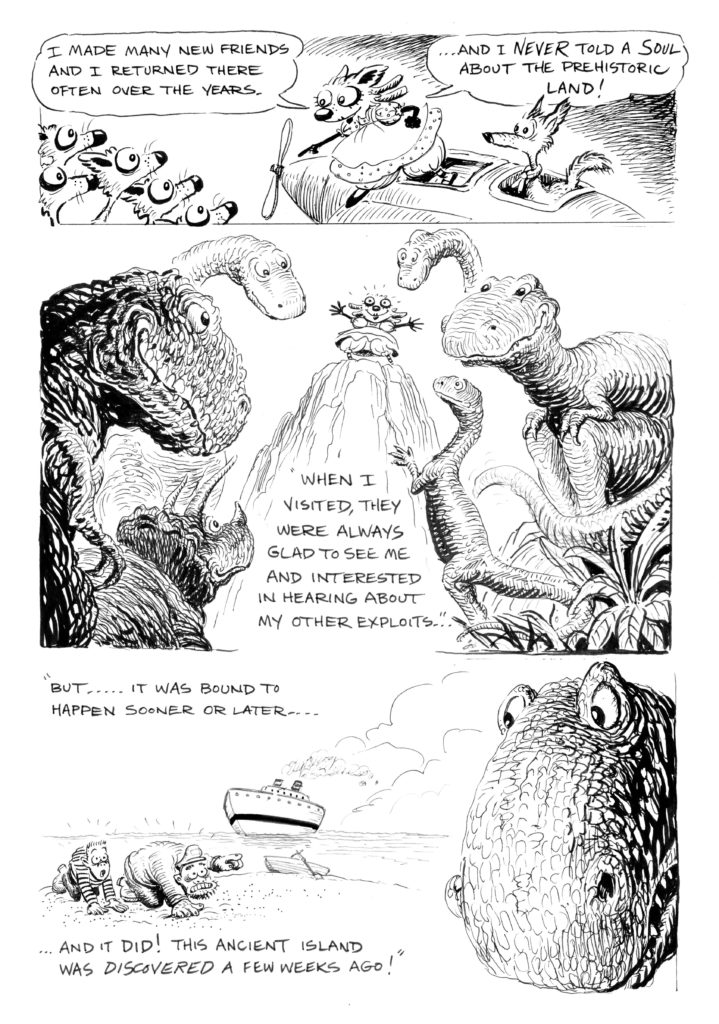
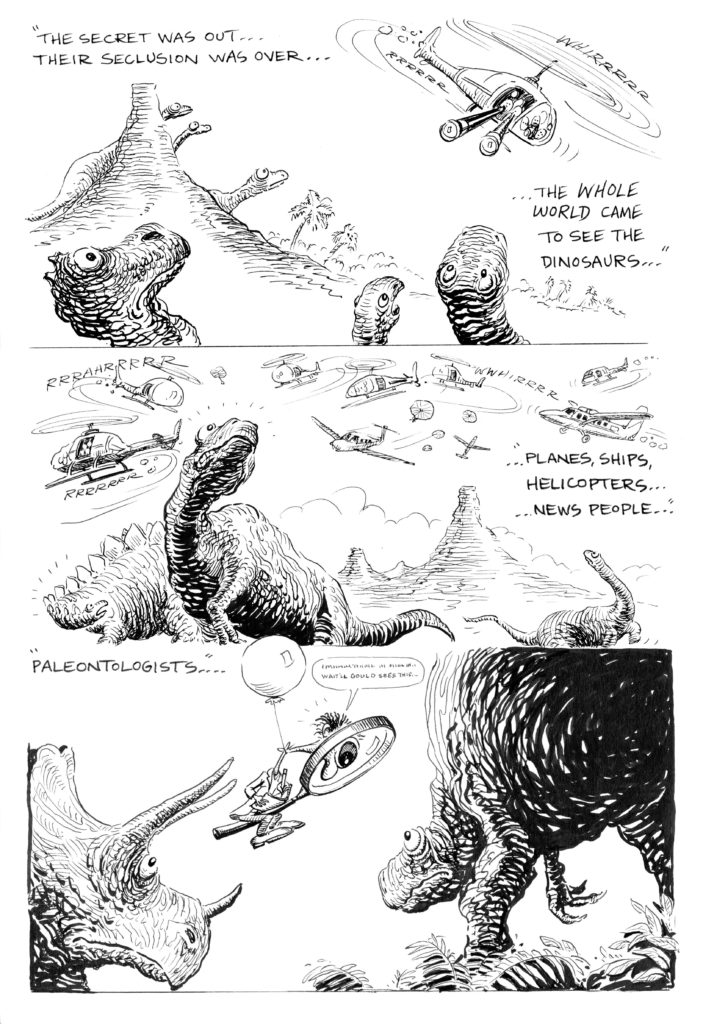

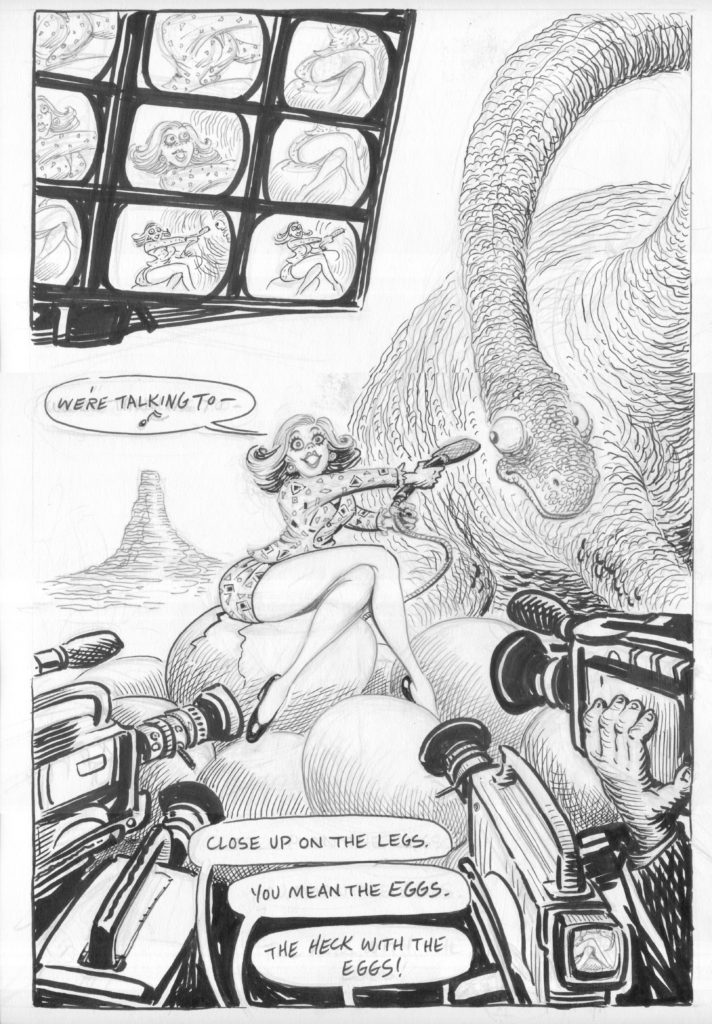
Here’s the third part of Cathy Hill’s epic story: Racketty Ann and The Lost World! In pages 9 through 12, Racketty Ann continues her story (I love how the dinosaurs want to listen to her) of her trips to the prehistoric island. The secret is suddenly out when some sailors land on the beach, and the news media descend in pesky profusion. I love page twelve as the videographers are torn between focusing on the dinosaur eggs or framing the tapering limbs of their pretty newscaster (just look at the monitors at the top of the page to see just how torn the videographers were). Cathy loaded these pages with downshots and upshots of the dinosaurs really highlighting their immense bulk; the shading and variety of the line weight helps the effect. The progression from fine lines in the background to heavy lines in the foreground is most evident in page 12. The little paleontologist on page 10 has a Rube Goldberg touch as he rides through the air astride his magnifying glass with his neck nearly snapped in half by a helium balloon.
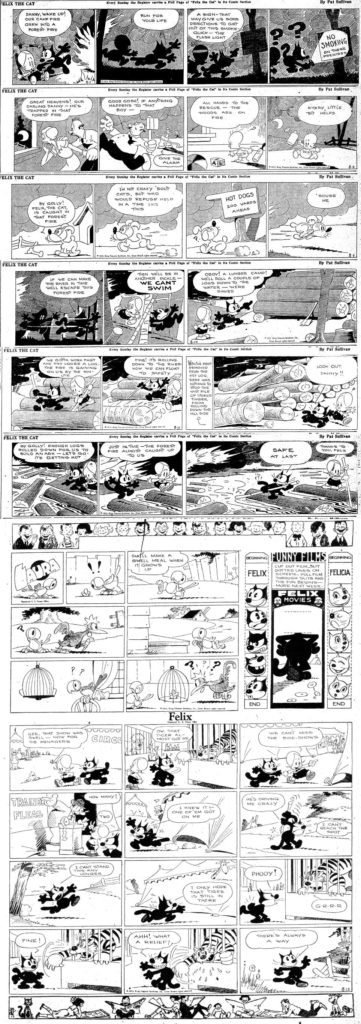
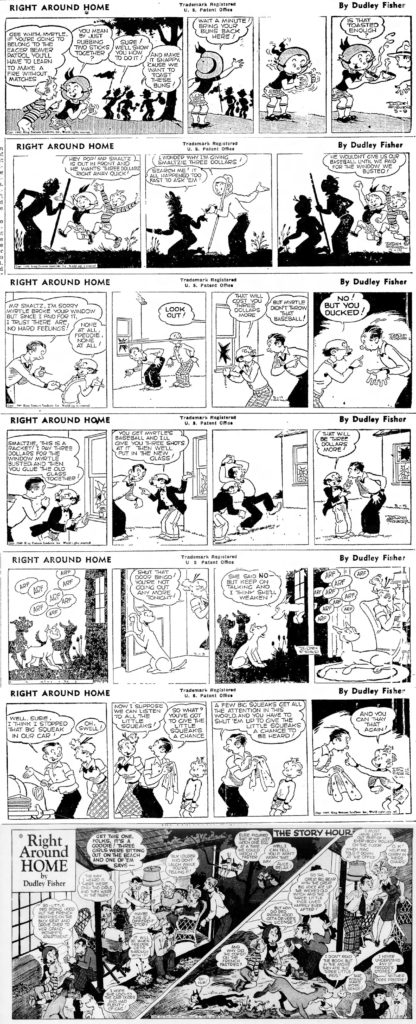

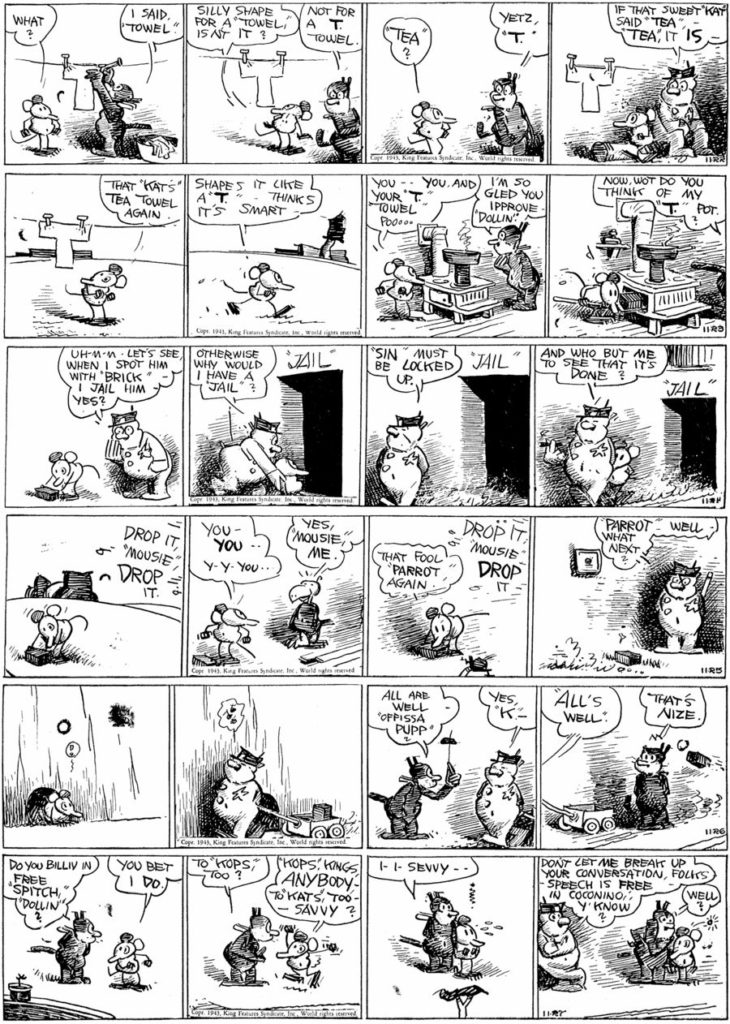
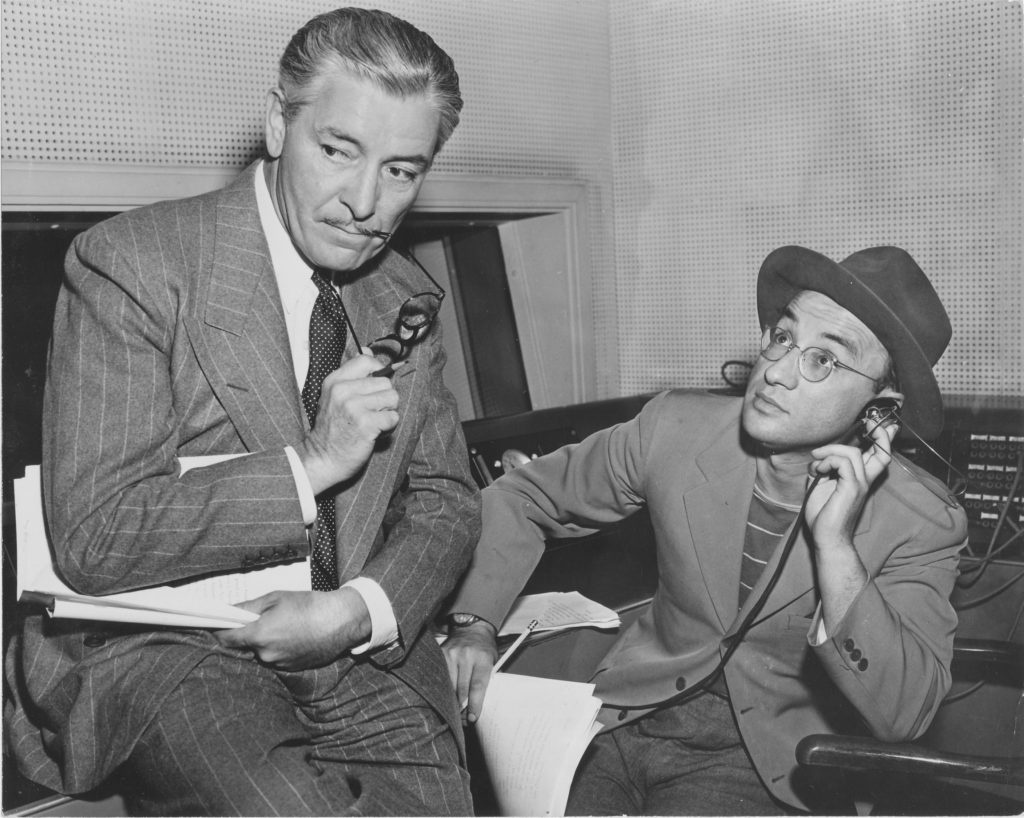
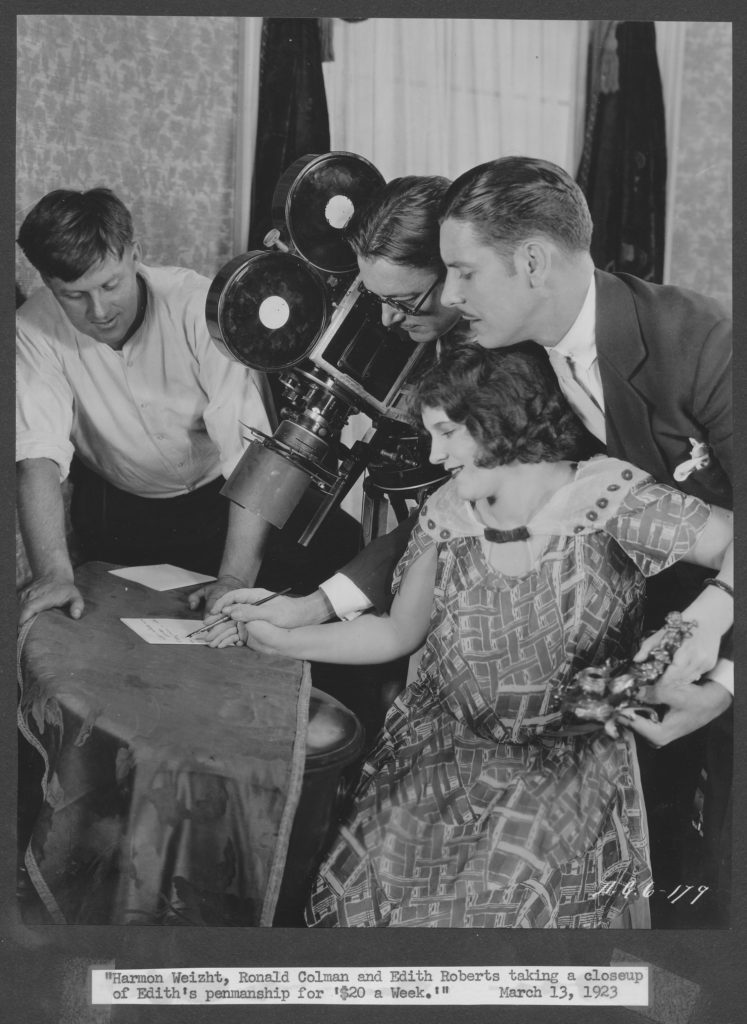
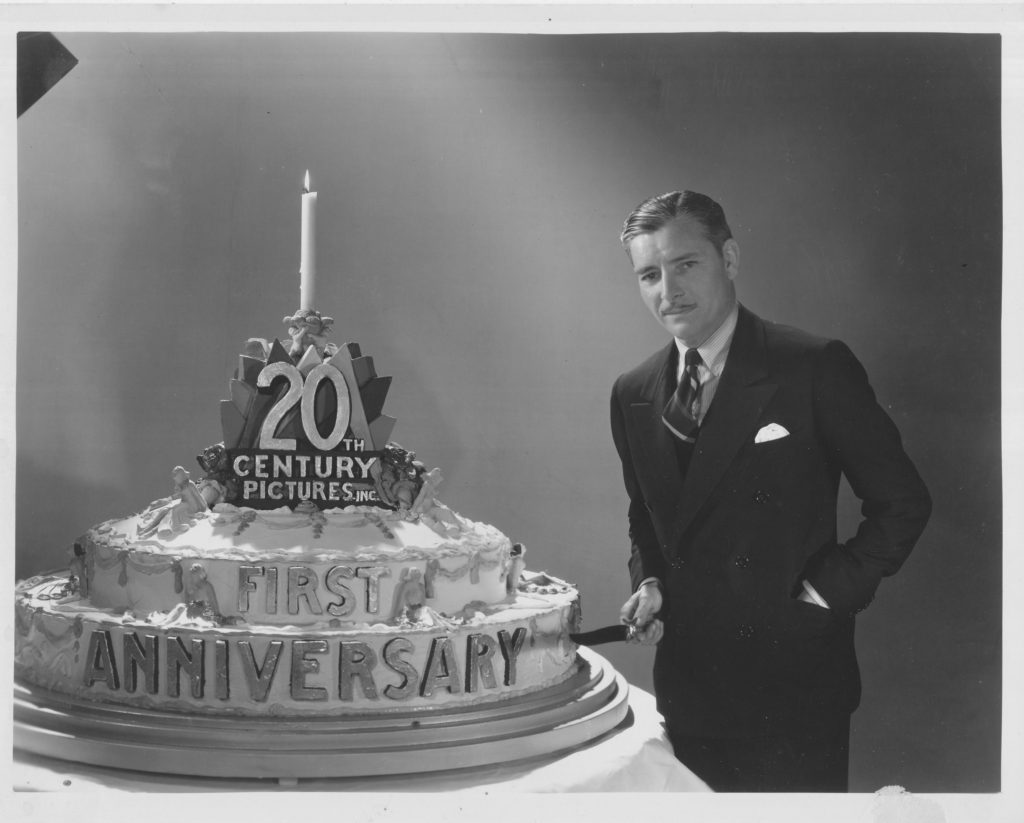
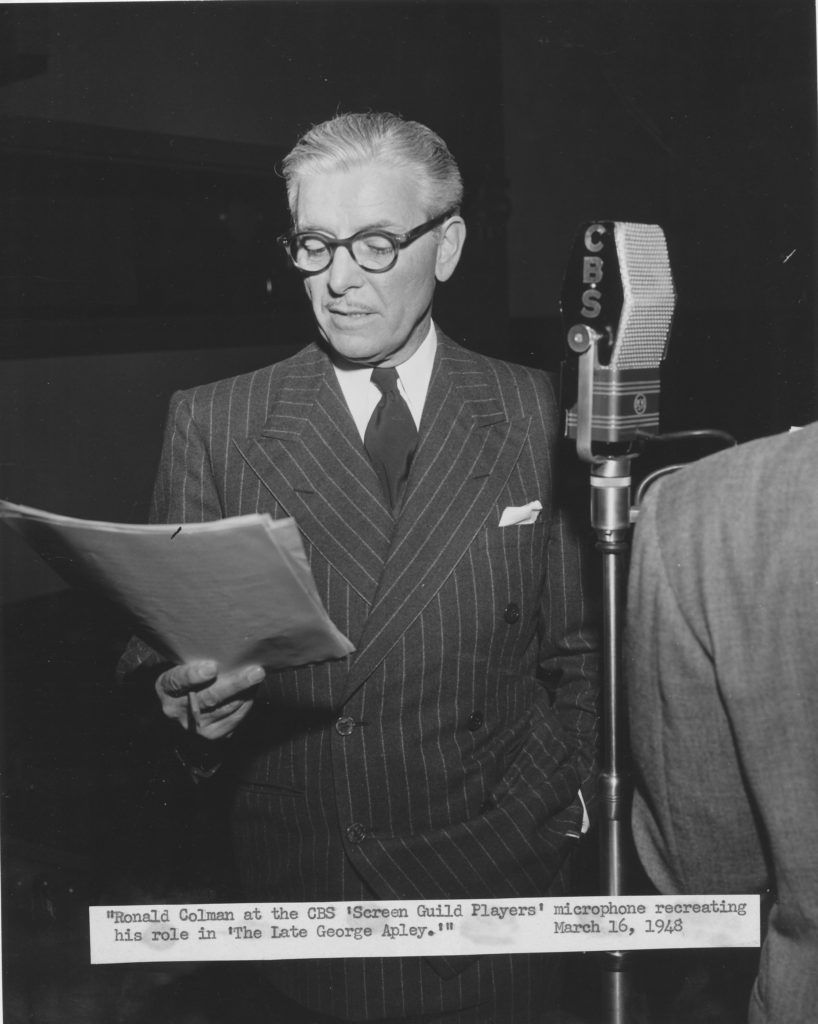
Racketty Ann’s Mystery Flight!
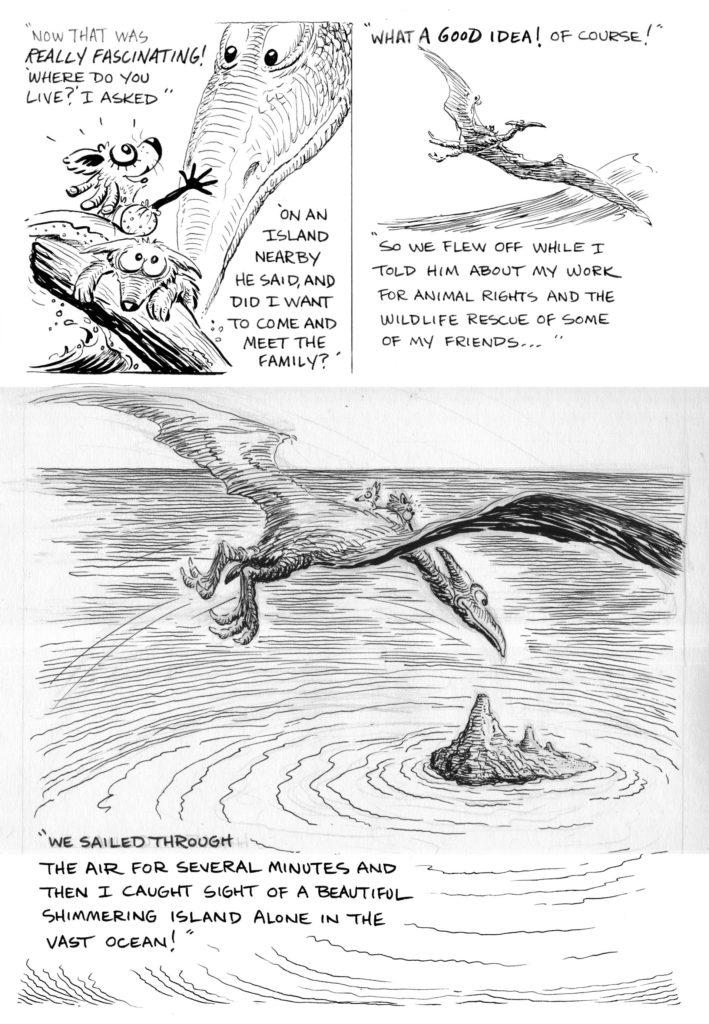
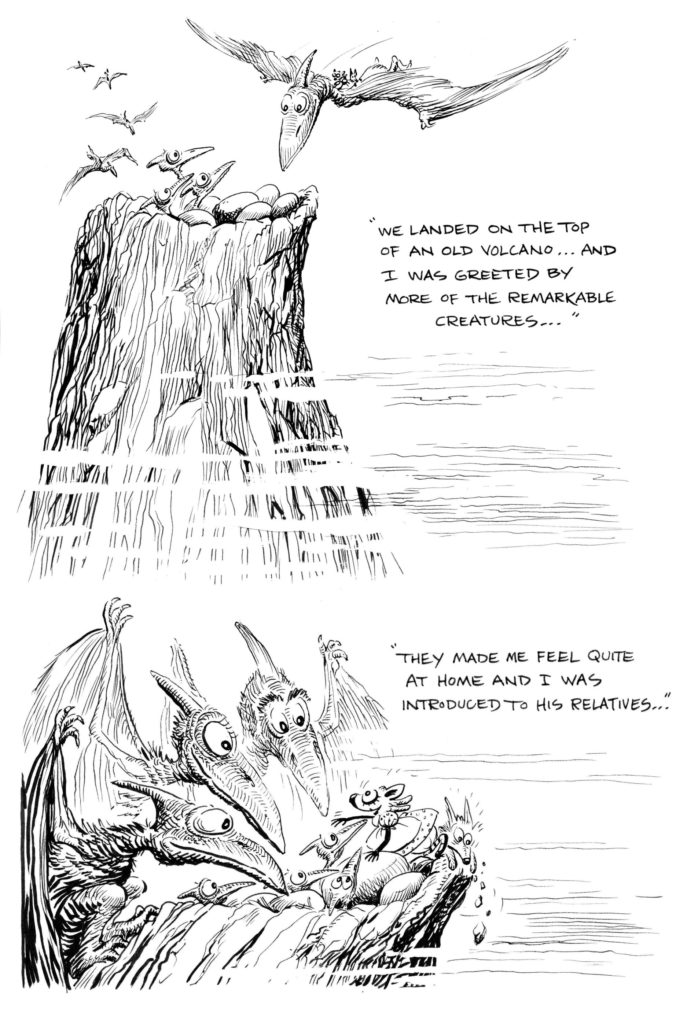
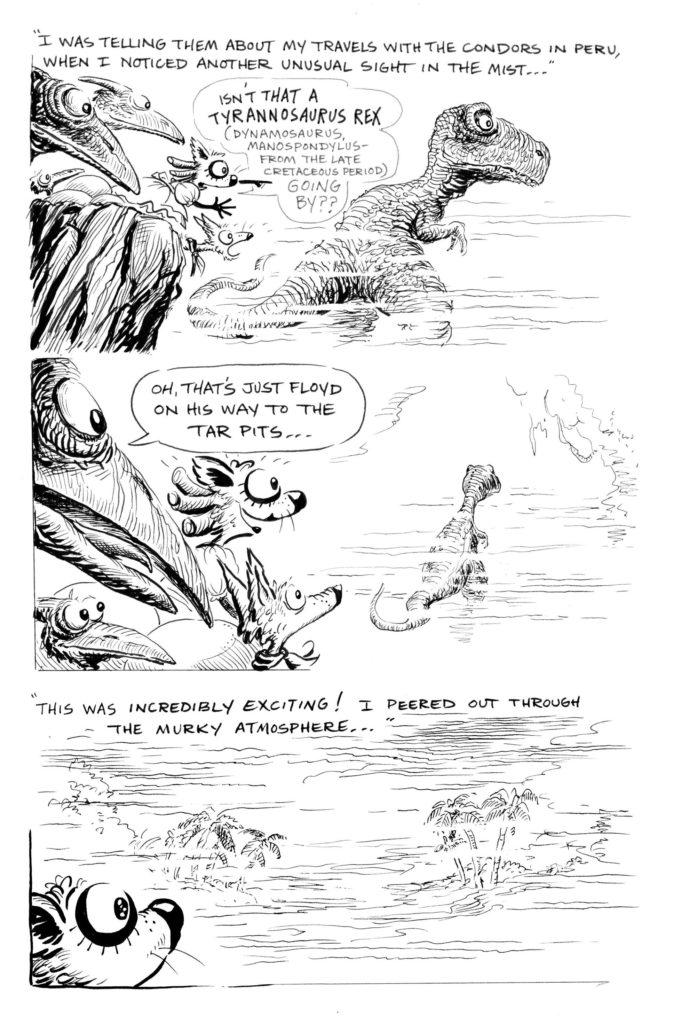
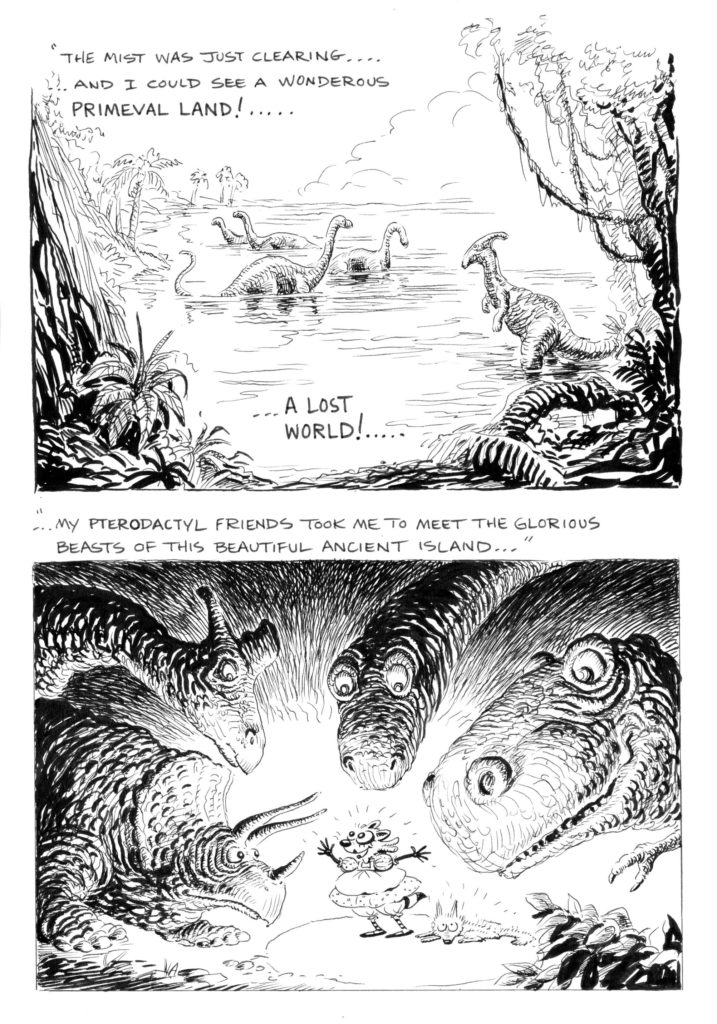

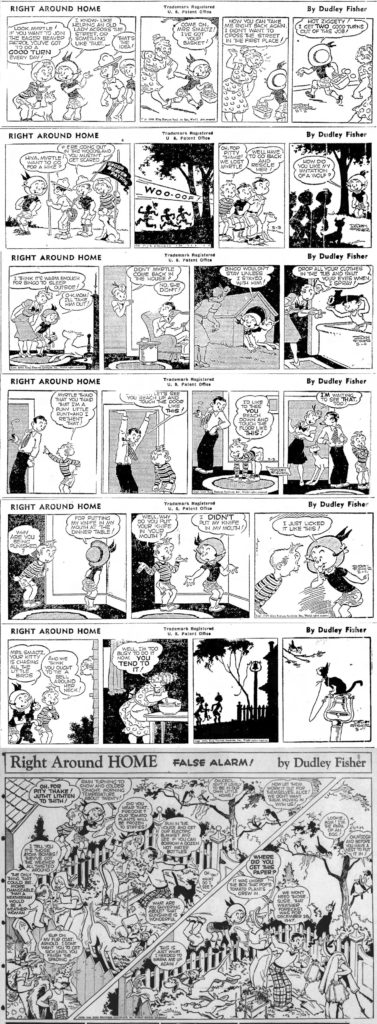
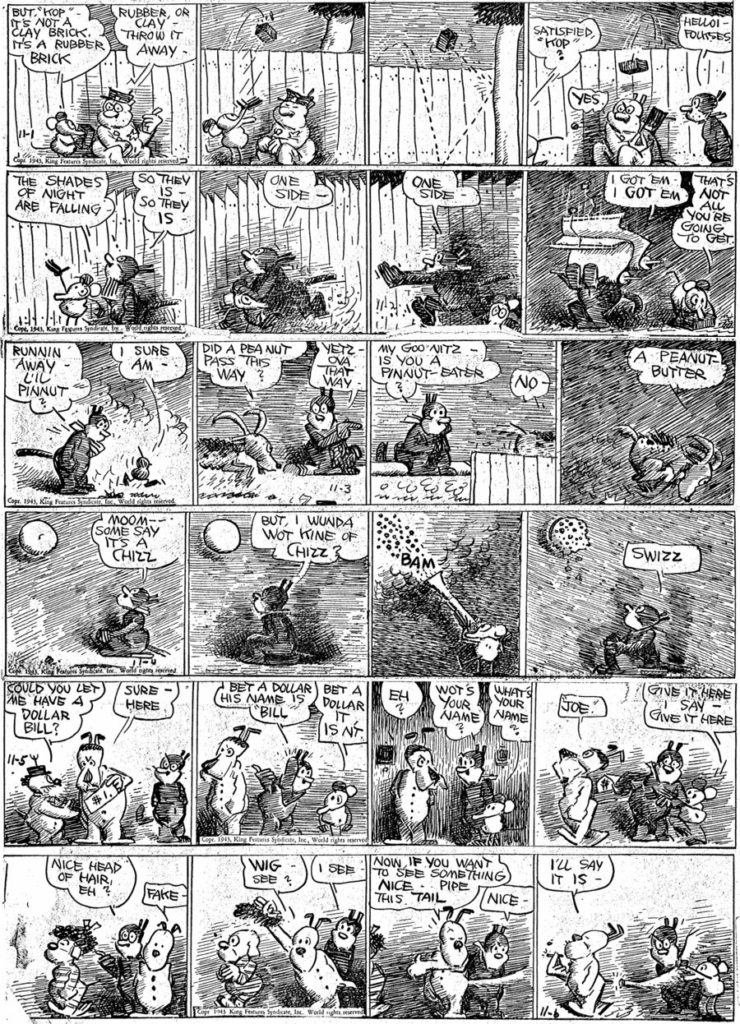
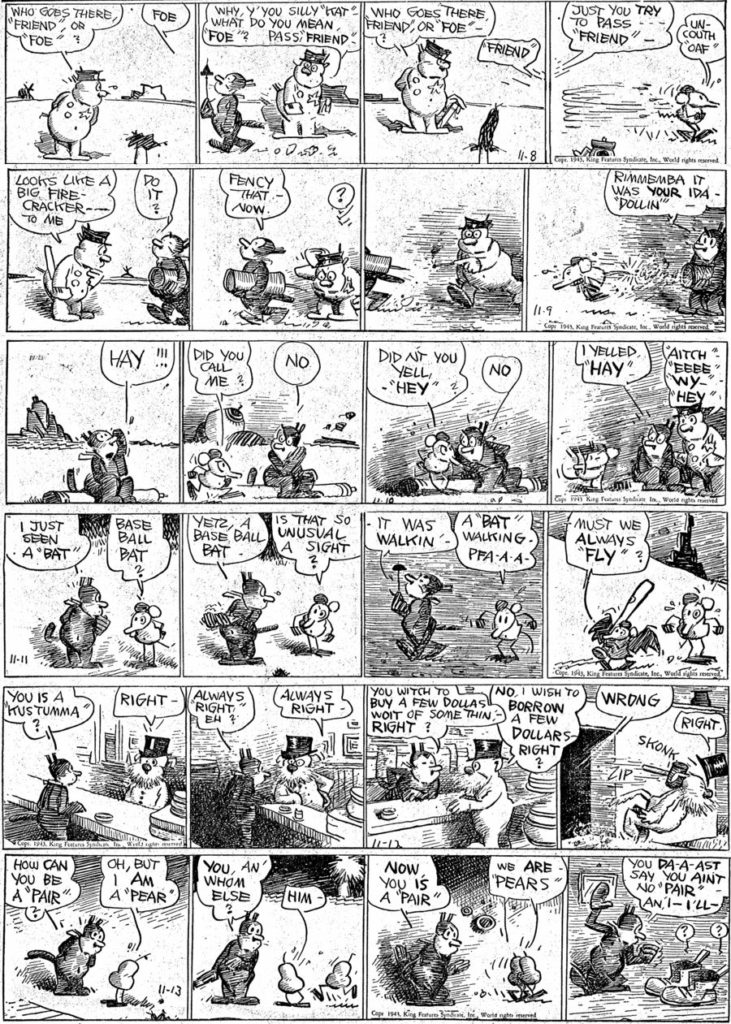

In this installment of the ongoing tribute to my late brother, I present some more Clark Gable rarities from his wonderful collection. This time Gable shaves off his famous moustache as he enters the Army in 1942 in an amateur snapshot never published. Gable eventually entered Officer Candidate School in Florida and below you will find the graduation program and a copy of his address to his graduating class (autographed). Note that it reads something like one of the characters he played in the movies: “Gentlemen, I’m not going to say to you ‘get on the beam’. You’re on it. The job is to stay on the beam until–in victory–we get the command; ‘Fall Out’ “. I can hear his voice as I read the text of this speech.
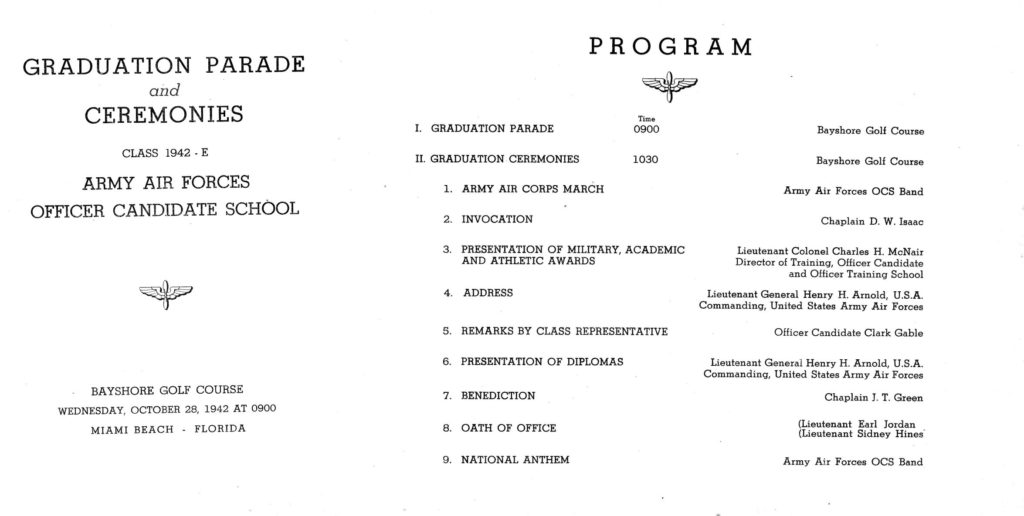
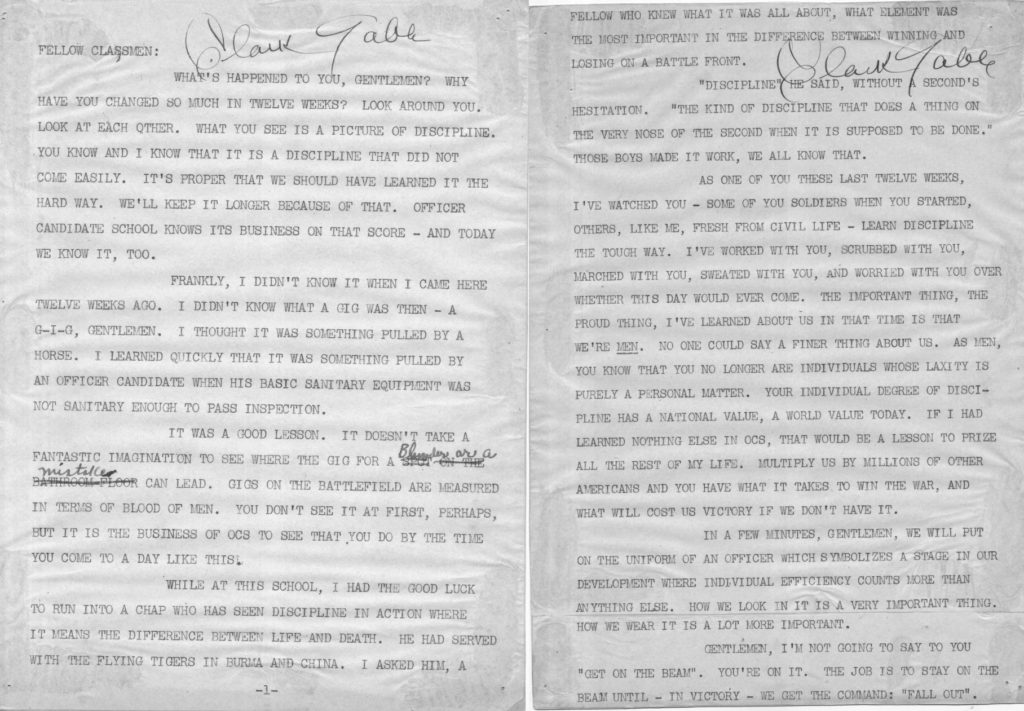
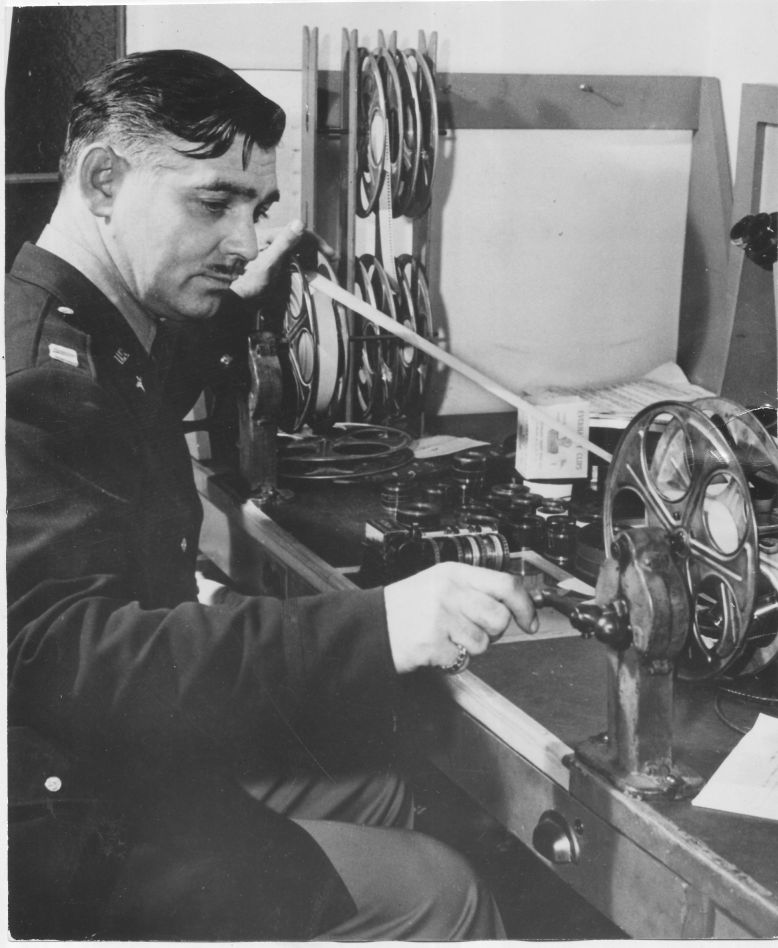
Remember Folks to click on the images with the right button on your mouse. You will see a menu that says “Display image in another window” or “another tab”, or just “View Image. Click on that and you can make the pictures much larger. Thanks for taking the trouble to read the catblog and enjoy the pictures.
Starting Raccketty Ann and the Lost World!
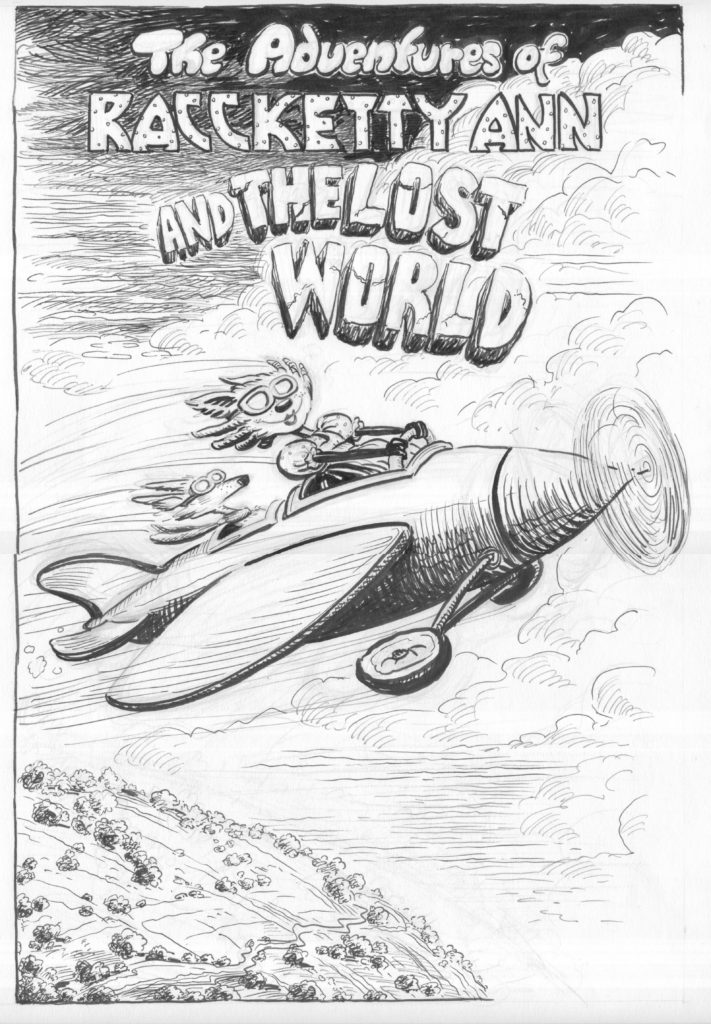
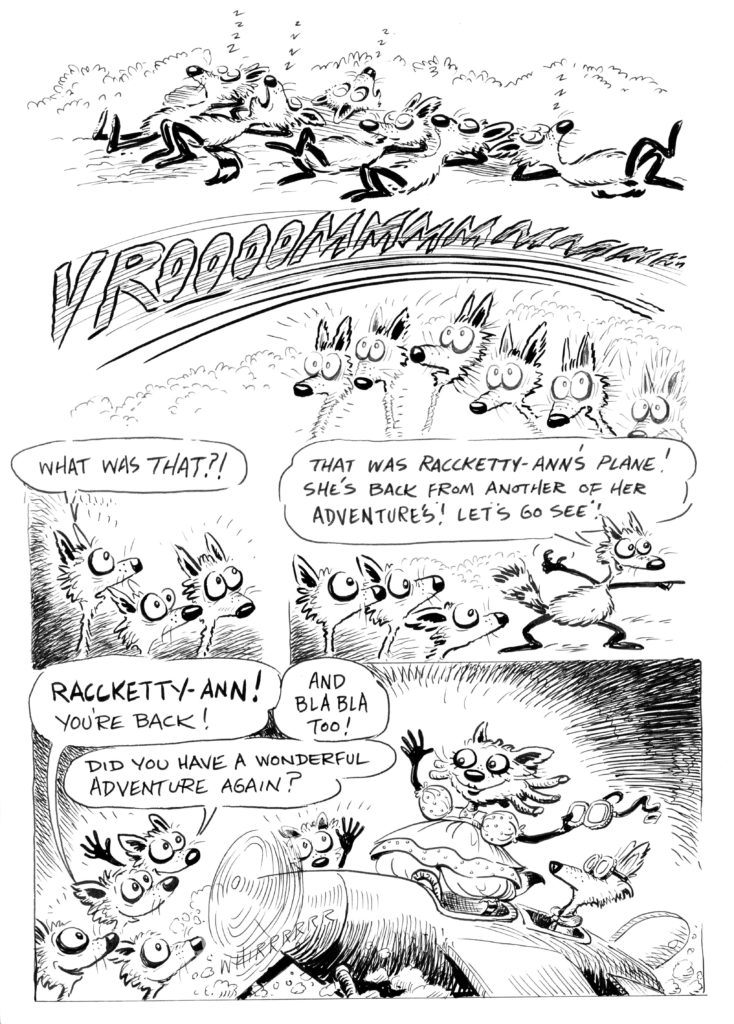
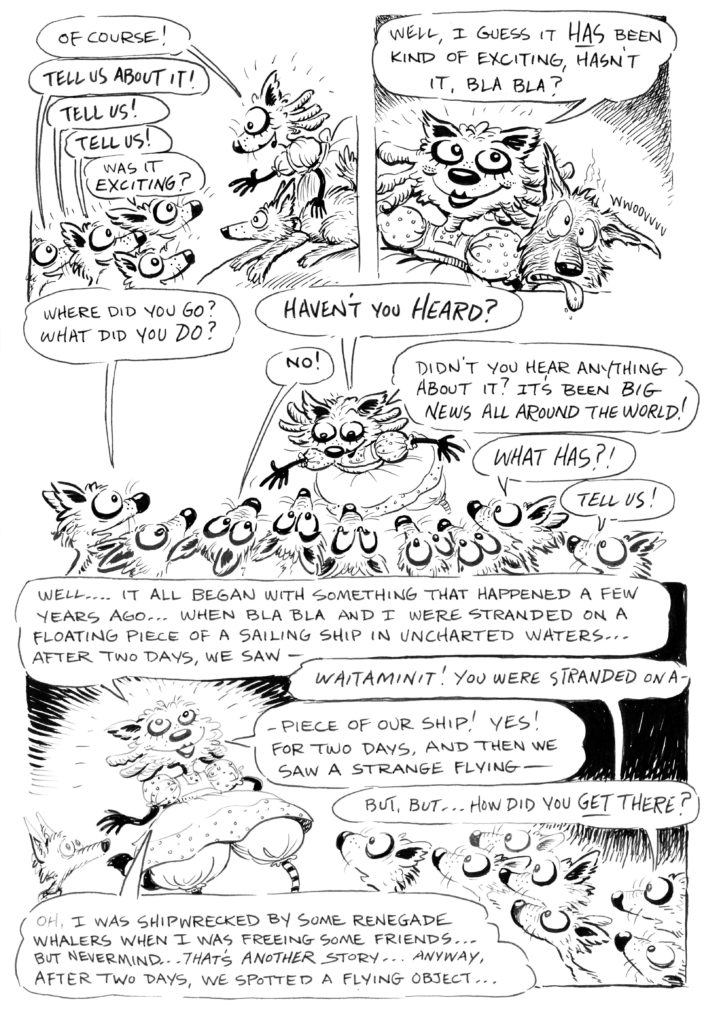
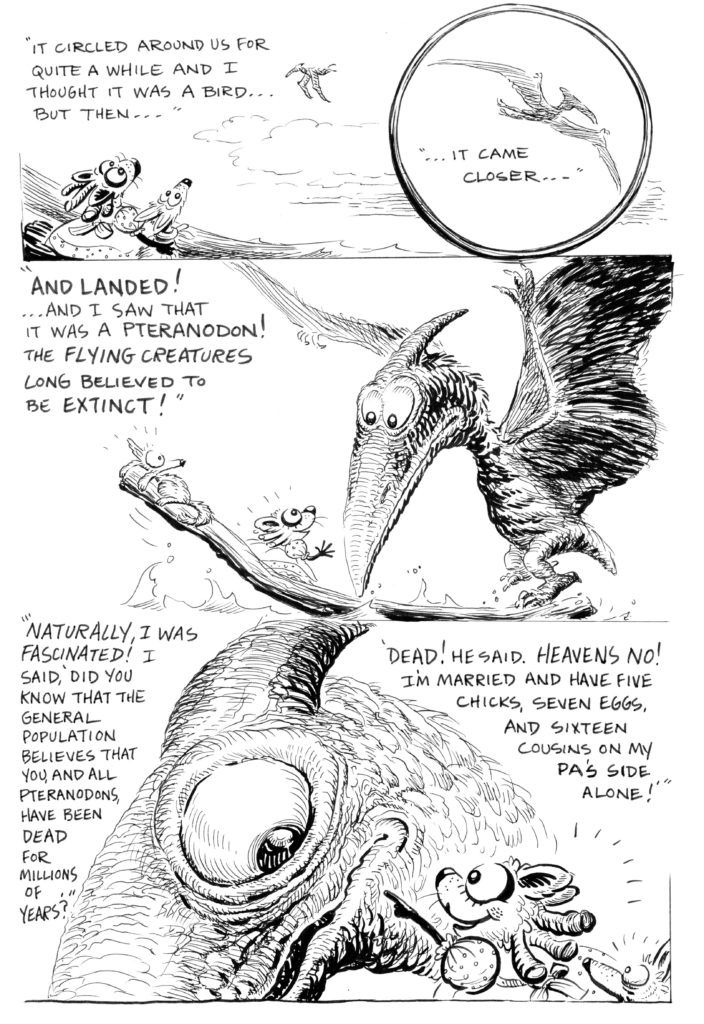
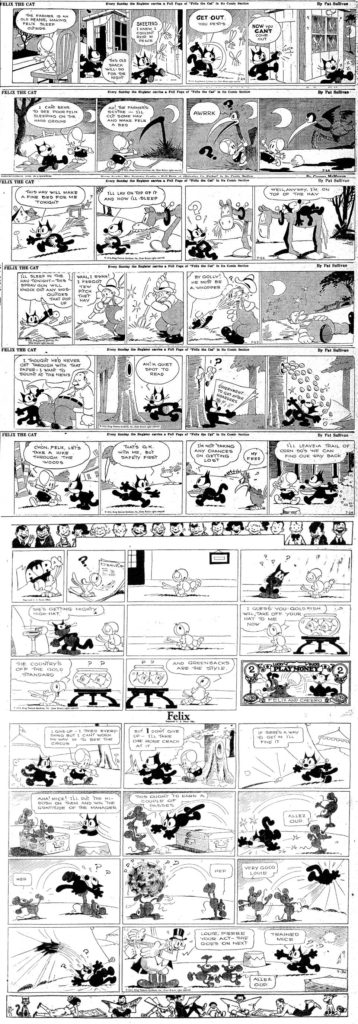
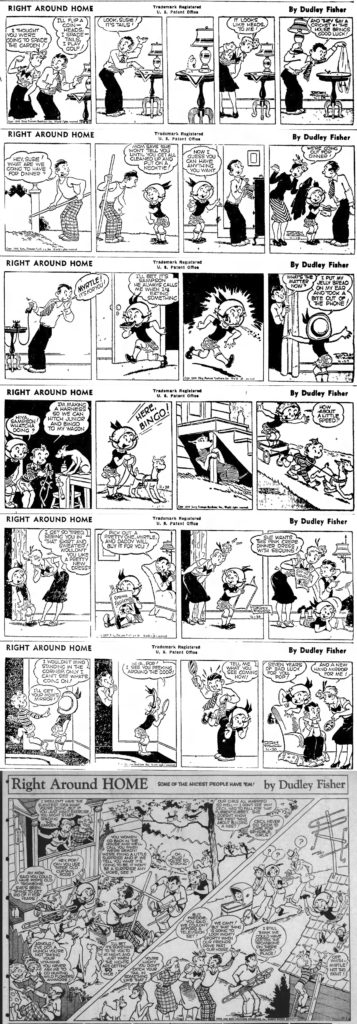
Here’s Myrtle from 4-25 to 4-31-1949. I like the 4-29 and 4-30 dailies as Myrtle’s skirt and sweater are criticized by her mother, and Dad Freddie breaks Mom’s hand mirror as he spanks Myrtle with it. The Sunday page depicts the pioneering days of home TV sets as the neighbors put up makeshift antennas as status symbols even though they don’t yet have the sets to go with them!
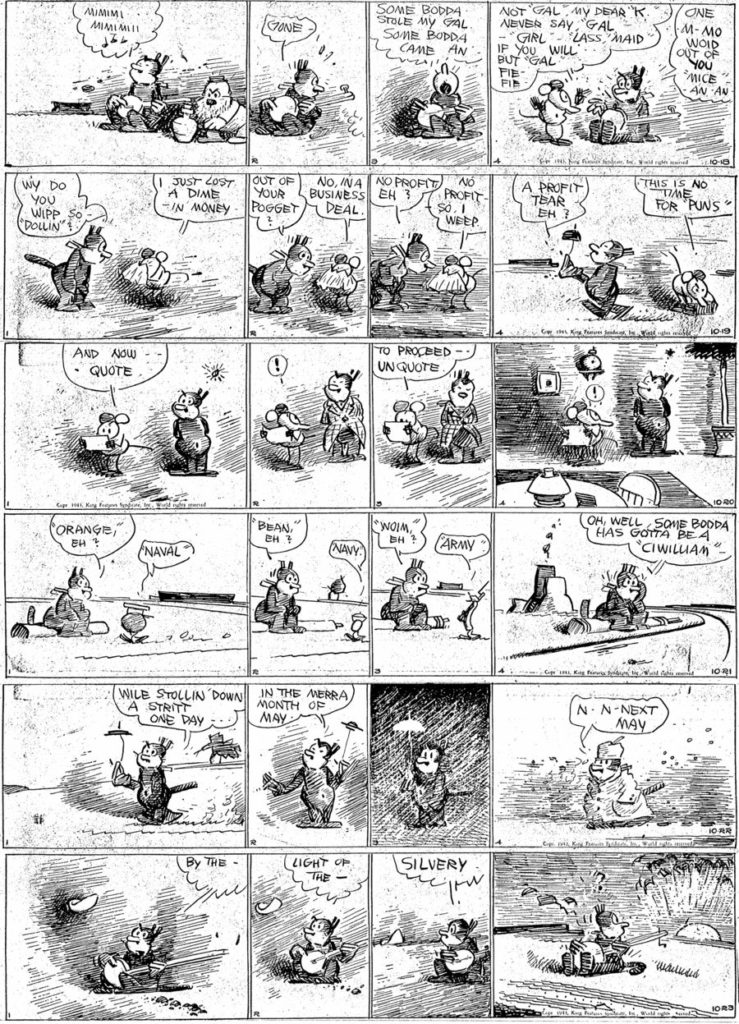
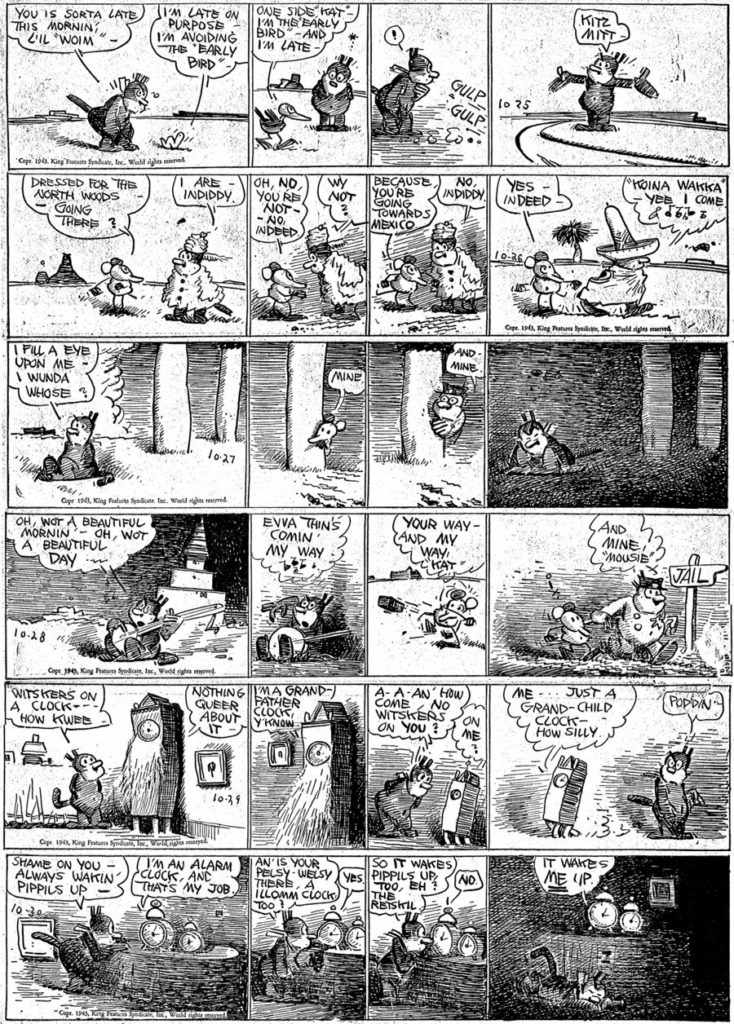
Krazy is from 10-18 to 10-30-1943 this time. World War 2 enters the strip in a subtle way in the 10-21. Herriman was in a mood to cross-hatch in the 10-27 through 10-30 strips. The 10-27 takes on a mysterious feel in the last panel, due to the shading, giving the feel of twilight blanketing Krazy as she peacefully dozes under the gaze of Ignatz and Offissa Pupp. Krazy sings a hit song from “Oklahoma”, a hit musical of the early 1940s, as Ignatz hurls a brick at his head. Clocks play a big part in the 10-29 and 10-30 strips, a grandfather clock in the 10-29 and alarm clocks in the 10-30 as Krazy is once again wrapped in cross-hatched twilight in the last panel.
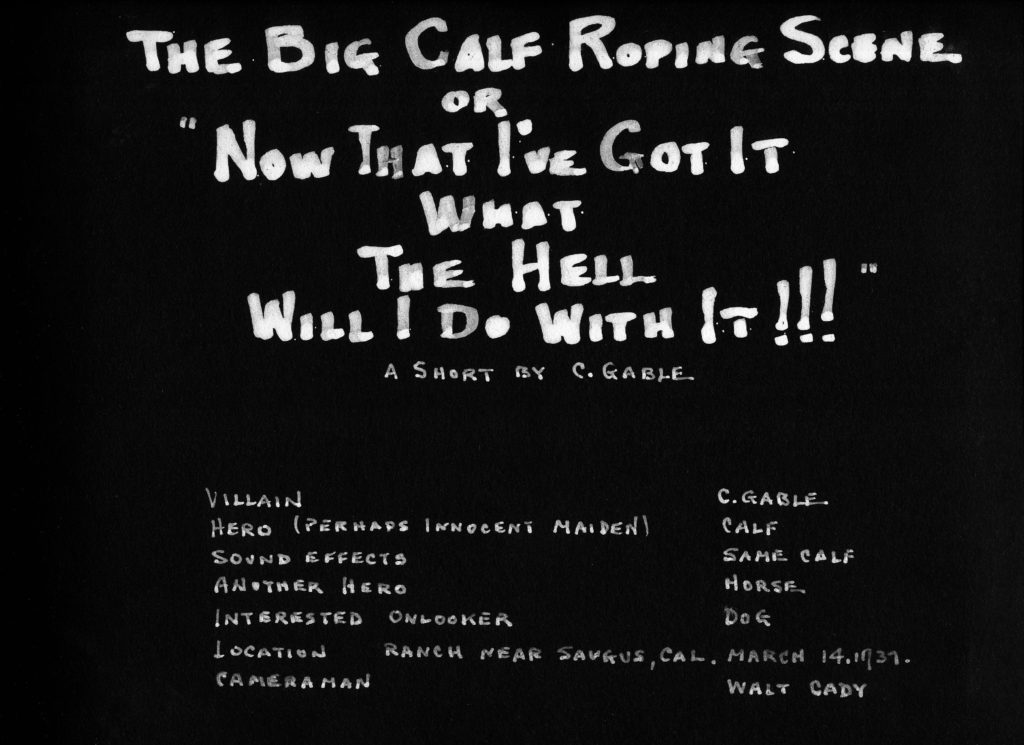
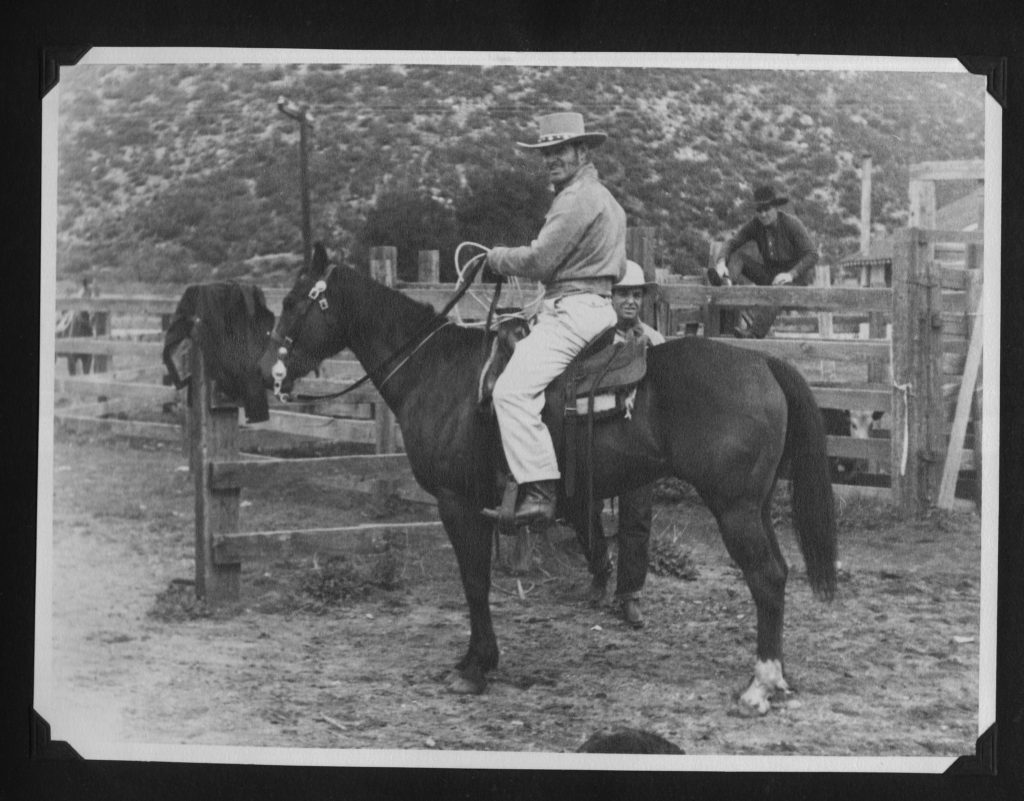
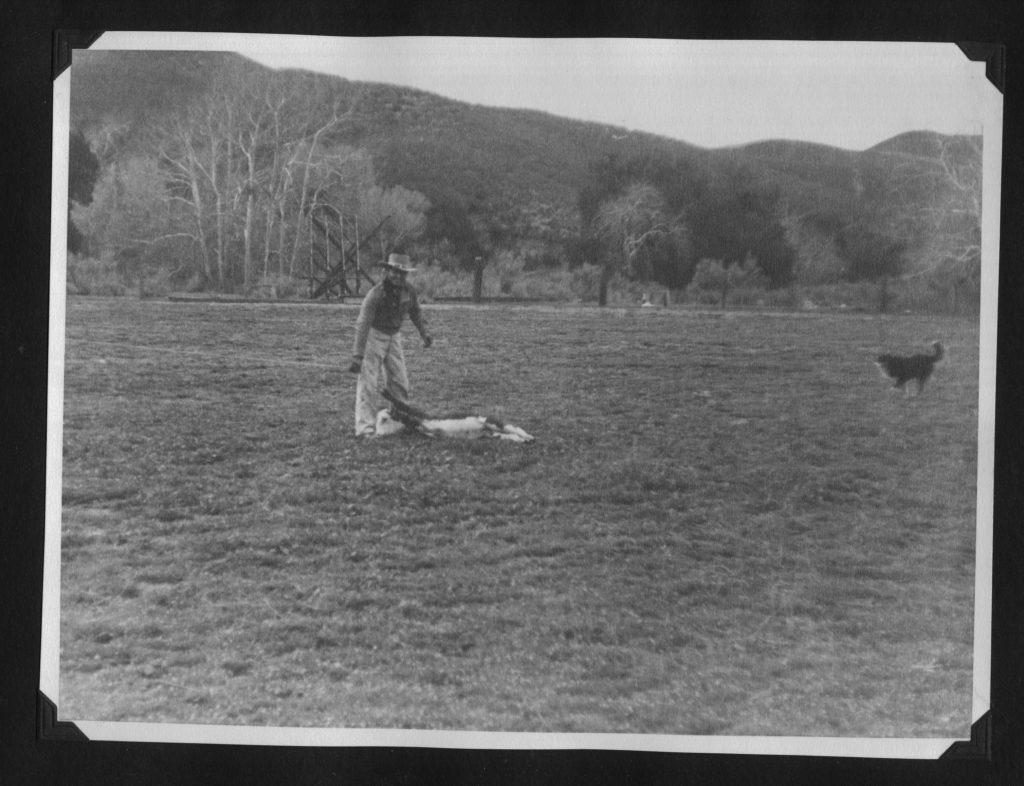
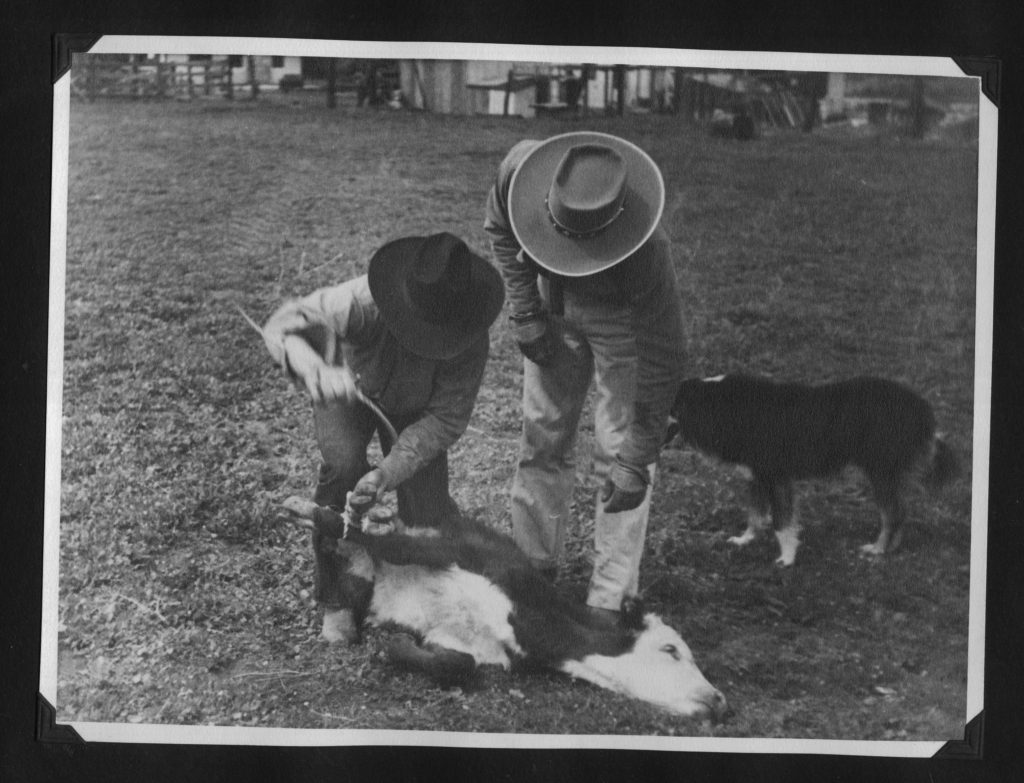
KURT’S CORNER In the corner this time are a collection of very rare stills from my brother’s Clark Gable collection. There are from November of 1937, when Clark was married to Carole Lombard. Gable loved horses and this was probably photographed on his ranch. I like the way he captioned the pictures as a film “Short”, labeling himself as a “Villain” and the Calf and Horse as the “Heroes”. I don’t know who Walt Cady was, who took the pictures. Maybe that’s Mr. Cady helping to brand the calf in the last photo. I have no idea how Kurt came by these rare pieces of Gableana, but aren’t they just fresh off the ranch? Look for more rare photos soon, as my tribute to my sadly missed brother continues.
Cathy Hill’s Racketty-Ann and The Lost World Previews!
Hold on to your seats Folks! More spectacular, funny and heart-warming (not to mention timely) than Galaxy’s Edge! It’s Cathy Hill’s Mad Raccoons in “Racketty-Ann and The Lost World” stealing their way in to the old Catblog in our next post!
As a bonus, here are some of Cathy’s serio-comic dinosaurs in two pages of a book project that wasn’t completed, but you can see for the first time right here. If you like these and want to see more, drop us a line. Thanks for reading the Catblog!
Coming! Raccoons! Soon!
This peculiar Raccoon (Mad variety) was beautifully drawn by Cathy Hill in 1997 to start a sort of “Weird Science” EC vibe in potential “Mad Raccoons” comics. Next post we will start the heretofore unpublished tale “Racketty-Ann and the Lost World”. It’s definitely weird, monstrous and strangely sweet. Watch for it next time!
Felix is from 7-17 to 7-23-1933 this time. Felix is on the farm in the dailies, including Messmer’s trademark cows in the 7-17, which were usually the symbol of sustenance for Felix. The Room and BOARD gag is pretty choice in the 7-18. I like the touch of pathos in the 7-23 Sunday as Felix tears up at Danny’s lack of funds to buy circus passes in the second panel.
Myrtle originally appeared 4-18 to 4-24-49. The dailies really explore Myrtle’s Tomboy side, especially when she loses her braids in the 4-20 and starts to look like a boy. In the 4-21, the boys of the Eager Beaver Patrol all don phony braids to make Myrtle feel included. I love the subtle Fisher touch in the 4-19 as Myrtle pounds the floor in frustration accompanied by her look-alike doll doing the same thing. Myrtle is finally allowed to join the Boy Scout patrol after she pitches a no-hit baseball game for the 3rd Grade team. In the Sunday, Hyacinth the cat makes a rare appearance on top of a fence as Minnie and Slug announce their engagement: Minnie got a job!
Krazy ran in Hearst and other papers from 10-4 to 10-16-1943. Herriman makes a very soft-spoken comment on WW2 in the 10-5 as Krazy declares war on “no budda”. Thanks to Gerd Heinlein, we have one of Garge’s rare elephant strips in the 10-7. I love the drawings of the absent-minded pachyderm as they change proportions and size in each panel. The last panel with the elephant in front of a row of cat-tails is worthy of framing by itself. The 10-18 is one of those incredibly corny puns that Herriman somehow turned into a quiet moment of “Kat” reflection. There’s also a touch of magic in the 10-14 strip as Krazy silently follows a firefly in the Coconino desert only to see it collapse into ashes on the sand.
KURT’S CORNER
My dear brother was a consummant collector of movie stills and memorabilia. He took over the Ronald Colman collection of the late George E. Schatz of Illinois and augmented it with beautiful original and rare material that he collected over more than 40 years. He also collected on Clark Gable and Carole Lombard, Vivien Leigh and many other actors. His huge collection was carefully tucked into loose-leaf three-ring binders, each one immense and thick. Every still was in special plastic punched sheets that make it easy to remove and replace the stills from each binder. Here are three very rare stills from the Colman files:
The lovely Benita Hume around 1926. She was doing a bit of acting in British cinema such as “The Happy Ending” (1925) in which she played “Miss Moon” and “The Lady Of The Lake”(1928) which gave her the title role. She became Mr. Colman’s second wife and co-starred with him on the Jack Benny Program and The Halls of Ivy on radio. In the Halls of Ivy, her character Victoria often does a bit of music hall singing and tap dancing. The Halls of Ivy ran from 1950 to 1952 and was written by Don Quinn who wrote for Jim and Marian Jordan and created the character of Throckmorton P. Gildersleeve on the old Fibber Magee and Molly radio show. The Halls of Ivy was very classy and incredibly gentle comedy, the theme song sounds a bit reverent, like the “Whiffenpoof Song”.
Here’s a rare still of Benita and Ronald Colman rehearsing with the radio maestro and Angel of Comedy, Jack Benny in April of 1948. Jack loved being the object of the Colman’s scorn, he constantly irritated them by borrowing every tool and kitchen appliance they had. Jack lived next door to the Colmans in “radio land”, and even borrowed Colman’s Oscar which R.C. won for “A Double Life” in 1947. Jack promptly was robbed of the Oscar on his way home with it by a gangster played by Eddie Marr (info provided by Don Yowp).
It’s hard to recognize Mr. Colman in 1921, when he first came to the United States from his native England to tour in the stage play “The Dauntless Three” and hadn’t yet grown his trademark mustache. He eventually used a grease paint mustache for early silent film parts, such as “The White Sister’ (1923), before he grew his own. Ronald Colman’s speaking voice was just about my brother’s favorite sound in the world. Kurt prized wisdom and gentleness in actors and writers, such as Colman and James Hilton. The great Frank Capra picture “Lost Horizon” combined Colman and Hilton in one of my brother’s all-time favorite movies. Kurt’s incredible collection of stills is with me now, but will soon join the archives of the Margaret Herrick library at the Motion Picture Academy. Kurt and I often discussed his collection’s eventual “home” and soon they will be going there. Over the next several posts, Kurt’s Corner will feature more rare and unusual bits of cinematic curios. I hope you will look at them and celebrate the love of movies that was such a major part of my brother’s life and dear to his heart.
The Meaning of Life
Here at last are the four concluding pages of “Raccoons On The Moon”, or, as the Windsongs of Jupiter prefer to call it: “The Raccoons Search For The Meaning Of Life”. The Windsongs of Jupiter are real sticklers for accuracy, since the Raccoons spent only one page of their story on the Moon, the Windsongs want the story retitled so that “True Truth” will be proclaimed and the Raccoons will be worthy of knowing the Meaning of Life. The Windsongs’ definition of the Meaning of Life on page 19 is a real “Shaggy Raccoon” argument, leaving the masked Space Explorers dumbfounded. Note the mixture of expressions in page 19’s second panel as the Raccoons either stare at the reader, or furtively glance at each other. I love Cathy’s timing as page 20 leads off with Virgil saying: “Well, THAT was FUN!” It adds irony to the story’s finish as the Raccoons return to the Moon’s surface. I hope you liked Cathy Hill’s Mad Raccoons and that you will look forward to another one of their unpublished stories coming soon to the Catblog.
Felix this time originally appeared in newspapers from 7-10 through 7-16-1933. Felix and Danny conclude their “midget league” baseball season, and Danny’s family go off on a summer vacation without Felix. I love the poignant panels in the 7-14 as Felix contemplates a lonely summer without the family. Danny comes back home to pick up Felix and packs him in a bag to smuggle him in to the boarding house where the family is lodging. The Sunday page features Danny and Felix watering an Elephant to earn Circus passes. The Elephant is dry as the Mojave and drinks the landscape to the sandy dregs.Â
Here’s Dudley Fisher’s Myrtle from 4-11 to 4-17-1949. All the dailies are devoted to “Wilbur”, the family’s wacky goldfish. Wilbur doesn’t get along with anybody, not Sampson, Myrtle’s Pop, Slug or the local bird family. The 4-16 has the best Fisher timing of the week, since goldfish are “harder to give away than kittens”, Pop dumps poor Wilbur in the river. A panel later there is a knock at the door, and Wilbur comes bouncing in! The Sunday page is the usual visual feast as the family dusts the household carpet for spring cleaning.
The Kat this time is from 9-20 to 10-2-1943. The first batch is mostly odd gags, but the 9-24 and 9-25 refer to Brazil, which was a hot topic during World War Two, what with the Good Neighbor Policy being in effect and all. But what is that creature in the 9-25 with the head of Krazy Kat and the body of a spotted cat? It is a species of Brazilian wildcat called “Oncilla”, “tigrillo” or “tigrinas” depending on which part of the country they come from. They are smaller than a Margay, which is a pretty small wildcat. Garge must have been a student of cats worldwide, both wild and domesticated, to come up with a gag like this one. In the 9-27 to 10-2 batch, the gags are all about plants and flowers, such as a shrinking violet that throws stones at Krazy’s “bean” and a sunflower that rises and sets and says “Bong Swar” to Krazy. But the most obscure reference is to the tomato (or “to-mah-to”) as a “Love Apple”. “Love Apple” is derived from the Italian word for tomato, “pomodoro”, which the French freely translated as “pomme d’amour” or “Love Apple” in English. The “to-mah-to” is a reference to the Fred Astaire 1937 movie “Shall We Dance” and the song “Let’s Call The Whole Thing Off” (you say ‘tomato’ and I say ‘tomahto’). Maybe Garge liked that movie and built the 10-2 gag around the song?
KURT’S CORNERÂ Â Â Here’s another little remembrance of my dear brother Kurt, who passed away in January. That’s us in the faded and worn photograph of 1956. Probably taken in the backyard of our family house in Crestwood, Mo. 701 Hutchins Drive. The house is still there today, I wonder if that tree is still there? The Mickey Mouse Club TV show was a never-missed event every weekday afternoon, and we had all the gear, Mickey ears, shirts and Kurt is playing a Mouse Ge-Tar. The photo looks blue because it was faded nearly pink and I flipped the color so you could see it better. You can tell that Kurt had a very irreverent attitude from a very early age. He is obviously “Putting It On” as you can tell by the little sneer on his face and the sassy tilt to his head. Even his fingers have attitude as he strums a guitar that was really a wind-up music box. It seemed the entire neighborhood of kids came in to our living room each afternoon to watch the Mouse Club with us. We must have had one of the few TV sets, and poor Mom had to serve beverages and cookies to the hungry little Mouse Clubbers. We all loved Annette and thought that Jimmy Dodd was like a minister with his little aphorisms in song form. Of course they built Jimmy a REAL Mouse Ge-Tar full size! But my favorite feature of the Club was the old black and white Mickey Mouse cartoons. For some reason they fed in to Kurt’s and my fascination with everything “old” and “antique”. We were fascinated by the very primitive and bottle-nosed Mouse that was in the old cartoons. I guess the Disney Studio wasn’t concerned with the original dotted eyes Mickey appearing alongside the exceedingly cute and almost child like Mouse that headlined the Club TV shows each day. We used to have fights over which of our toys was the oldest, and sometimes even such things as spoons and salt shakers entered into the “antique” debate. Disney dominated our lives in the late 1950s, we both had Davy Crockett hats and Kurt and I were Civil War buffs so “The Great Locomotive Chase” really excited our imaginations. Fess Parker traded in his Crockett hat for an engineer’s cap in that one.
Last time I posted one of Kurt’s “Mickey Mark” cartoon drawings which I believed to be the last one he ever drew. I was wrong, the one reproduced here is really the last, he sent it with the 2018 Christmas card. It’s a celebration of Mickey’s 90th anniversary. I love Kurt’s caption as he refers to the Mouse being a “corporate symbol, a pawn of copyright extension (just look up the Sonny Bono Copyright Act), a union busting rodent (probably a reference to the Disney strike of 1941)”. I don’t know what the little female mouse means by “Sparta-Mouse”, although it might be a misspelling of “Spatha Mouse”, a special computer mouse for gamers. But “you have delusions of grandeur” was a favorite phrase of our Mother, whenever Kurt or I got too ambitious and dreamed too big for her taste. She probably got the phrase “delusions of grandeur” from a psychology book or newspaper article and took it to heart. For some reason, neither Kurt nor I ever forgot that phrase or Mom’s use of it at times when we could have used a word or two of encouragement.Â
I wish I could have talked about Kurt’s last Mickey Mark cartoon with him, but what turned out to be our last telephone conversation was filled with the usual nonsense and Kurt’s sidesplitting and VERY irreverent imitations of Linda, his girlfriend of many years. Kurt really did love her, but he also loved to make fun of her, as he made endless fun of Mom and our Grandma Katie. I can’t begin to tell you how much I would give to hear him do his “fussy female” voice one more time. Perhaps there will be more Kurt’s Corner features in our next edition. Many Meows until then.
The Old Dirty Snowball
Here is the fourth episode of Cathy Hill’s Mad Raccoons in “Raccoons On The Moon”. In the last episode, the Raccoons visited Mons Olympus crater on Mars and visited the lonely old lava, bubbling over with attempted jokes. In their search for the Meaning Of Life, Mons was very little help, so the Racc-it ship ventured over to Titan, one of the moons of Saturn and intercepted Halley’s Comet. The Old Dirty Snowball didn’t have any clues to the Meaning Of Life either, he didn’t take Life seriously enough to be helpful. He tosses the Raccoons another clue: the Meaning Of Life is known by the Windsongs of Neptune, on the Singing Plains of Neptune. So we leave the Silver Masked Tenors (Raccoons) on the Singing Plains until the concluding episode, next time. I love the drawing and delicate ink lines as Halley’s comet zooms through space, spats and all, and the Windsongs of Neptune speak in beautifully lettered words, resting on musical staffs. You can imagine the haunting sounds of their speech, as if in an astral echo chamber with John Cage tunes bouncing about.
Here’s Felix from 7-3 to 7-9-1933. Felix is still the mascot of Danny Dooit’s team, the Midget Giants, but the team keeps racking up goose eggs, sometimes in the form of donuts. Felix is convinced he’s a jinx and a flop as a mascot, so he tries to talk Bill the Goat into taking his place. But Bill refuses, saying “All the games are lost, now you want me to be the GOAT!” In the Sunday, Felix blows soap bubbles with Mr. Dooit’s pipe to amuse Danny’s baby brother. Felix barely manages to keep out of Papa’s way as he’s still blowing bubbles in the last panel. This strip could have been the basis for an animated cartoon story, lots of chances for bubble effects.
Myrtle is from 4-4 to 4-10-1949 this time. I like the continuity of the 4-4 through 4-6 dailies as Sampson tries to play his harmonica to amuse Myrtle’s Dad, Freddie. The 4-8 is a good gag with Bingo hitting up the Dog Pound for a snack, but the 4-9 is my favorite gag of the batch, as Myrtle puts on makeup for school and the teacher, Miss Flunkem is so impressed that instead of punishing Myrtle, she runs back to Susie’s house to ask Myrtle’s mom where she got the beautiful shade of lipstick! The Sunday has the usual inventive staging as Freddie tries to rescue Sampson’s kite from the top of a spindly tree. I like the little touch in the second panel as we just barely glimpse the neighbor’s shoe in the upper right corner, clinging to the roof.
Krazy’s dailies this week are from 9-6 to 9-13-1943. Garge was thinking of Kate Smith and her theme song (“When the Moon Comes Over The Mountain”) in the 9-6 to 9-8. I love the drawing of the Moon squeezing under the mountain in the 9-6. Garge gets a little obscure in the 9-10 and 9-11 strips as Ignatz mixes Krazy up with pronouns in the tree top and a little Scotty dog puts a lamp chimney over his pipe (for economy?). The 9-13 strip, in which the Kat sings, from the old song “Father, Dear Father Come Home With Me Now”: “The Clog in the Stipple strikes ‘One'” shows Herriman’s technique of scratching into the ink in the last panel, to create the white line of Ignatz’s tail. The 9-14 is pretty obscure as Garge refers to Russian pianists, as Pupp refers to himself as “Jasha Puppsha” and then runs off exclaiming “Ooy, Tchin-Dee!!!”, frightened as Ignatz emerges from the top of the piano. In the 9-16, Krazy seems to speak “Ettskimmo”. In the 9-17 Ignatz plays the bars of his Jail cell like a harp, and in the 9-18, Krazy trips up over sound-alike words as he confuses “Cane” with “Kane”.
KURT KAUSLER R.I.P. My readers and friends, it’s very hard to tell you that my younger brother, Kurt, passed away on January 24th, 2019 in St. Louis, Missouri in front of his fireplace–his bulldog Gracie at his side. He lived to be 67. His dear girlfriend Linda discovered him there at about 8:30 AM, having left him at his house the previous evening at about 6PM. You can see by the photo above, taken about 1958, that Kurt and I were an odd couple of brothers. We may have been some of the “original geeks”–very fond of history, books, comic books and animated cartoons among many other things. We used to fight each other a lot as kids, inspired (to my Mother’s horror) by the Popeye cartoons shown on the local St. Louis TV program: “Cookie and the Captain”. Most of the fights ended when I sat on poor Kurt, being heavier than he was. Kurt was of a more serious turn of mind than I was. As you can tell from the photo. Look at his natty outfit, and look at my wrinkled, dirty pants with the soiled knees. I probably had Pinky Lee on my mind, with the pork pie hat, and Kurt may have had Clark Gable or Ronald Colman in mind with his neat hat with the little feather.
Kurt ended life as a scholar, treasured by the family of James Hilton. The Hiltons told Kurt that he knew more about the famous author of Lost Horizon and Goodbye, Mr. Chips, than they did. Kurt spent years tracking down James Hilton’s early novels and arranging for them to be reprinted, and dug out just about every newspaper and magazine article Mr. Hilton ever wrote from library collections all over the USA and England. Even though Kurt was about three years younger than I, he was YEARS older in maturity, often giving me “fatherly” advice. He LOOKED older too, due to a case of childhood polio–which warped his spine just enough to put a small hump on his back. He often referred to himself as “Quasi”, and walked with a cane for years.
The little drawing below is one of Kurt’s. He did a long series of these, featuring his patented stick figure mouse characters. This was one of the last, drawn on a Christmas card envelope in 2017. The text reads: “You’re Kidding! There’s a model sheet? For US? Who else draws like this, Munro Leaf? And how come that idiot hunchback makes us look different every year? I DEMAND ANSWERS!…and an opposable thumb would Be Nice….” I think I drew a model sheet of “Mickey Mark” and wife for Kurt, sadly I don’t have a copy. (“Mickey Mark” was the name of the stick figure character and one of Kurt’s nicknames for me.)Â I also did a gag bookplate for him in 2017, featuring his stick figure mouse and Freddy the Pig, who was one of Kurt’s favorite children’s book characters (reproduced below). “Munro Leaf” was another children’s book author, who illustrated his books with simple matchstick drawings of children. “Manners Can Be Fun” and “Safety Can Be Fun” by Mr. Leaf are still in print; he also wrote the famous “Ferdinand the Bull” story which he DIDN’T illustrate. Kurt loved to make fun of himself, so he calls himself “an idiot hunchback” who couldn’t draw his mice the same way twice. His comment “an opposable thumb would Be Nice…” is a slyly humorous admission that he couldn’t draw HANDS.
   Kurt was a very big part of my life. I already miss him more than I can ever convey, we shared so many likes and experiences. I will try to tell more anecdotes about Kurt in future posts, in the hope that the memories won’t completely disappear. Kurt was a “rock star” of a writer, as Linda Kraft (Kurt’s girlfriend) observed. He wrote beautiful English and did many articles about his heroes, Abraham Lincoln, Ronald Colman, Clark Gable and especially James Hilton. In spite of many health challenges, Hodgkin’s Lymphoma, polio, cancer of the neck and heart disease which required the installation of a defibrillator, Kurt kept as active as he could; doing yard work, and walking his bulldogs for miles. Rest in Peace my brother, I’m thinking of you and love you. There will be more stories about Kurt later, as the Catblog meows along.
(Remember, to see the pictures larger, right click on an image and click “Open in New Window”. The images will appear in a different window, and by clicking on the image in the new window, you will see them larger.)
Marszy Christmas
In honor of the recent landing of NASA’s InSight Lander on the Elysium Planitia on the planet Mars, the Catblog presents chapter three of “Raccoons on the Moon” as the Racc-it ship flies to Mons Olympus on Mars. Mons Olympus is a strange old man as Cathy Hill imagines him, who seems to have Alzheimer’s disease, and longs to hear a good joke that he won’t remember. I love Cathy’s beautiful inking on these pages, every pen line seems to echo the extreme heat inside the volcano, and also the depth of the crater. There is a strong directional feeling to all the shading and cross-hatching. I love the panels on page two, as Cathy uses foreshortening and perspective to show the raccoons’ descent into the heart of Mons Olympus. Mons has a humorous response to Virgil the Raccoon’s question: “What about the meaning of life, Mr. Mons?” To which Mons replies “How does it go? Just give me the first part….” I’ll have to find out about the joke about “Uncle Erf and the Rubber Tree” for next time, as the Mad Raccoons journey further into the solar system to find the meaning of life.
Felix is from 6-26 to 7-2-1933 for this post. He continues to best the other animals in the competition to be the mascot of Danny Dooit’s baseball team. I love Otto’s rabbit and goat in the 6-27 and 6-28. The joke in the 7-1 is about the card game of bridge, in which the players sometimes kick each other under the table to signal how to bid, or how to make a play, hence the shin guards that Danny’s father appropriates for the purpose. The Sunday page features a helpful Felix, as the brainy cat helps Danny with an addition problem in school.
Myrtle is from 3-28 to 4-3-1949. Dudley Fisher’s control of poses and rhythm in his through lines comes across in the 3-30 as Myrtle in a back view says “…I’m exotic!”, and in the 4-1 as she casually drops the telephone while luxuriating on the couch, as she tells Sampson, “No, I’m Busy!” Myrtle sometimes seems feminine beyond her years in strips like these. The Sunday page features Hyacinth the cat, curious about the contents of a purse that Myrtle has found on her family’s sidewalk. One of the neighbors comments about it: “There might be a little kitten in that bag! People do all sorts of things to get rid of little kittens!” Sad, but all too true. Don’t ever read Woody Guthrie’s “Bound For Glory” if you’re a cat lover, what they do to kittens in that book is a scandal to the catbirds.
Lots of puns and Kat Langwitch wordplay in the Krazy Kats from 8-23 to 9-4-1943. I like the 8-28, as Ignatz plants a candle under the Kat’s chair and Mrs. Kwakk-Wakk comments “Hot Foot” and Krazy answers “Sez You”. Herriman seldom uses exclamation points or periods in his word balloons, which gives a mysterious, hollow sound to the dialog. Offisa Pupp’s comment in the 8-31 about Ignatz: “Unbless his sour little soul…” has a poetic ring to it, and there is a Lewis Carroll feel to the Toad Stool joke in the 9-1.
For more on George Herriman, click HERE.
Have a wondrous Holiday Season, and the old Catblog will be back soon with the next installment of “Raccoons on the Moon”!
The Lisping Asteroid
Cathy Hill’s Mad Raccoons are back in Chapter two of “Raccoons On The Moon”, which I have titled: “The Lisping Asteroid”. In paying an inadvertent visit to the asteroid’s surface in their Racc-it Ship, the masked space voyagers find that the asteroid is alive! Not only alive, but possessed of a long tongue which the Raccoons stand upon, causing the Asteroid to speak with an impediment. The asteroid directs them to visit Olympus Mons on Mars to discover the meaning of life. The next chapter should tell us more. Cathy’s drawing of the asteroid’s face is full of character, cragginess and attitude. I love the many carefully placed ink lines she used to bring the space rock to life.
Felix, from 6-19 to 6-25, 1933, finds him in a joyous mood, as school is out and he can play with his best friend, Danny Dooit all day! Felix tries to play in Danny’s neighborhood baseball team, the “Midget Giants” but one of the boys tries to swat him with a bat. Danny suggests him for the team mascot, but the rest of the team all have favorite animals up for the job. So Felix makes a democracy out of it. In the Sunday, Felix hides from the family dog by smearing his body with shaving soap and disguising himself as a French poodle. By the way, if you want to see the strips larger, just right-click the picture and select, “Open Link in New Window”, and it will pop up. I would assume you can do something similar in Mac.
Myrtle, from 3-21 to 3-27-1949, is loaded with interesting ideas. Two favorites are the 3-22, as Myrtle is punished for talking to herself, only to find that her Mom is guilty of the same habit. The 3-25 has a touch of fantasy, as Bingo the dog tries to quiet Myrtle’s look-alike doll, who falls out of bed and comes to life, yelling “Waw!”. The Sunday page from 3-27 has a rare appearance by Hyacinth, the cat, as she sharpens her claws on the porch pillars as the rest of the cast try to hang a swing in a tree that hasn’t quite been planted yet.
Krazy is from 8-9 to 8-21-1943 and spends the first week on Brick gags and most of the second week doing variations on the old saying, “A Rolling Stone Gathers No Moss”, which I believe was a moral in an Aesop fable. Two favorites are the 8-11, featuring one of Garge’s beloved Scotty dogs barking at the moon, and getting an attitudinal tongue stuck out at him from the astral stone. Somewhat similar in idea to the “Lisping Asteroid” above, eh? Garge slips us a little in-joke with the 8-21 strip. Krazy mixes up the words “comic” and “comet”, and turns the argument on its head by declaring that a “comic” is a Star with a Tail, meaning his/her self! She leaves Ignatz talking to his brick, calling it a “Dull, Unhumorous Dodo.” Now remember to open the strips in another window, and we’ll open the blinds for you again next time.
Racc-it Ship, si, Space-X, no!
The Catblog presents an unpublished comic adventure of my wife Cathy Hill’s “Mad Raccoons”. It’s called “Raccoons On The Moon” and runs twenty pages. We’re running them four at a time off the pen and ink originals. Cathy liked to do these sitting on the floor bending over the large pages of Strathmore paper. I love the beautiful ink lines she did and her rascally and adventurous Raccoon characters. She pencilled the stories lightly, in graphite or blue pencil, then inked right over them. The “Mad Raccoons” comic book ran seven regular issues, plus a trade paperback collection of the first four. Mu Press put them out originally. If you search on Ebay, or better yet, at your local comics emporium, you will find them. Who needs Elon Musk when you’ve got Virgil Raccoon and his friends to take you to the moon and beyond!
In the Felix strips from 6-12 to 6-18-1933, Felix saves Pop’s pants, but confidentially, they shrink! Danny thinks he has total freedom when school is out for the summer, until Mom needs help cleaning house, and Felix poisons himself with bug spray. In the Sunday, Felix is homeless again, until an errant baseball strikes a big bully in the head. The little boy playing baseball runs home to Dad, but the big bully pursues him and bangs on Dad’s door until his hands are a bloody pulp. Dad, who is a Doctor, fixes the bully up and Felix has a new home!
Here’s Myrtle from 3-14 to 3-20-1949. A character with an unlikely name is off stage in the first two dailies. His handle? Lemme Kissue. Susie, Myrtle’s mom, soon puts a stop to the antics of this errant kid. The 3-18 is funny, as Myrtle’s doll receives a flea-ectomy from Sampson. The Sunday page is the usual delectable Dudley Fisher layout, as Freddie is drafted into the presidency of the Garden Club. Hyacinth is no where in sight this time.
Food gags abound in Krazy Kat from 7-26 to 7-31-1943. Krazy’s Kat Lang-witch is truly delicious, just read these aloud to get the true feeling in the dialog. I love them all, but the 7-28 is really charming as a cottage cheese gets “uppiddy all from a suddin” and becomes a “castle” cheese.
Again, most of the gags in Krazy Kat from 8-2 to 8-7, 1943 are food related. I love Krazy’s words, “Neg-tureen”, “Werra Jootzy” and “Potta Tib”. Is Krazy from Brooklyn or the Bronx? Tell me, New York readers! Sorry it’s been so long since the last post, maybe we’ll be more regular now that we have real, unpublished Raccoon comics to see.
Chovie Clipper Hoists Anchor
Gosh, it’s been a long time since the Catblog was updated. Here’s a watercolor I did down in San Pedro at the old Ports O’ Call center. It was a charming place in those days, many quaint buildings, seafood restaurants and views of cargo and pleasure craft waiting at the docks. Several times, Cathy and I would start sketches of ships only to have them take off from the moorings half-way through the painting! The old Chovie Clipper didn’t disappoint me, she stuck around for her portrait and I had a good time painting her. The colors in the scan aren’t as pretty as the original. It’s 10″ by 14″, a little bit larger than I usually paint. If anybody wants it, just Paypal me fifty bucks with your address and I’ll send it to you. UPDATE: One of my wonderful readers has bought the “Chovie Clipper”! Thanks, Jenny!
Felix is from 6-5 to 6-11-1933. Felix gave Danny’s father’s pants to a hobo last time, containing the old man’s paycheck in the pocket. With the aid of a bulldog and a dinosaur bone, the intrepid little cat retrieves the dough and gets a big feast in the 6-10. Felix gets kicked, socked and pummeled as he bounces in and out of the house on an old bed spring in the Sunday page. This really feels animated to me, could have been a storyboard!
Myrtle is back! Originally appearing 3-7 to 3-13-1949, I love the Sunday page as the family gets their first television set. I remember our old black and white set from my childhood so well, in fact I can’t remember a time when we didn’t have a set of some kind. Yes, there were a lot of fights on the air, but also some great old cartoons and comedies, and puppet shows! Mrs. Smaltz’s cat figures in the first three dailies, teasing poor Bingo. She looks a lot like Hyacinth, who appears in the Sunday, but is not the same cat. I like the feeling of sadness in the 3-12 daily, as Samson discovers the body of a dead rabbit in the bushes and they have a funeral for it. I’ve buried a couple of beloved cats and a poor dead bird or two, so this one has meaning for me.
A double helping of Kat, from 7-12 to 7-24-1943! Offissa Pupp standing behind one of Garge’s fat tree trunks has a pleasing design to it in the 7-15 to 7-17. The little touches of wood planks and potted plants in the foreground of the 7-16 once again reveal that Garge considered the Coconino characters performers on a stage. The “Bam” and “Boo” talking tree gags of 7-22 and 7-23 are very silly, yet somehow still resonate in that offhand Herriman way. Who else could put over such jokes?Â
We’ve been struggling a bit since the last post, with cast iron drain pipes from the upstairs bath tub developing a leak which stained the downstairs drywall with dirty wash water. The odor was not pleasant. I got tricked into paying more than 500 bucks for a company to do an evaluation of the water stained walls for asbestos content! What a rip, the guy who did the asbestos checking was here only a half an hour. He found no asbestos. A retaining wall near the patio outside collapsed (it was unreinforced), and we had to put up a new wall. Our wonderful handyman, Jaime Toscano did the work, he’s so good. The septic tank filled up with water, which turned out to be from a leaky galvanized pipe that was stuck in the middle of the tank. This pipe feeds a hose bib out back; what a lot of wasted water. My wife’s art gallery, the Tirage in Pasadena, is closing down after more than 35 years and we will soon be getting many of her paintings returned to us. The Tirage was a very good gallery, well run by hard-working folks, but there is a declining interest in fine art for purchase by the public. I’ll be posting a few images of Cathy’s paintings in future Catblog posts. Thanks for reading, don’t forget about us!
An Easter Drawing by Cathy Hill
 My wife Cathy drew this somewhat grisly Easter gag featuring “Simon’s Cat” bursting with pride at his “catch”. If you haven’t seen the “Simon’s Cat” internet cartoons, head over to You Tube and search for them. They are all created in England by a chap named Simon. He writes them and does all the voices. They are animated on tablets by a small crew of young English ladies and gents. Cathy loves to see Simon’s cat and the kitten wreck the house in every episode. The latest one has Simon’s Cat scooting over a freshly waxed dining room table. It’s rare to see such split-second timing in computer assisted animation, and all the comedy comes from the visuals. They use a system called TV paint.
My wife Cathy drew this somewhat grisly Easter gag featuring “Simon’s Cat” bursting with pride at his “catch”. If you haven’t seen the “Simon’s Cat” internet cartoons, head over to You Tube and search for them. They are all created in England by a chap named Simon. He writes them and does all the voices. They are animated on tablets by a small crew of young English ladies and gents. Cathy loves to see Simon’s cat and the kitten wreck the house in every episode. The latest one has Simon’s Cat scooting over a freshly waxed dining room table. It’s rare to see such split-second timing in computer assisted animation, and all the comedy comes from the visuals. They use a system called TV paint.
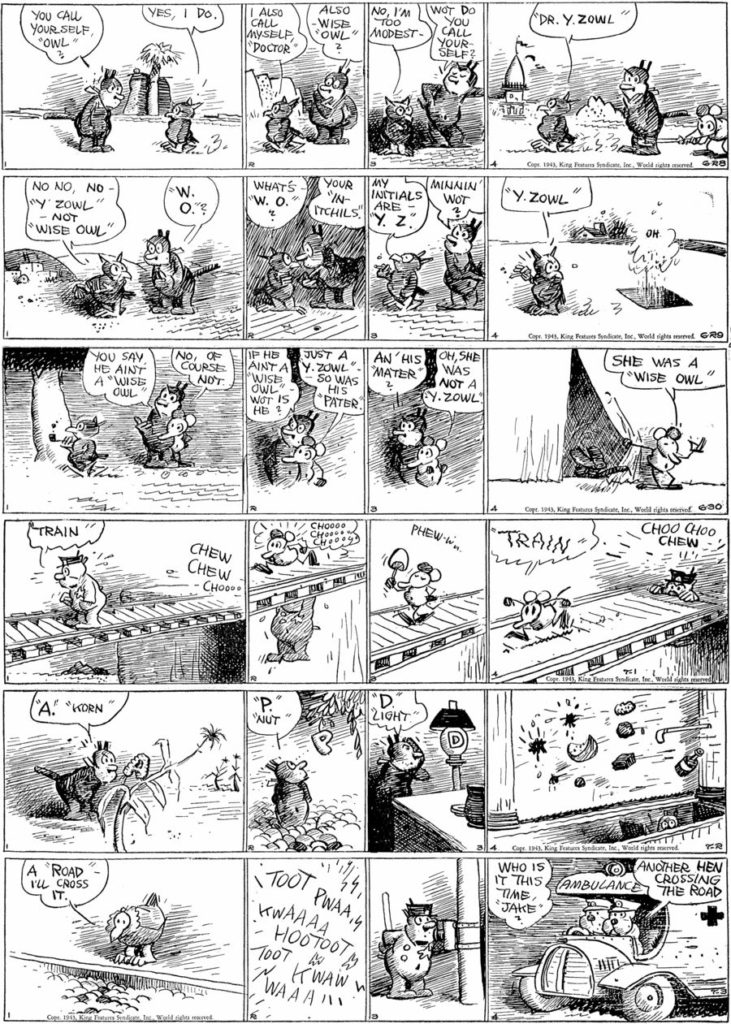 Â
Â
Krazy is from 6-28 to 7-3-1943 in this group. I’m not sure if this is the first appearance of Dr. Y. Zowl in the 6-28 or not, but Garge milks the name for all it’s worth. The Coconino stage is in clear evidence in the 7-2 as Krazy goes through a series of alphabet puns, only to be pelted by vegetables, bricks and bottles from the audience, while Offissa Pupp (?) cringes in the orchestra pit.
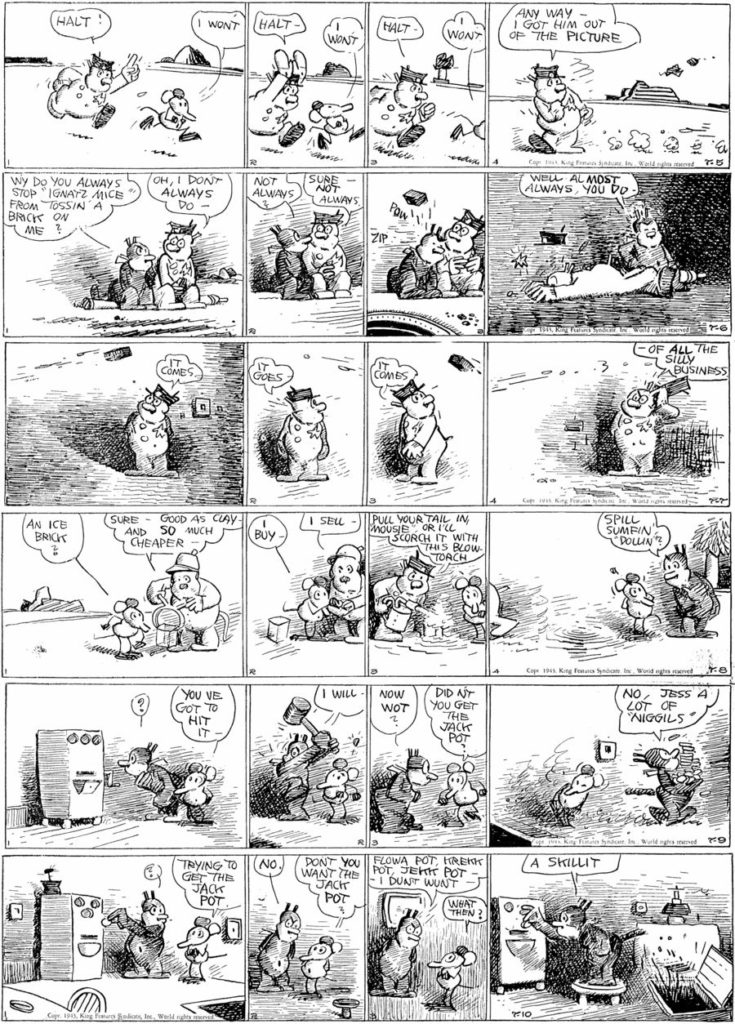 In the Krazy dailies from 7-5 to 7-10-43, Offissa Pupp breaks the fourth wall in the 7-5 as he chases Ignatz clean out of the “picture”. The Coconino stage makes an encore showing as Ignatz falls through a trap door in the 7-10. The drawings of Krazy continue to devolve, in the 7-10, note how strangely eerie the Kat’s eyes look in panels two and three. It puts the Kat into an angry and almost haunted mood leading into the play on words in the fourth panel. I also admire how Herriman works Krazy’s right leg into the shadow behind him in the second panel of the 7-9, as he anticipates hitting the vending machine.
In the Krazy dailies from 7-5 to 7-10-43, Offissa Pupp breaks the fourth wall in the 7-5 as he chases Ignatz clean out of the “picture”. The Coconino stage makes an encore showing as Ignatz falls through a trap door in the 7-10. The drawings of Krazy continue to devolve, in the 7-10, note how strangely eerie the Kat’s eyes look in panels two and three. It puts the Kat into an angry and almost haunted mood leading into the play on words in the fourth panel. I also admire how Herriman works Krazy’s right leg into the shadow behind him in the second panel of the 7-9, as he anticipates hitting the vending machine.
This is a “bonus” post, courtesy of Cathy’s drawing, so we will continue Myrtle and Felix next time.
We cats thank you for reading.
Your Comics Page 3-29-2018
Hi all you readers of the Catblog! Happy Easter! It’s been a long time between posts, I know, but my weekly Sunday Comics posts which are shared through Yahoo Groups really keeps me busy. I’m leading off with a 9 X 12 inch watercolor study I did of the Pasadena City Hall a few years ago. It was a hazy, partly cloudy day, so my colors are just as they appeared to me that day, a bit muted. I used reds as shading in the trees, playing compliments against each other. The Pasadena City Hall finished construction in December, 1927, and was influenced by the 16th Century Italian architect, Andrea Palladio. The Lantern on top of the dome, is 206 feet from the ground. In this painting I don’t think I managed to represent the true scale of the building, but I condensed it slightly to fit the page.
In Felix, from 5-29 to 6-4-1933, Felix tries to ransom Danny’s clothes from a Tramp by plying him with grub stolen from Danny’s ice box, fished from a stream and waylaid from a restaurant delivery man. The Tramp is finally placated with a pair of Danny’s Dad’s trousers, which unfortunately contain the week’s salary. The Sunday has Felix back in 1933 again, helping out a little bicyclist by siccing an angry goat on to the neighborhood boys who puncture bicycle tires. Check out the Felix jigsaw puzzle and the play money given to the readers as a bonus next to the “Laura” topper!
Myrtle is from 2-28 to 3-6-1949 this time. I like the 3-4 daily as Bingo is shooed away from Susie’s bed, Freddie’s chair and his own doghouse. Winding up back on Susie’s bed, Bingo exclaims: “Now we’re ready to start all over!” Also funny is the 3-2, as Freddie strips a stuck sweater over Myrtle’s head and she irons out her mussed-up, ruffled hat. The Sunday page from 3-6-49 is beautifully laid out as Myrtle’s braids are once again clipped off. Dudley Fisher liked to “masculinize” Myrtle every so often, and she looks very much like a boy without her braids. Myrtle figures out how to instantly switch between boy and girl in the second panel.
Here’s two weeks of Krazy Dailies, from 6-14 to 6-26-1943. The first week is devoted to “heat” and “hot spots”. Ignatz pulls a Kat style pun in the 6-18 (Roam-Ants) and Krazy extends the pun a bit further by saying: “From Rome, Eh?” In the 6-16 and 6-19 strips, Garge shows the floorboards of the Coconino “stage”, along with Krazy heating a tea kettle over a “hot spot” in the 6-16. The second week is devoted to the 1940s dancing “Jive” craze. I like the “Jive Wire” joke in the 6-25 more than the other “Jive Jokes”. Garge draws one of his strangest Krazies in the 6-24. He attempts an all fours pose on the Kat as a couple of fleas do some “KooDoo Foodlin” on her back. She almost looks like a Scotty dog. (Garge loved Scotch Terriers, and owned a pair of them.) The approach to the anatomy of the Kat’s front legs radically evolves as she grows shoulders in the change from the first to the second panel. There is good foreshortening in the third panel of the Kat’s front legs, so perhaps Garge was troubled with his arthritis when he drew the first panel.
   May you all have a wonderful and blessed Easter. Remember, Rabbits can’t lay eggs.
   Rest in Peace, Fred Crippen, veteran animator and director. And one heck of a drunken golfer!
Your Comics Page, 1-31-2018
Welcome back! Here’s a watercolor sketch I made in Bishop, Ca. a few years ago. I love the mountains and the horse property around there, the ranges are called the “Whitney Portal”, because the range includes Mount Whitney, which is the highest summit in the continental U.S., at 14, 505 feet. Bishop is just a little bit East of Lone Pine, Ca., home of the Lone Pine Western Film Museum and the Alabama Hills, where Hopalong Cassidy, Death Valley Days, Gene Autry, Roy Rogers and so many old time Western features and TV series were shot. I want to go on a horseback tour of the Alabama Hills some day.
Felix helps Danny Dooit play hooky in the strips from 5-22 to 5-28-1933. Danny feels guilty and Felix has a hard time getting him into the spirit of a day of fishing and swimming, then they meet a hobo who wants a “feed”. In the jungle, Felix runs afoul of an elephant, an exotic bird with long legs and an ape, before he wakes up from his dream with the help of the barnyard animals and a pail of water.
Here’s Myrtle from 2-21 to 2-27-1949. In the dailies, Sampson sets up a wired telephone network in Myrtle’s house with painful results for Freddie. I like the fantasy in the 2-24, as Bingo the dog “wakes up” Myrtle’s sleeping look-alike doll. The Sunday is a dream fantasy, as the Sun runs a relay race in a Technicolor landscape of Freddie’s imagination. This is one of Dudley Fisher’s best panoramic pages!
In answer to reader Daryl Boman’s request, I’m presenting a double dose of Krazy, from 5-21 to 6-12-1943. My favorite daily in the first batch is the 6-5, as Krazy tries to figure out where he came from, and Ignatz produces an ink bottle and pen, saying: “Figure It Out Yourself”. Garge does a bit of wartime satire in the 6-7 to 6-12 strips. Especially striking is the 6-9, contributed to the Catblog by Gerd Heinlein, as Krazy loses 8.25 of his lives in a fight with a “Super-Patriot”. Evidently, there were Patriots and Super-Patriots in WW2. If you watch “The Best Years of Our Lives”, directed by William Wyler in 1946, you’ll see a sequence in the drug store where Dana Andrews punches Ray Teal’s character “Mr. Mollett”, so hard that he crashes into a glass display case. The cause of the argument is that Mr. Mollett is skeptical of the reasons that the United States is in the war and it makes Dana Andrews (ex-Navy pilot), mad. This is a little known aspect of the WW2 years that Garge is alluding to here: Ill-will between “Patriots”, who were a bit critical of the politics of the war, and the “Super-Patriots” who were for the war, no matter what. The popular image of WW2, is that after Pearl Harbor, there was little or no criticism of the War’s raison d’etre, but there was a wider range of opinion than that. The whole “One life to give for my country” quotation comes from Nathan Hale, a Revolutionary War soldier and spy. In the 6-11, “Esne” is old English for “Laborer among the lower classes”. I hope this will keep Daryl Boman happy.
A milestone has passed, which seems to be little noted in comics fandom, Yoe Books and IDW publishing have just put out Popeye #65, the last in their series reprinting ALL of Dell’s regularly numbered Popeye comics from the 1940s to 1962. After that, Gold Key started publishing Popeye in Giant editions. I happen to like Bud Sagendorf’s cartooning and his approach to Popeye, Olive, Wimpy, Swee’pea and cast is second-best to the Elzie Segar strips of the 1920s and 1930s. The adventure in the almost book-length stories of the first 10 52 page issues are especially exciting and funny. Yoe Books is also issuing the series in hard-cover book collections. It’s kind of sobering that I was the only person still buying the series at my local comic book store here in Glendale toward the end. My store, Legacy Comics, kept ordering the issues for me, since subscriptions were not available. Yoe Books should really be commended for this accomplishment, as they carried on with Popeye, despite low sales. Comic Books have swung over to a “traced from photographs” look in the artwork. There is very little good cartooning left in “funny books”. So again, a tip of the sailor hat to Yoe Books for hitting 65 issues of “Popeye”. Maybe another publisher will take a chance on the earlier “Four Color” Popeye books some of these evenings. Now let’s all stroll over to the gym and watch the fat men play handball!
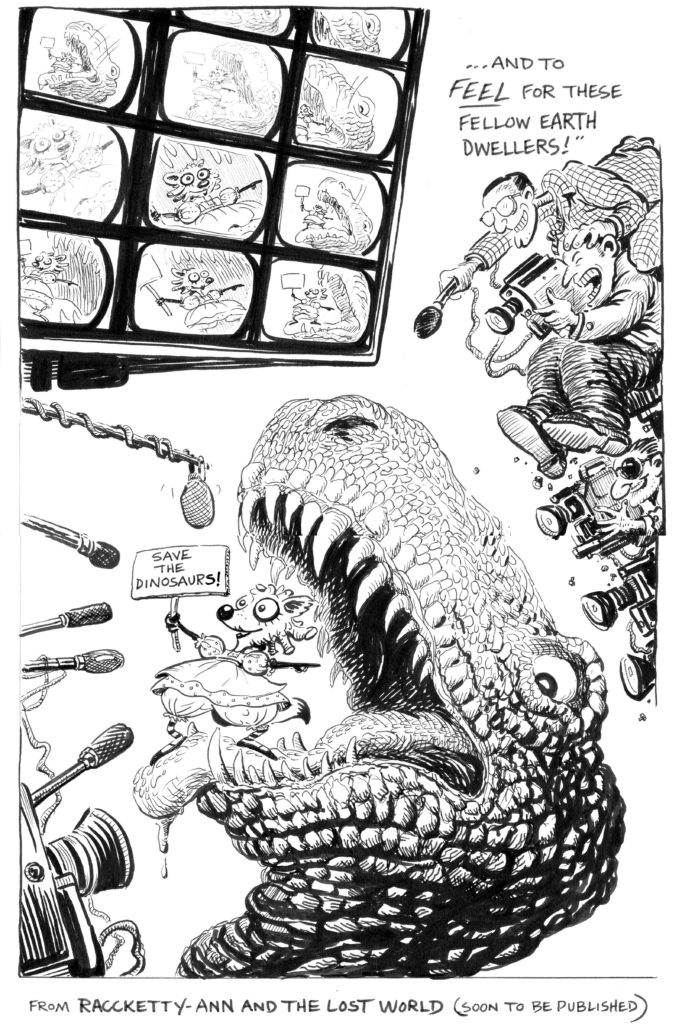

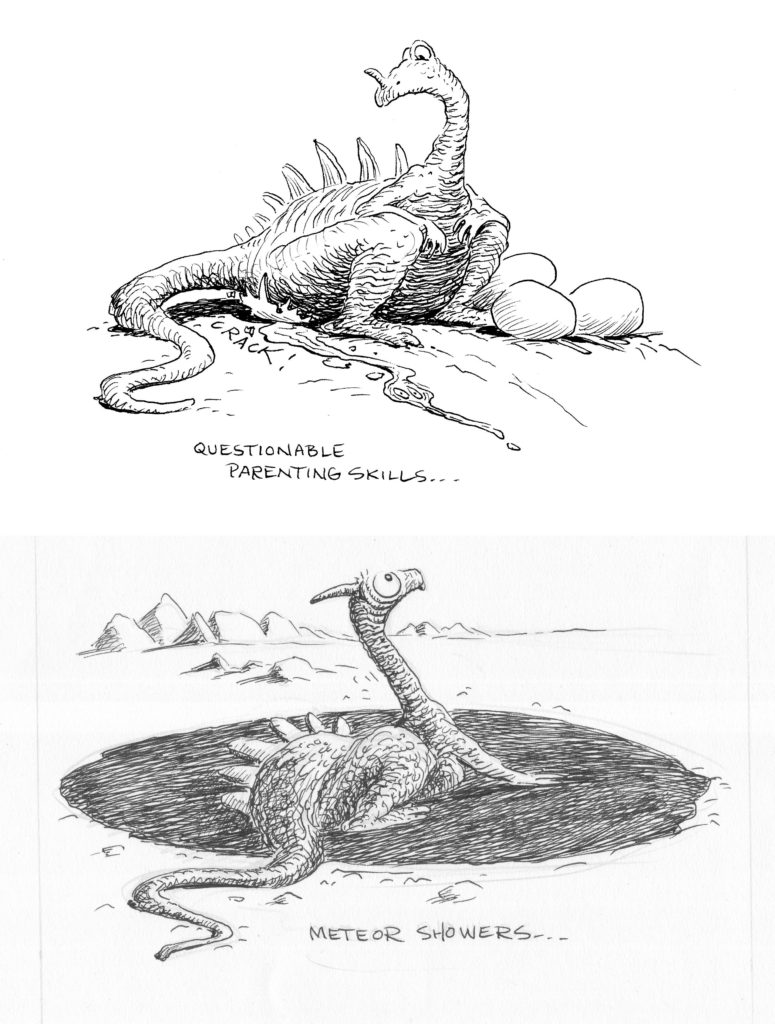
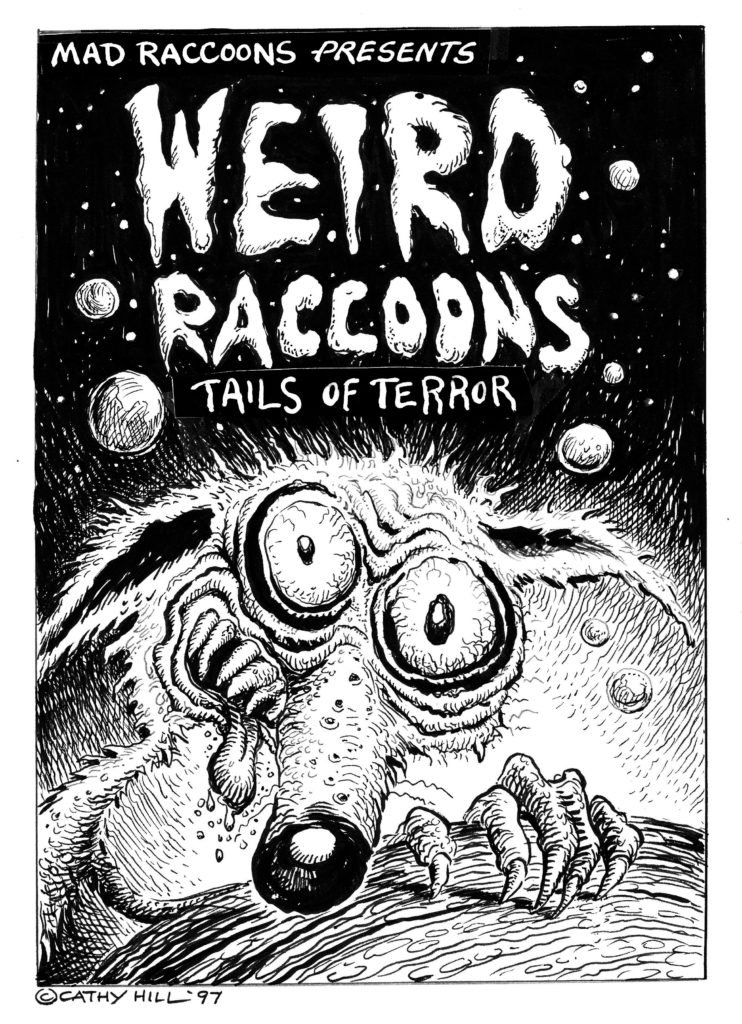
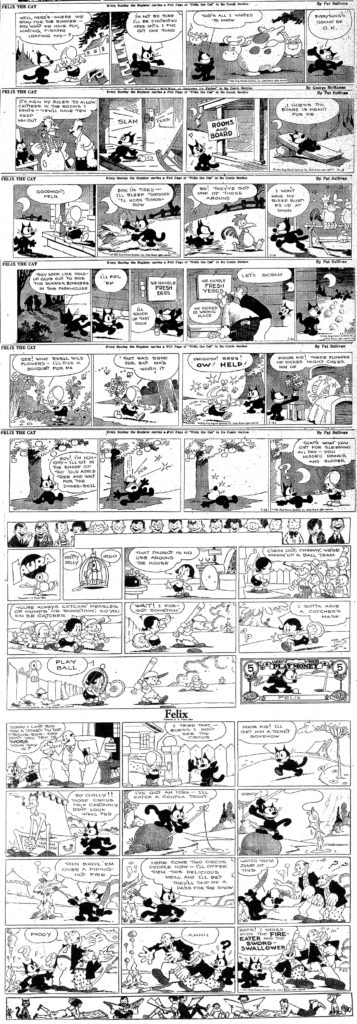

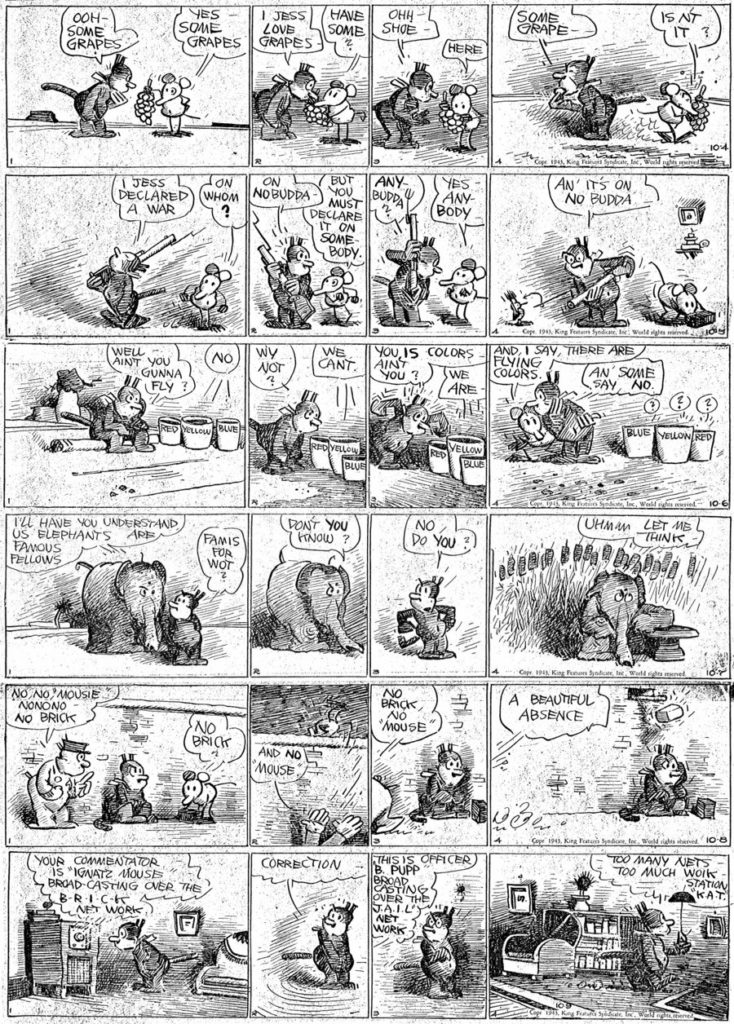
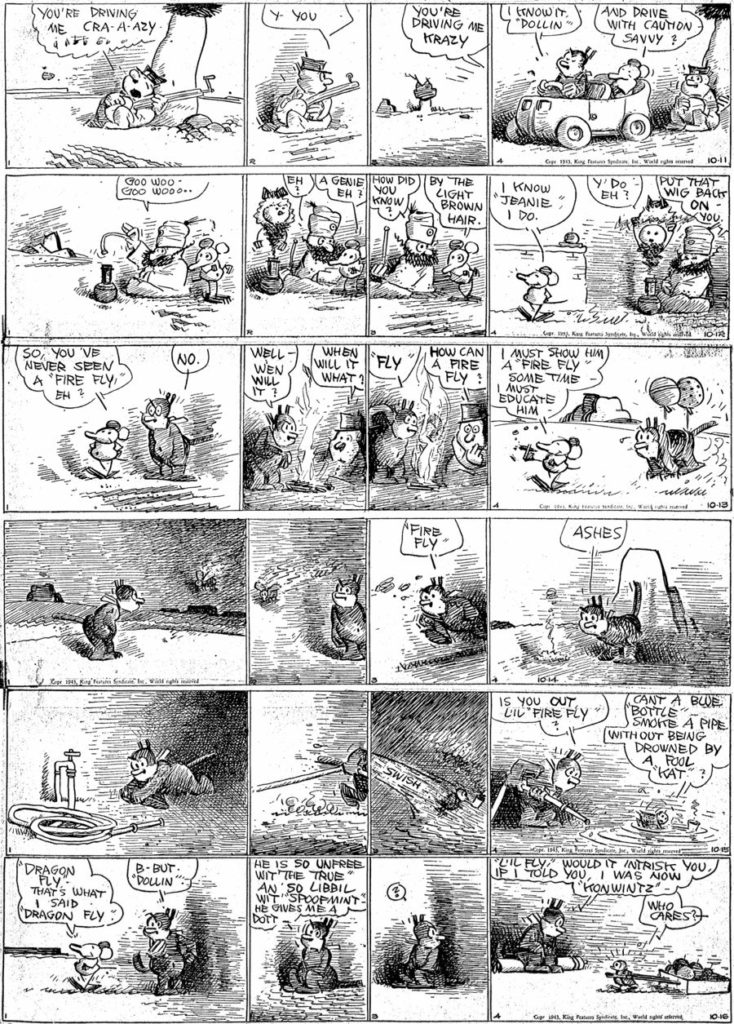

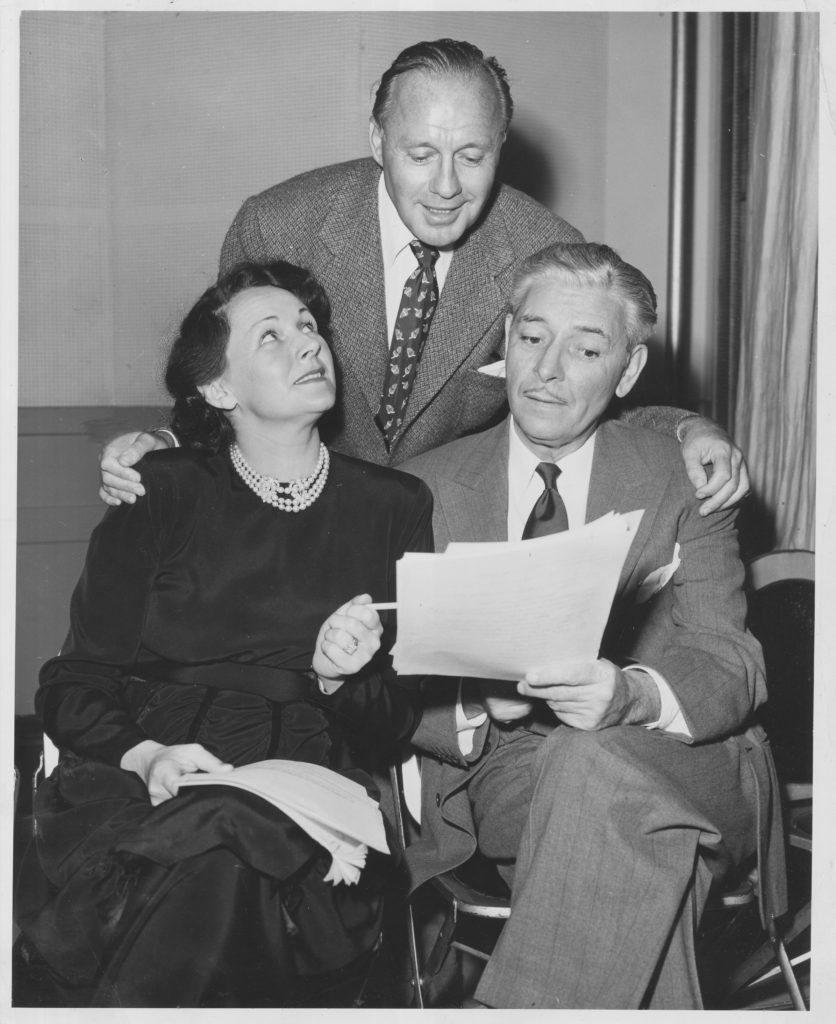
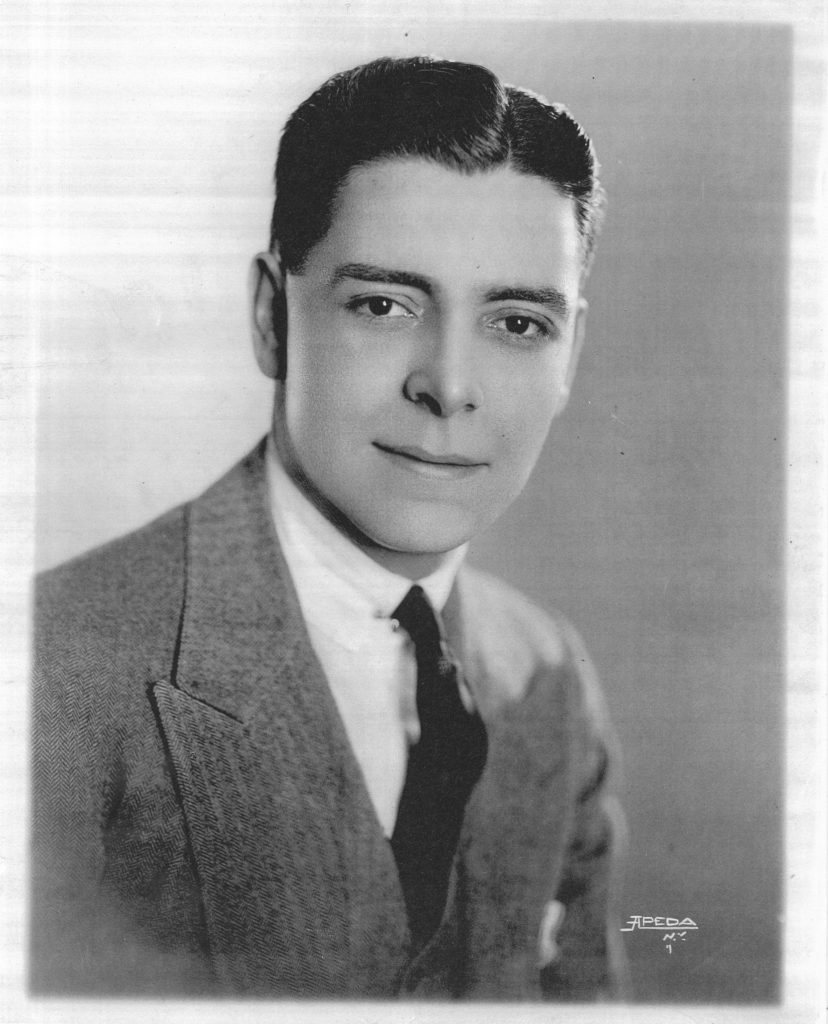
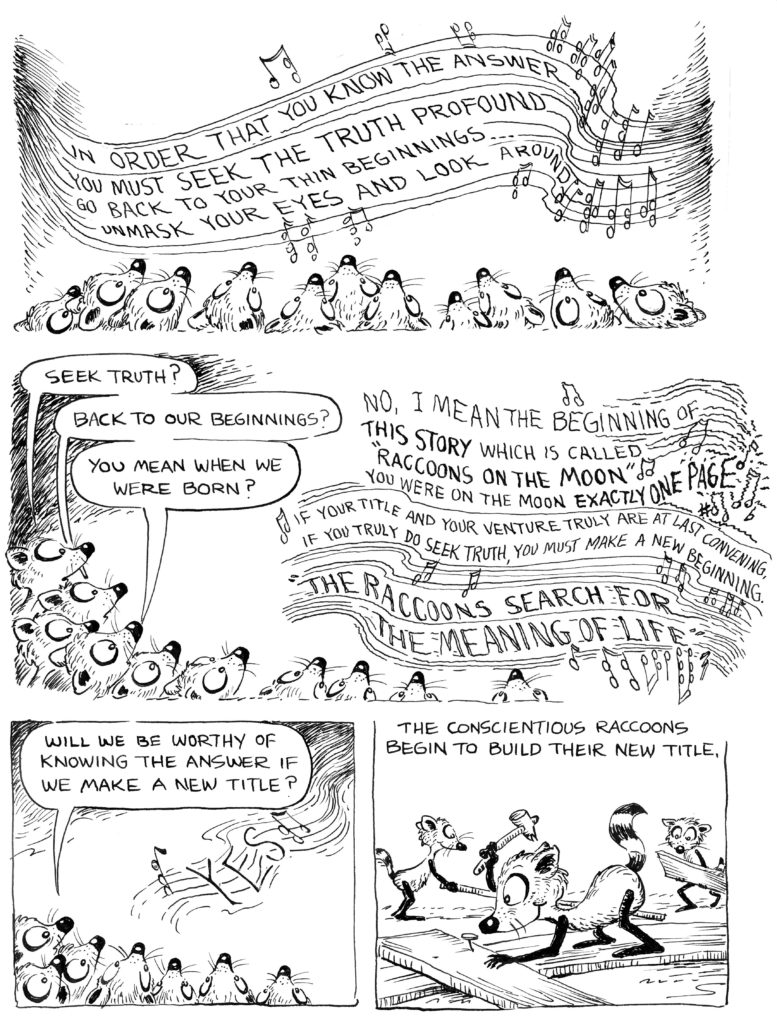

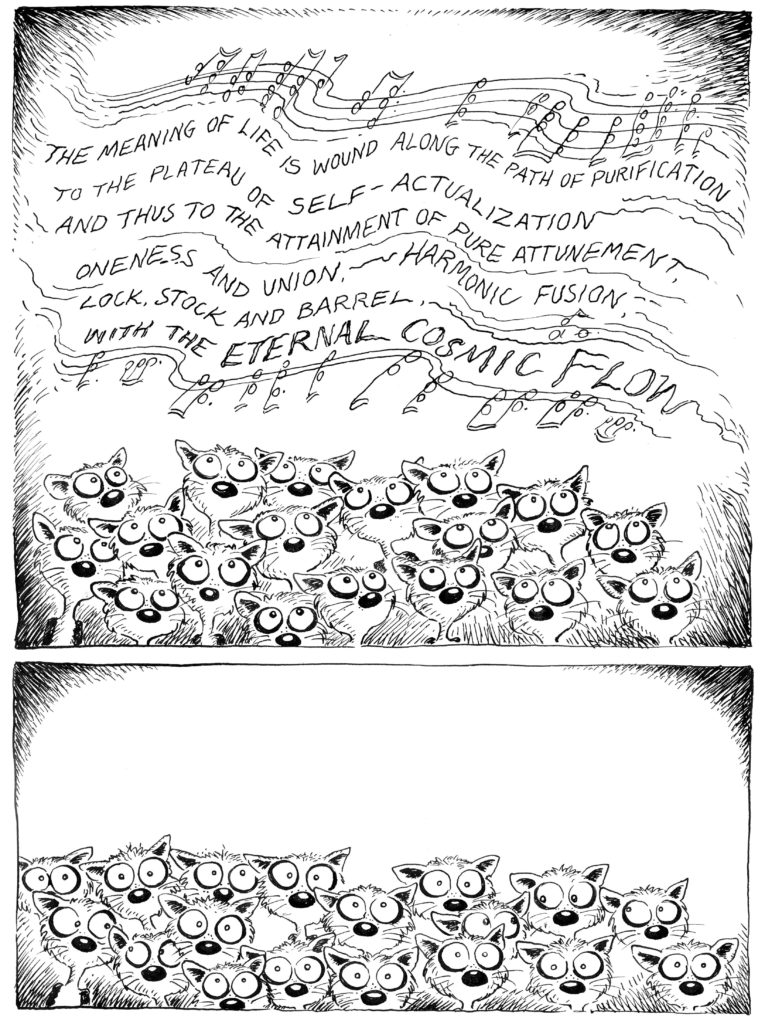
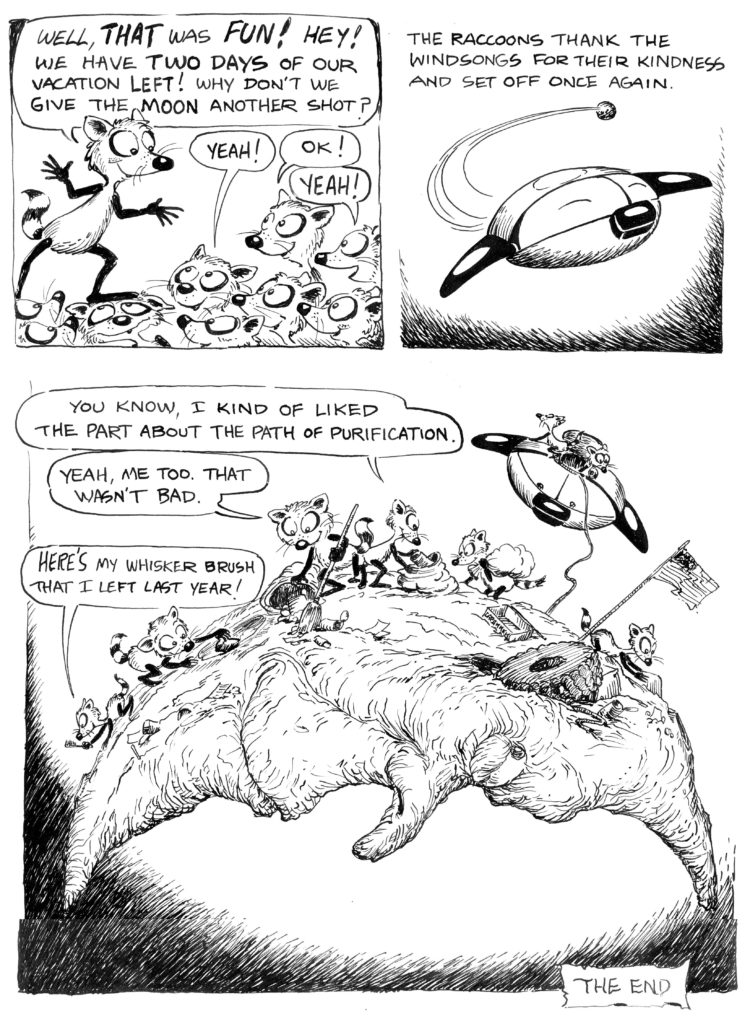
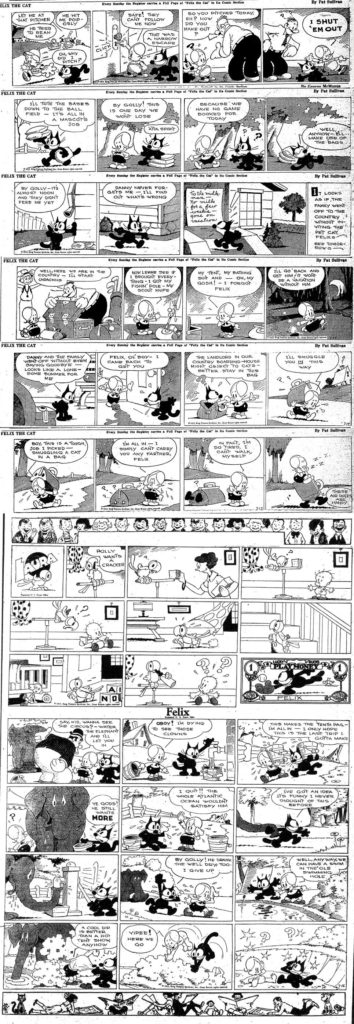
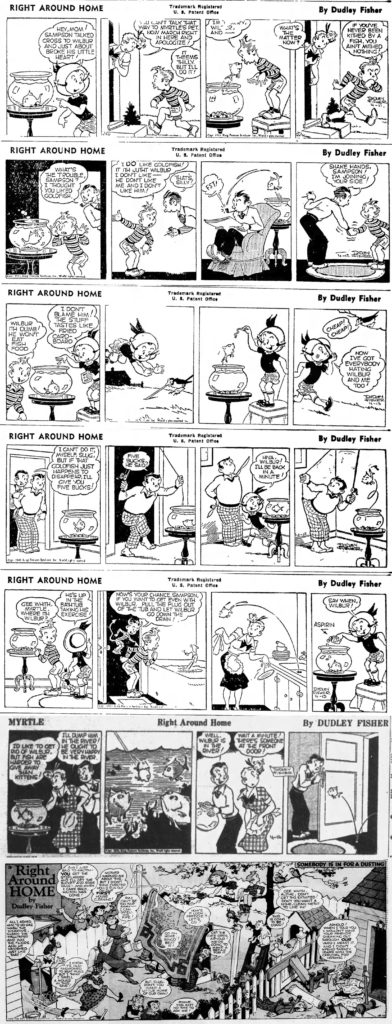
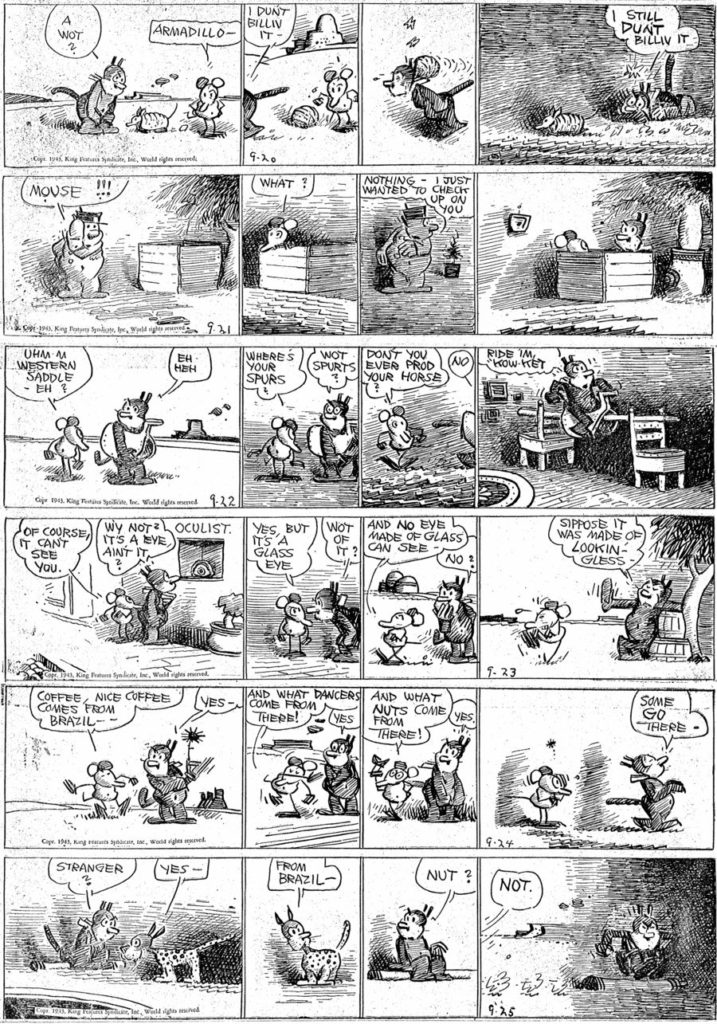
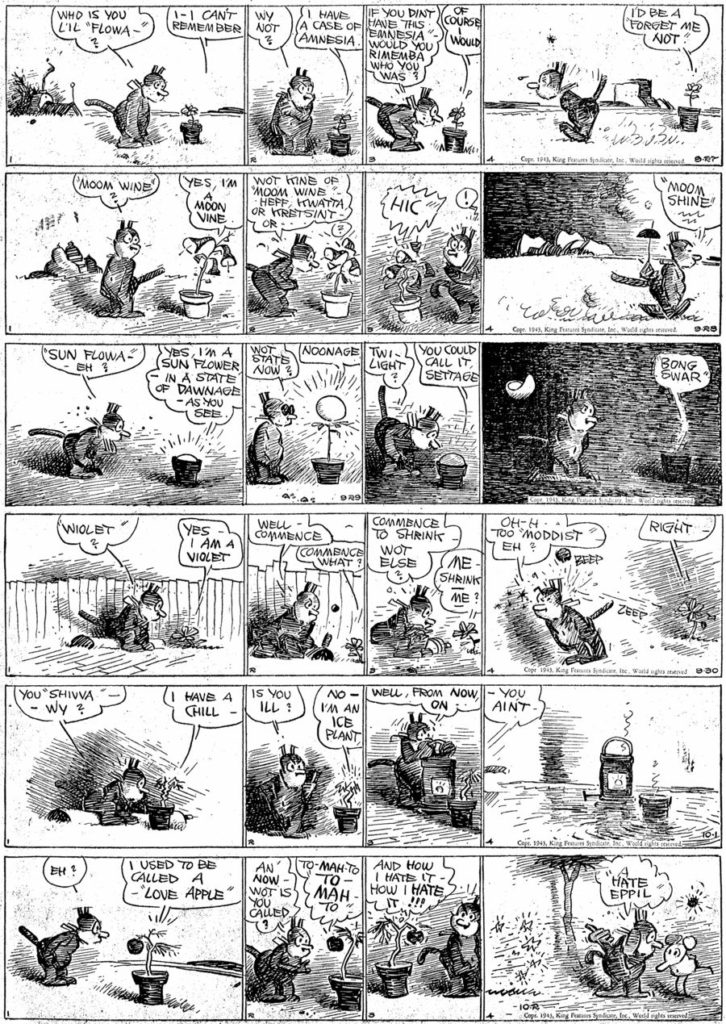
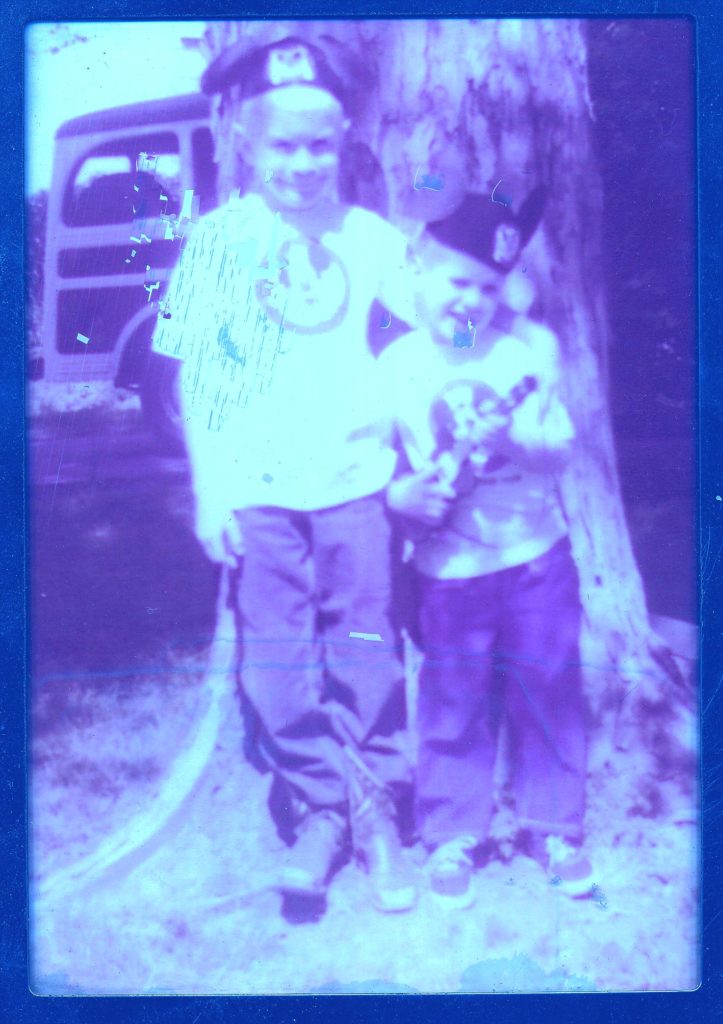
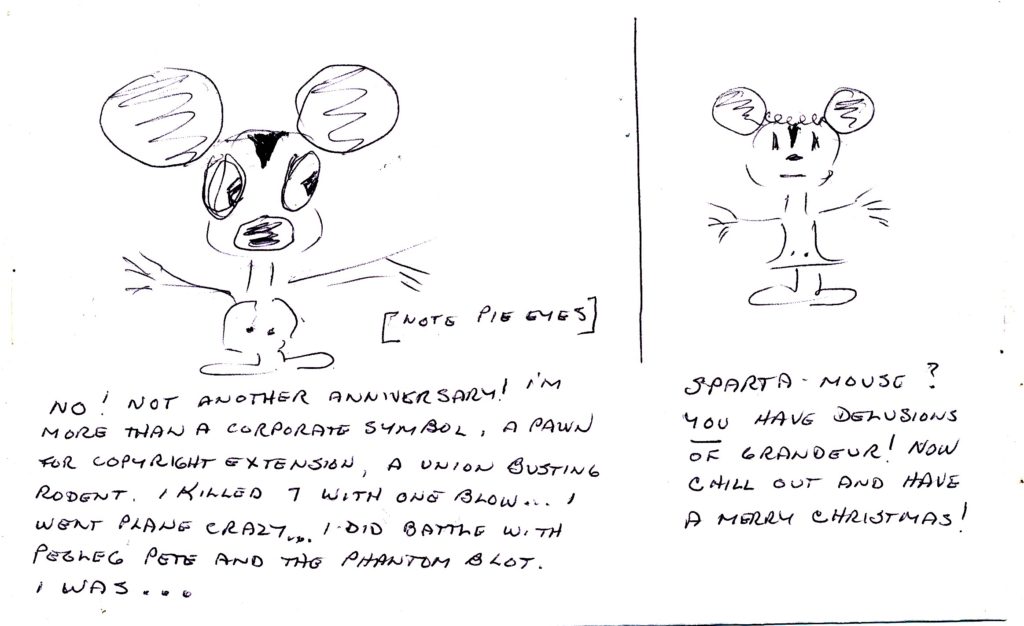
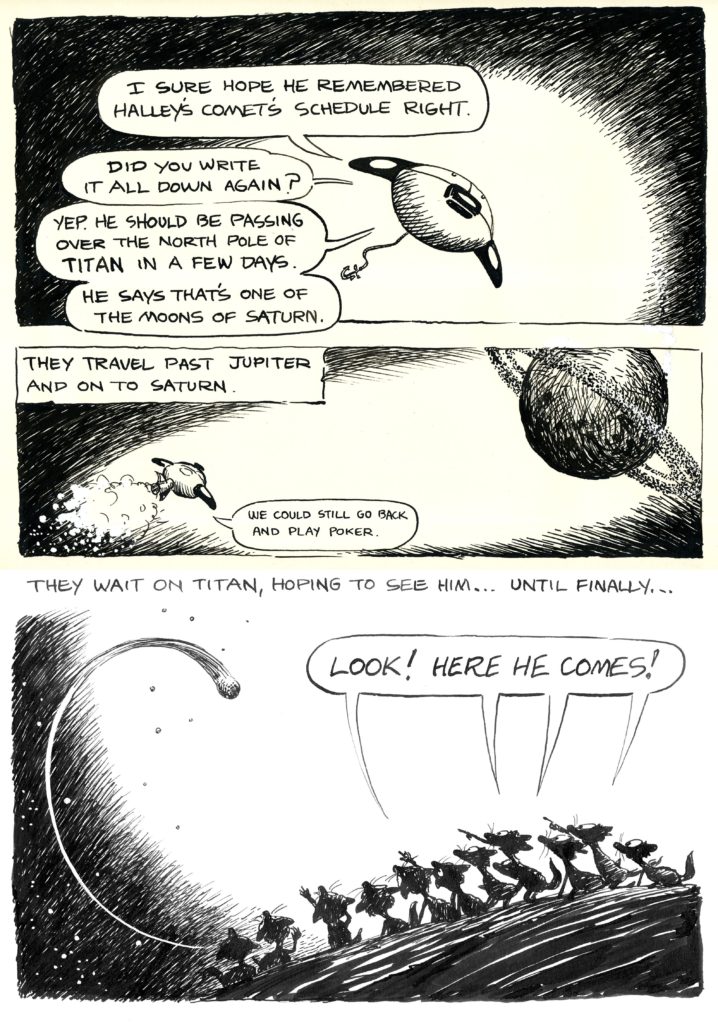
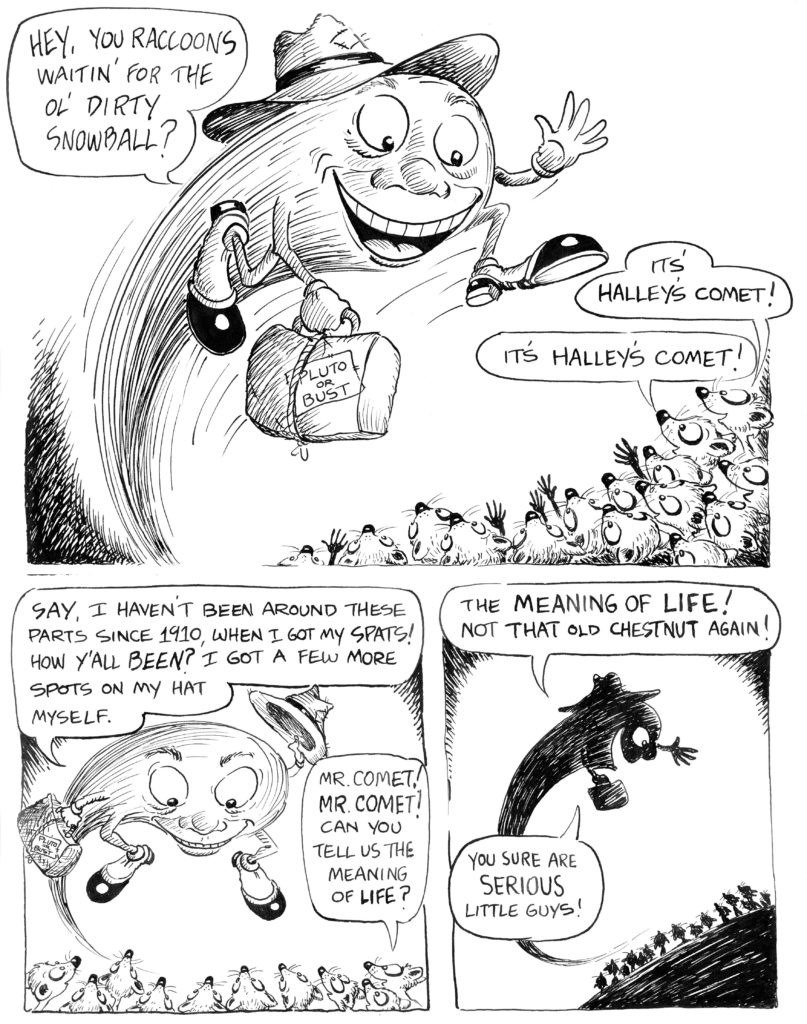
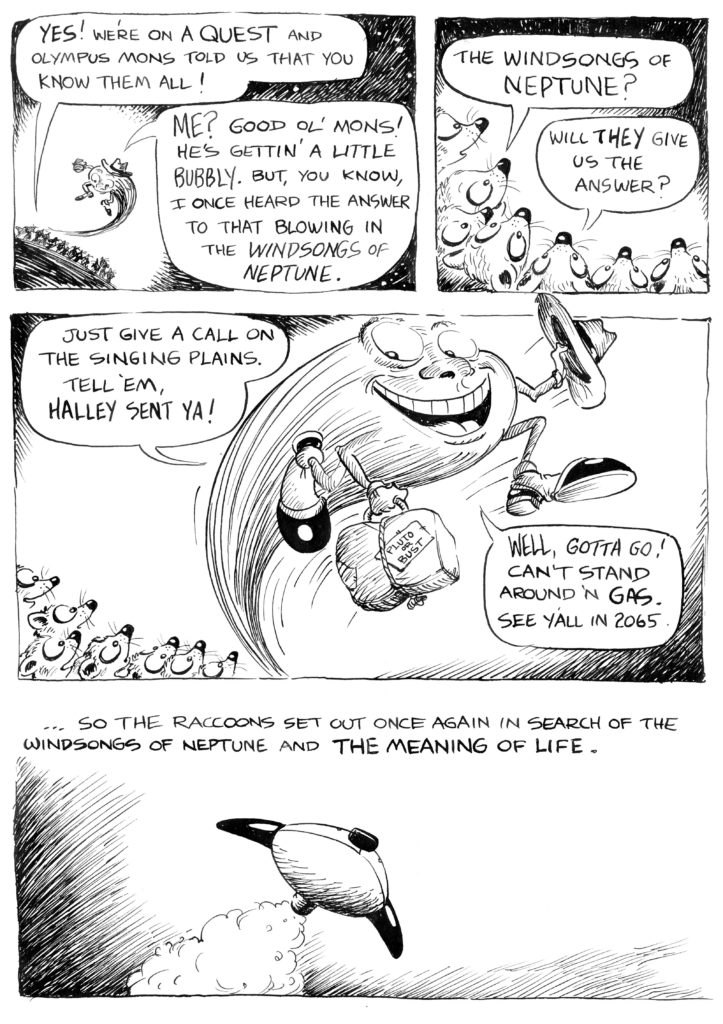
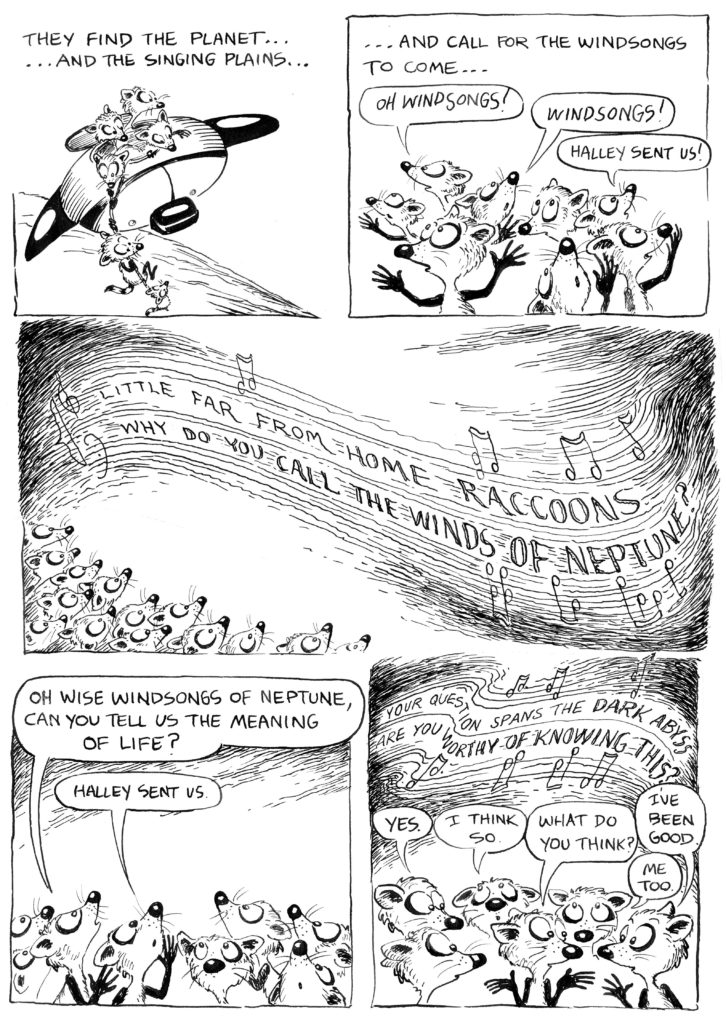
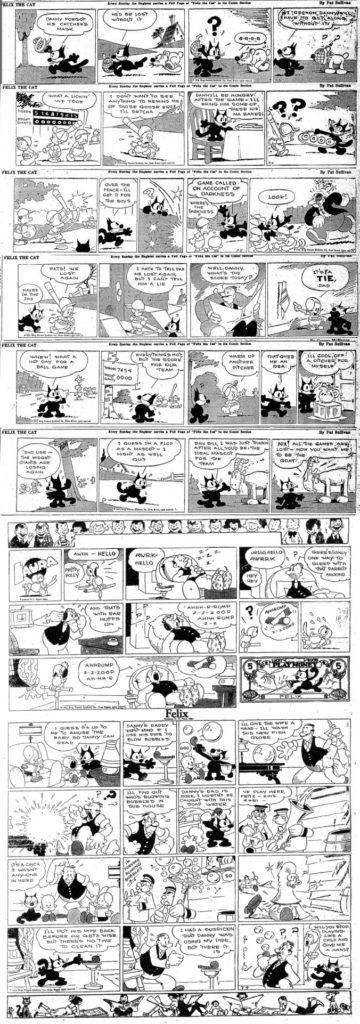

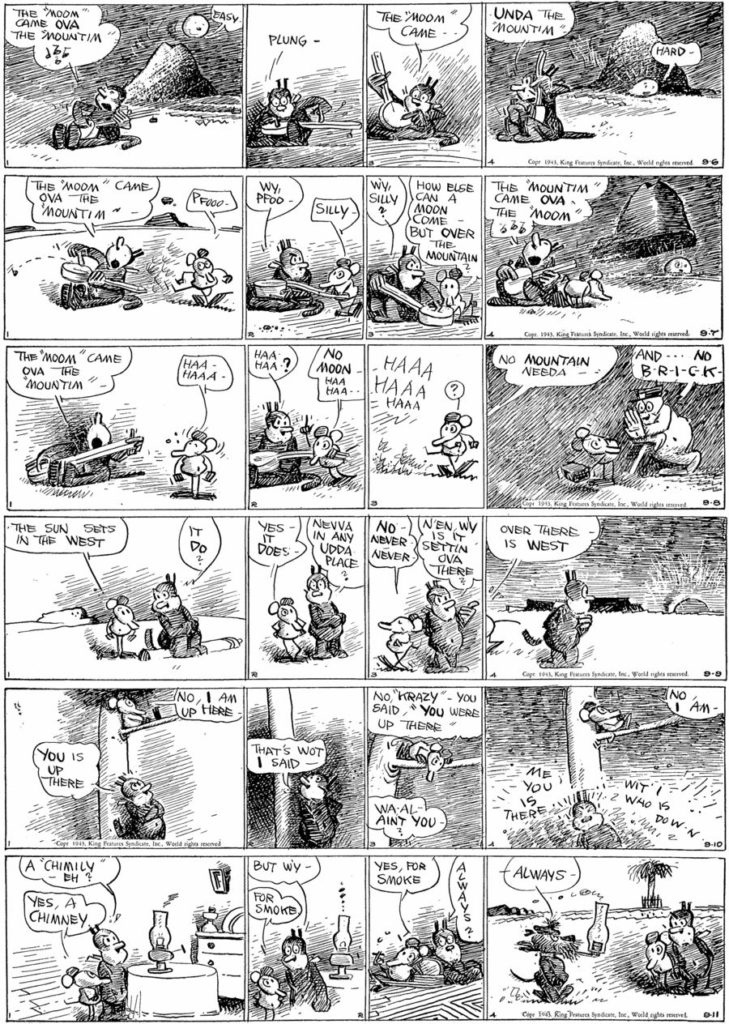
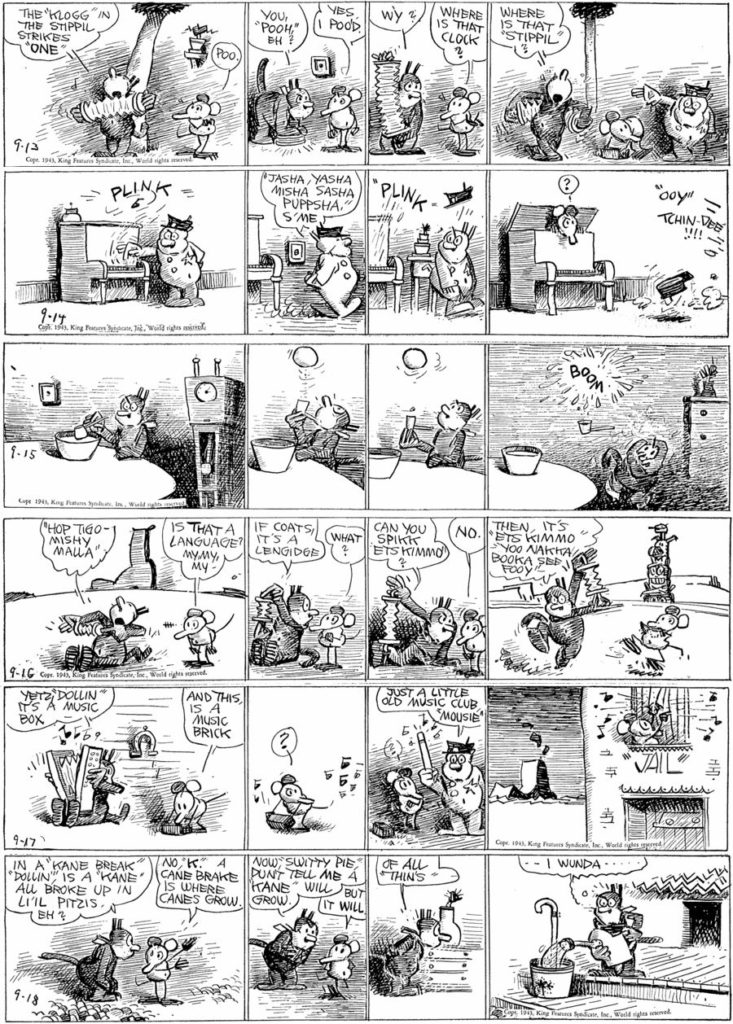
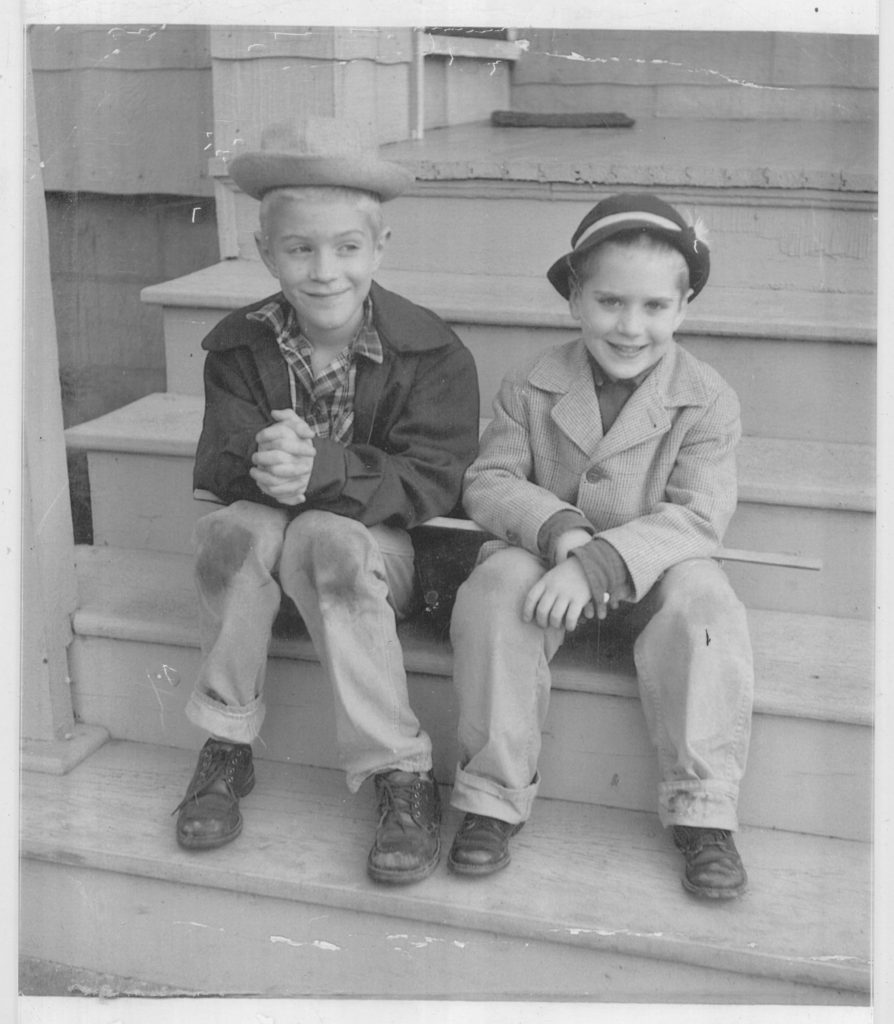

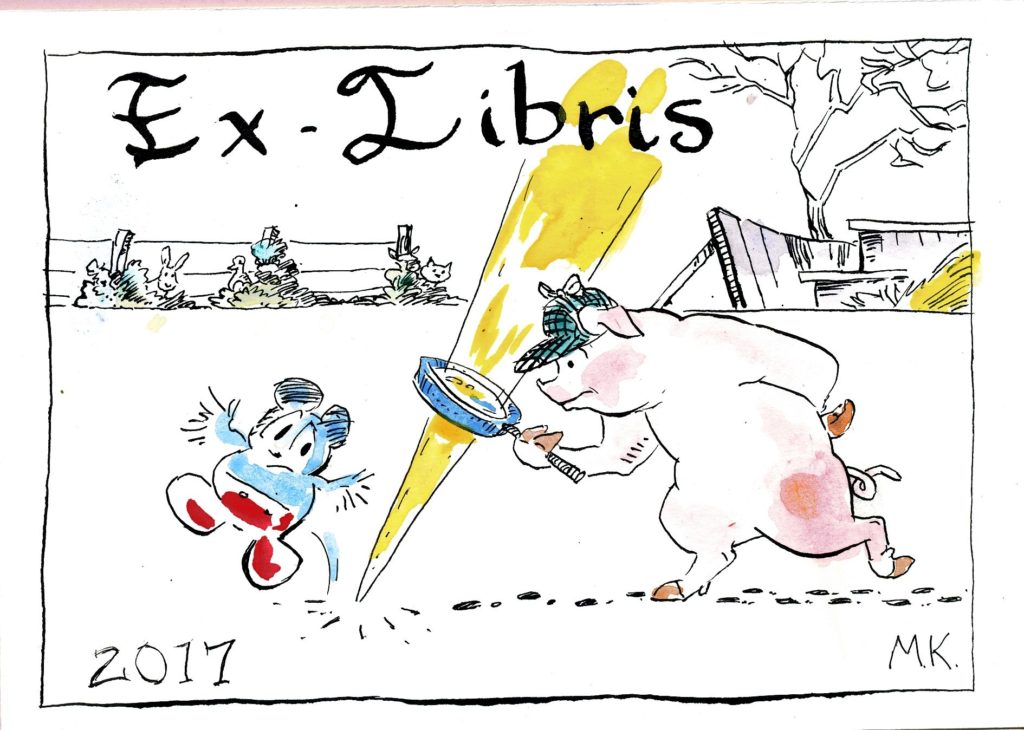
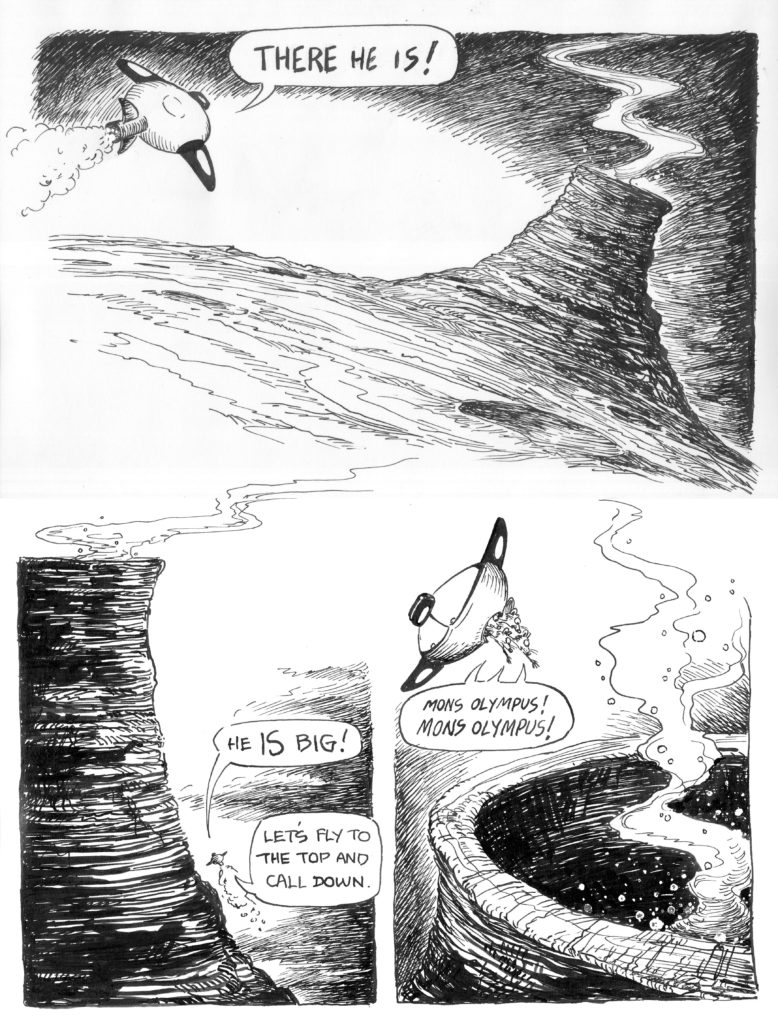
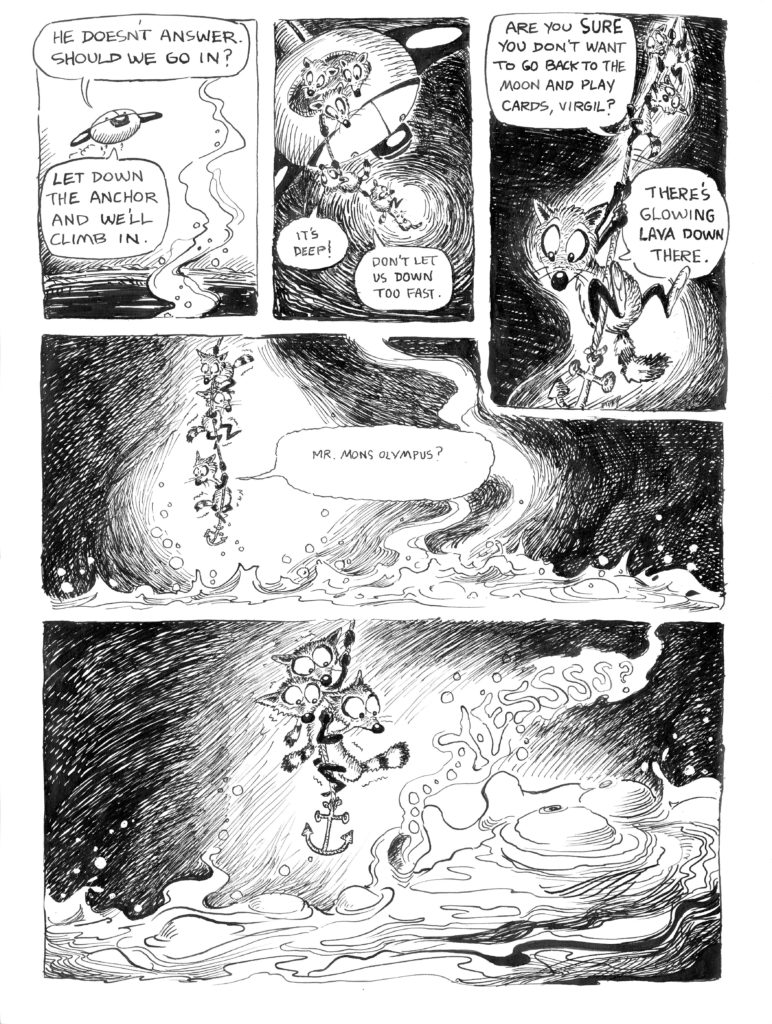
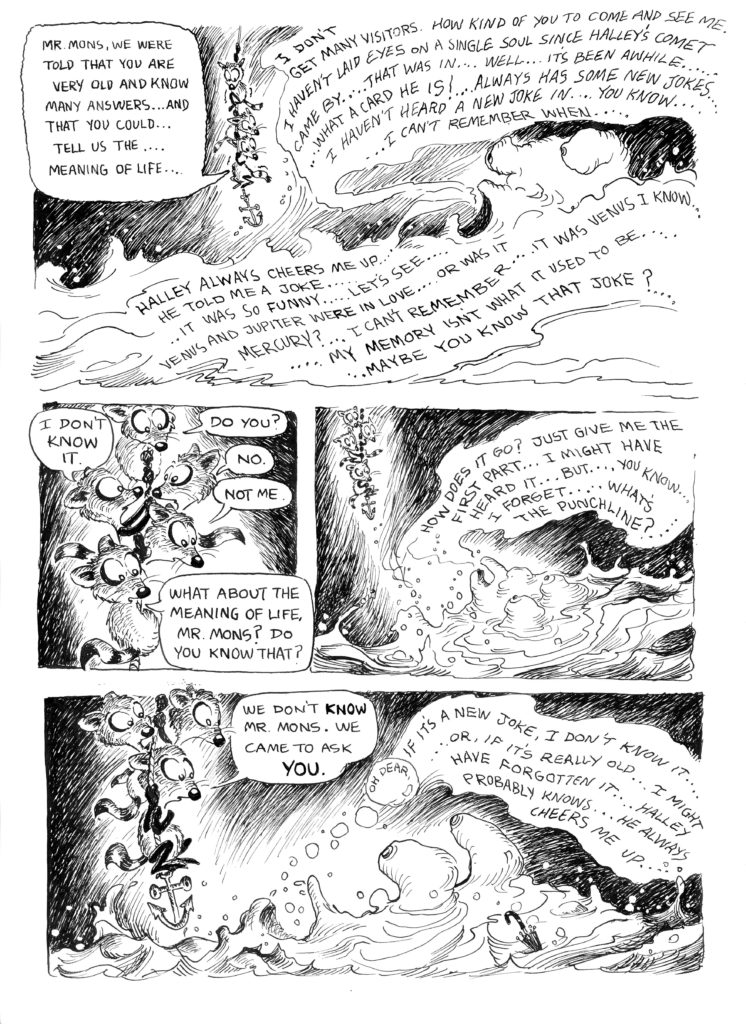
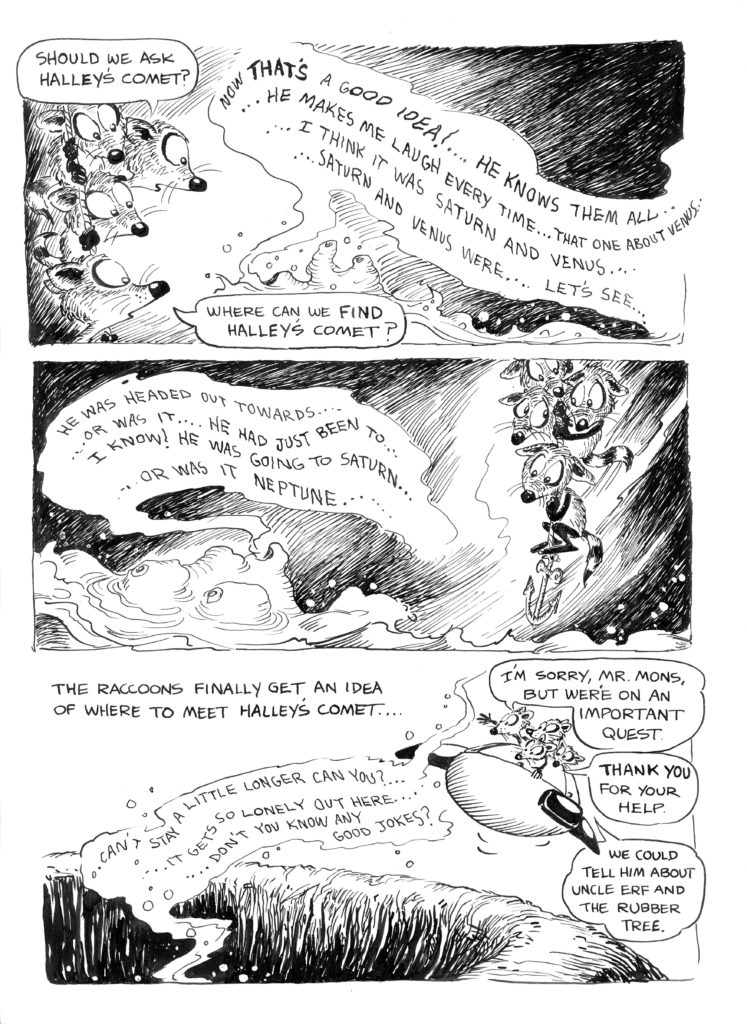
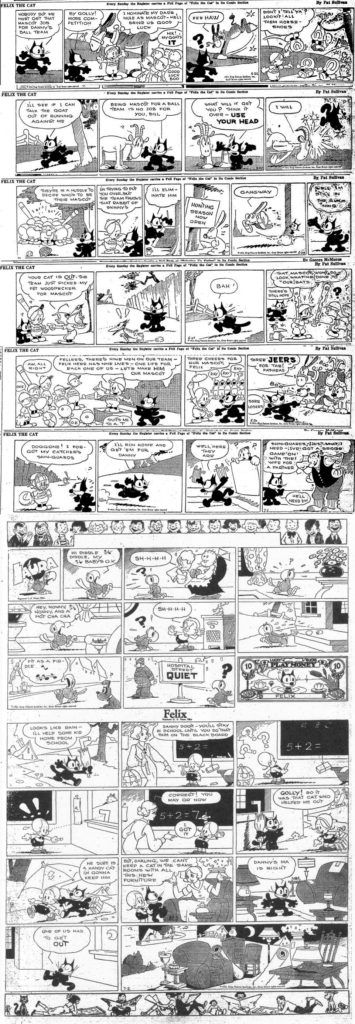
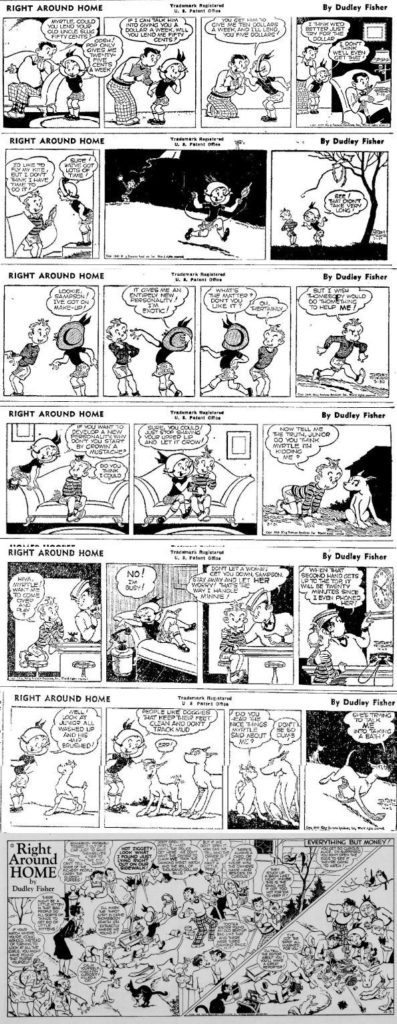
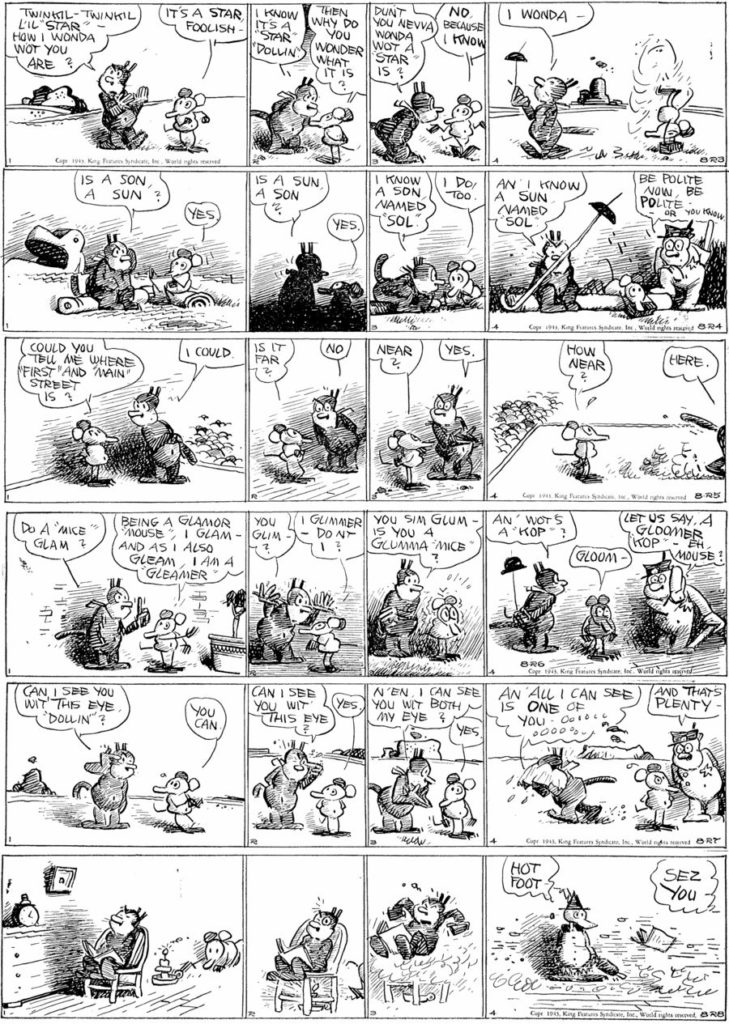

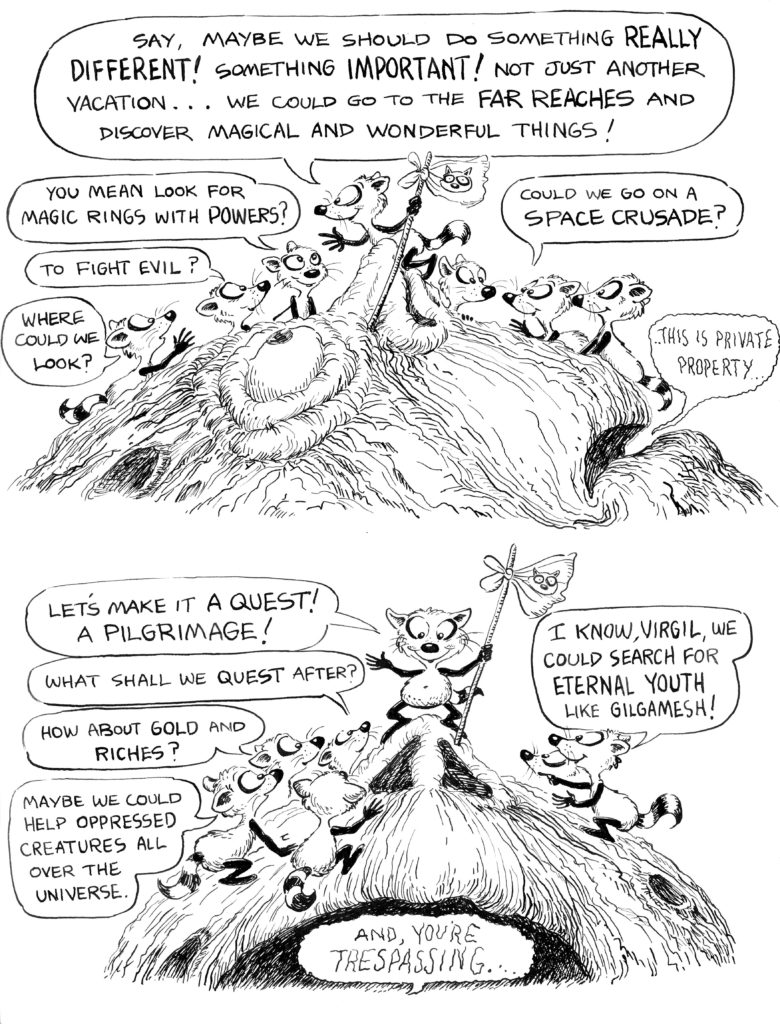
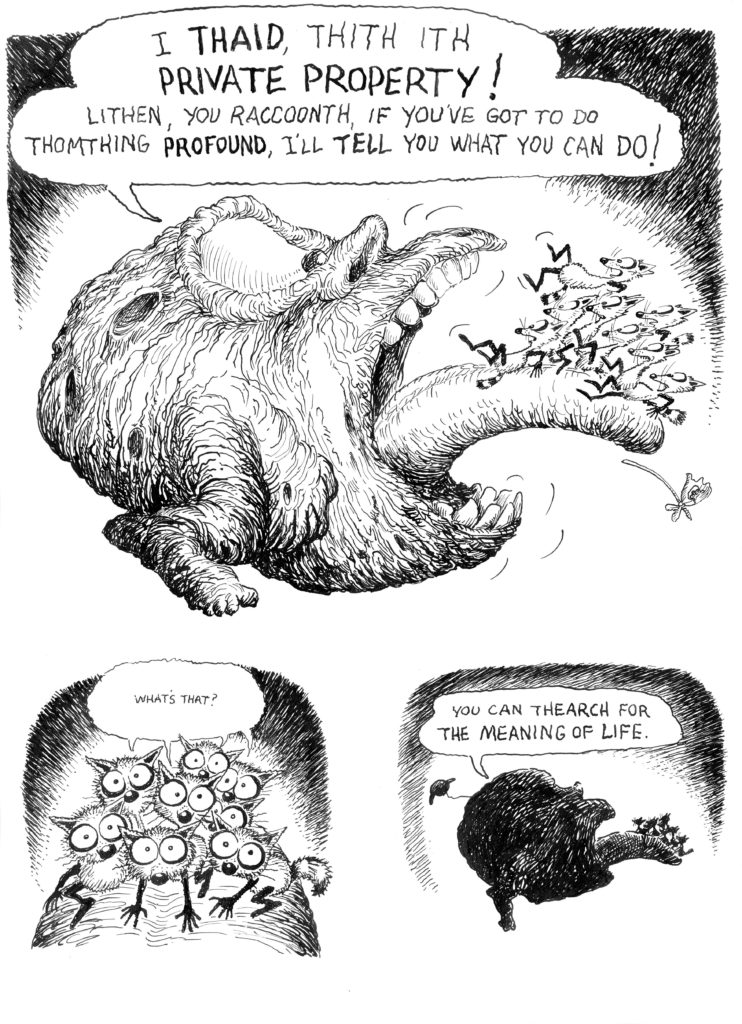
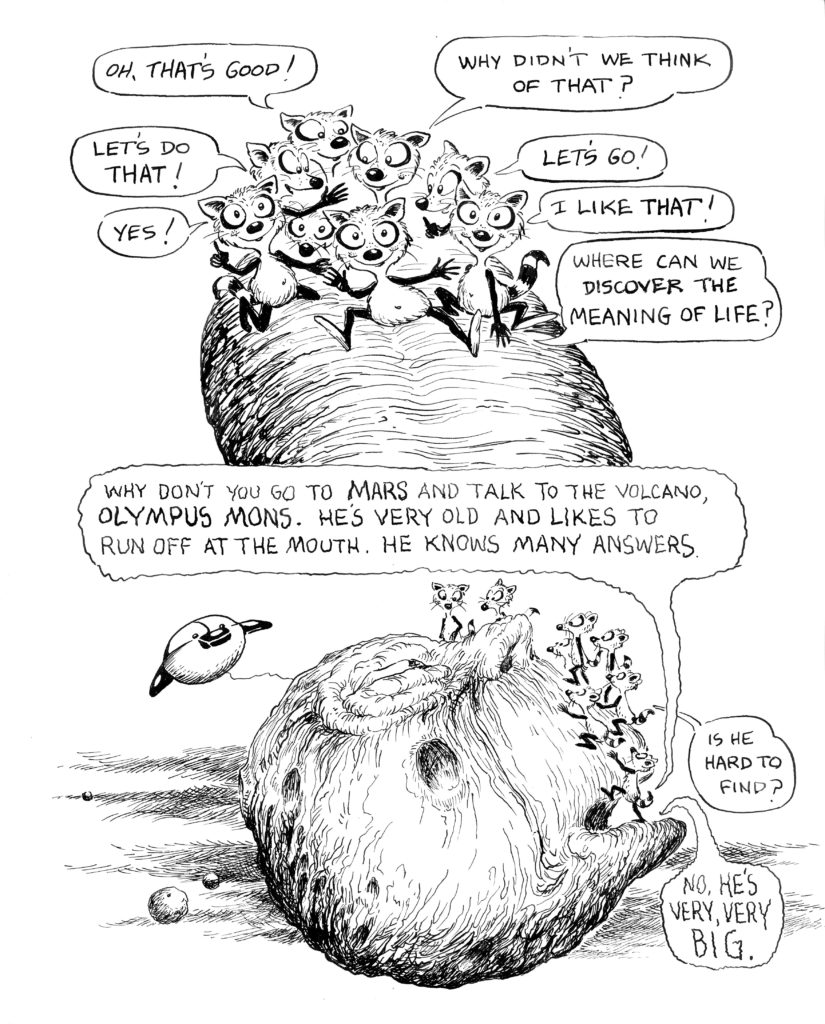

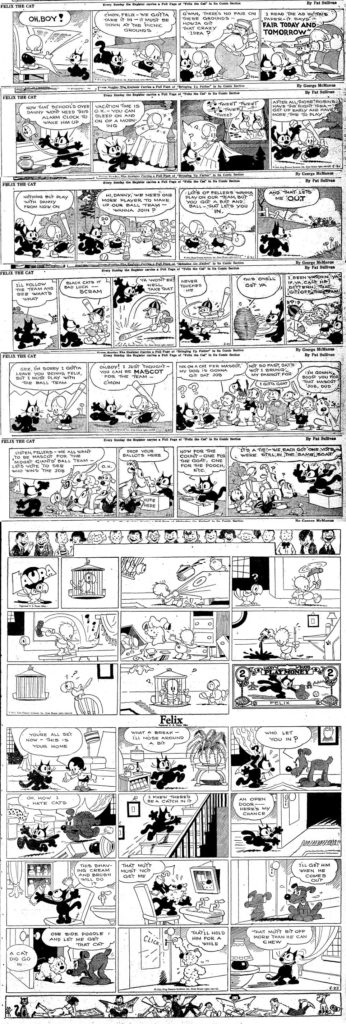
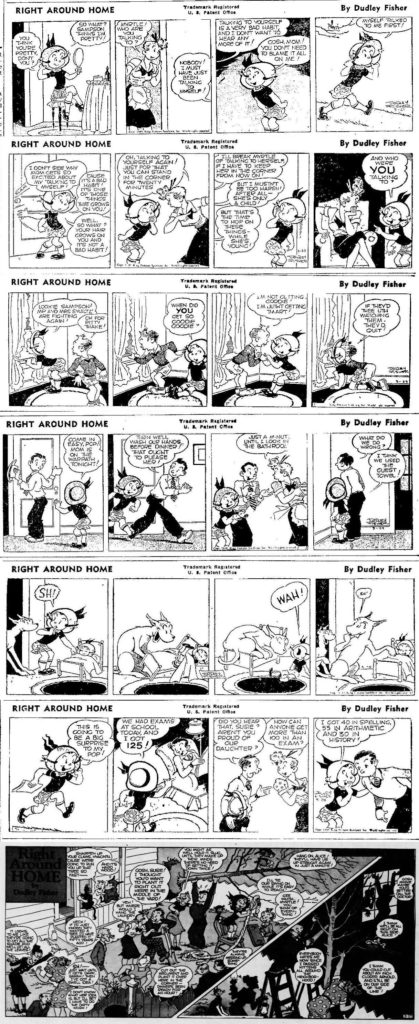
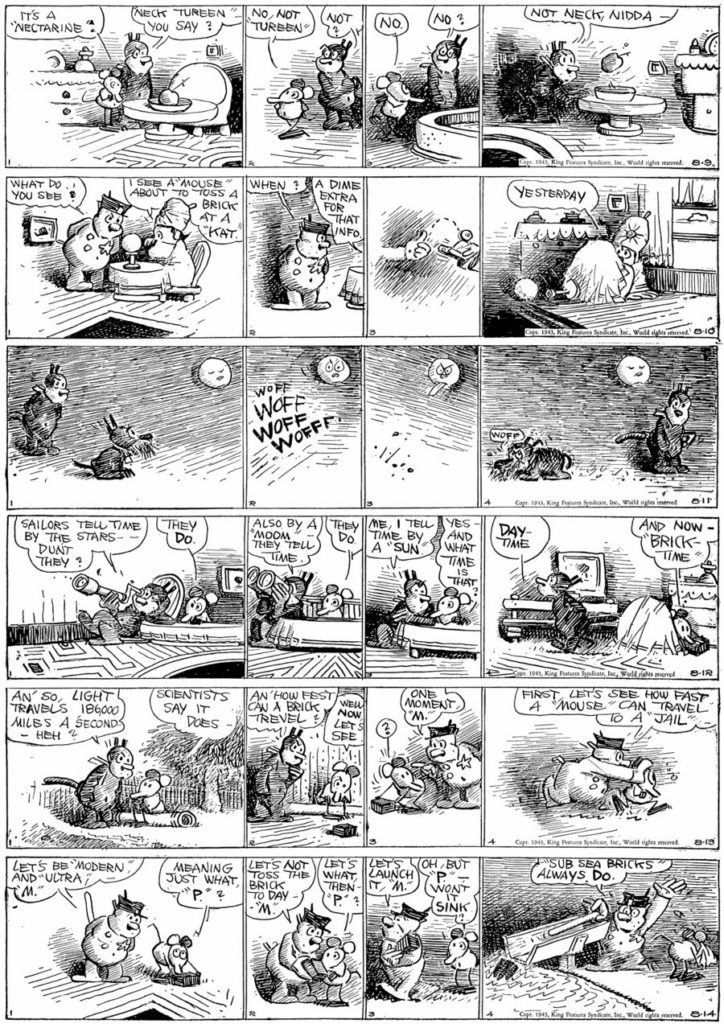
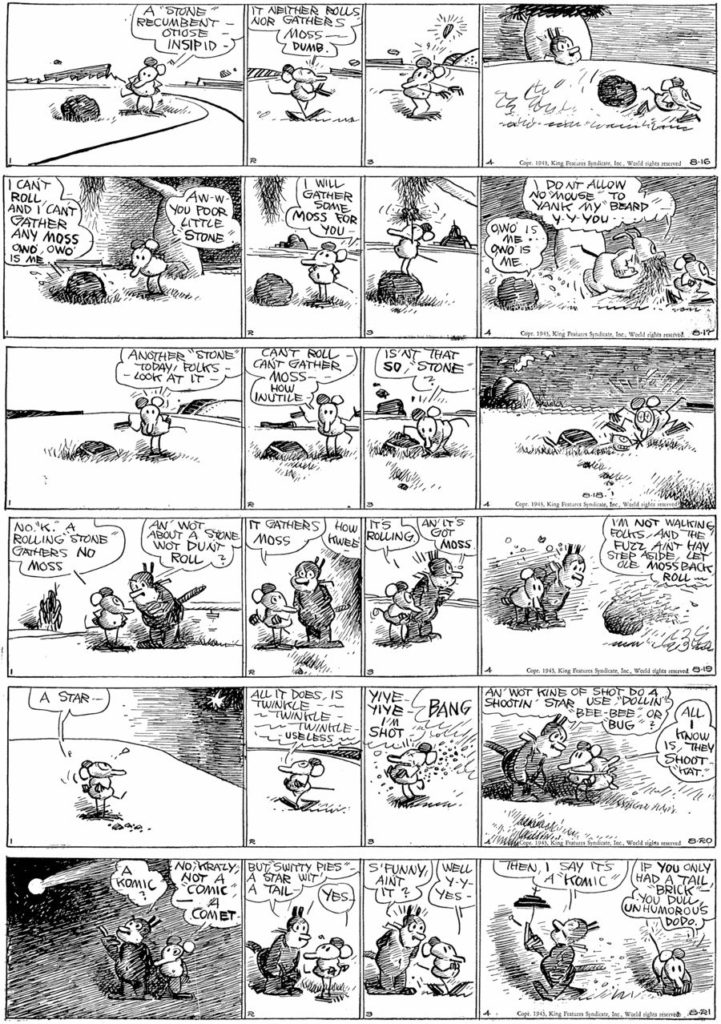
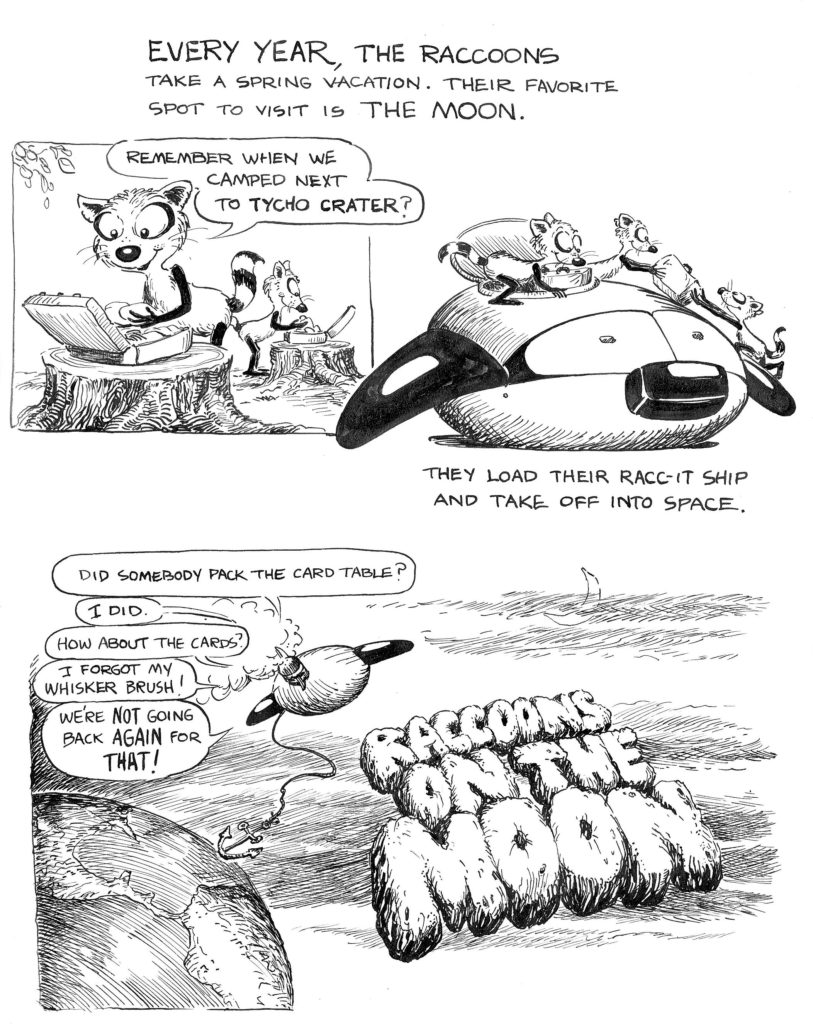
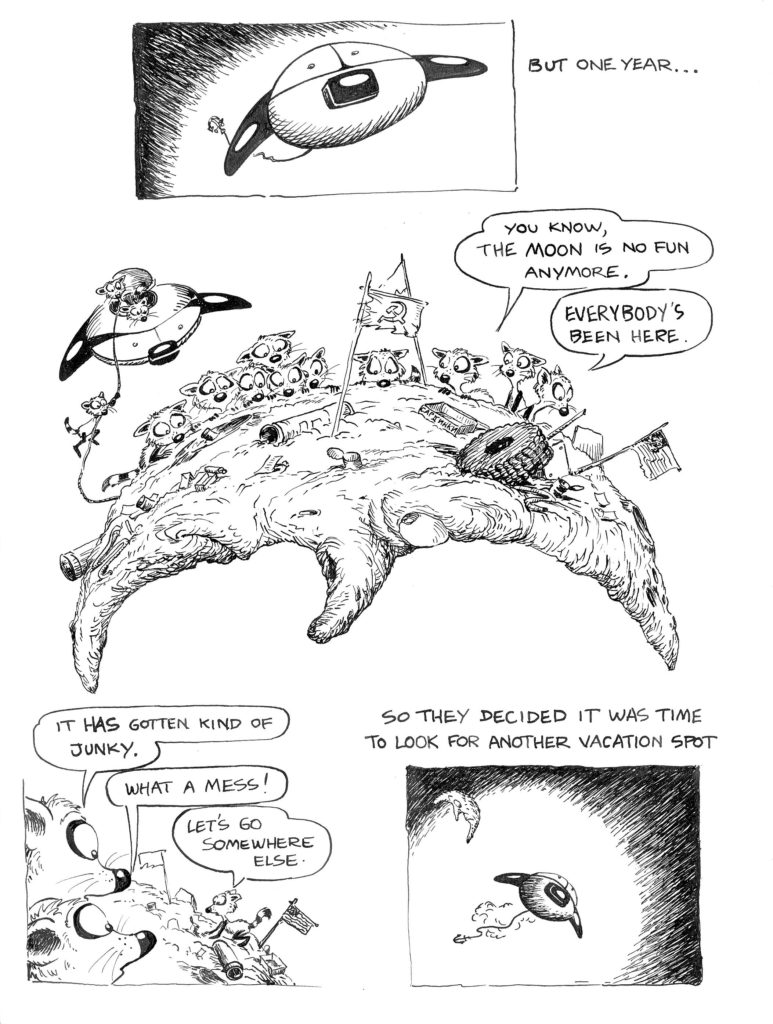
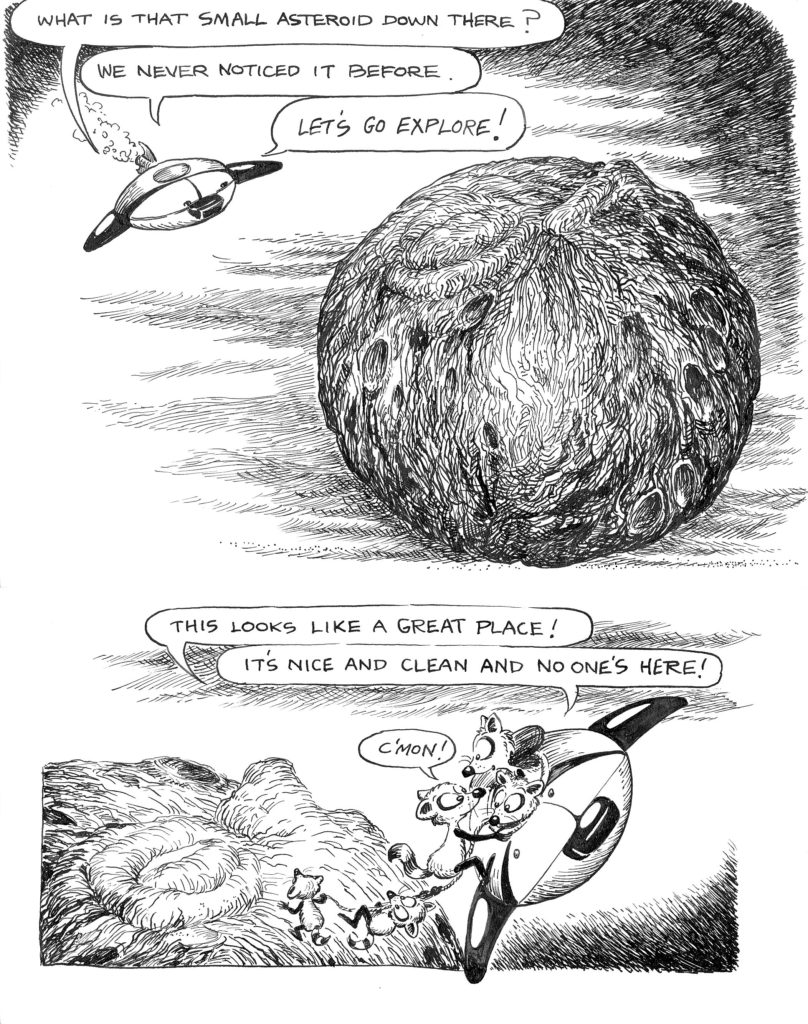
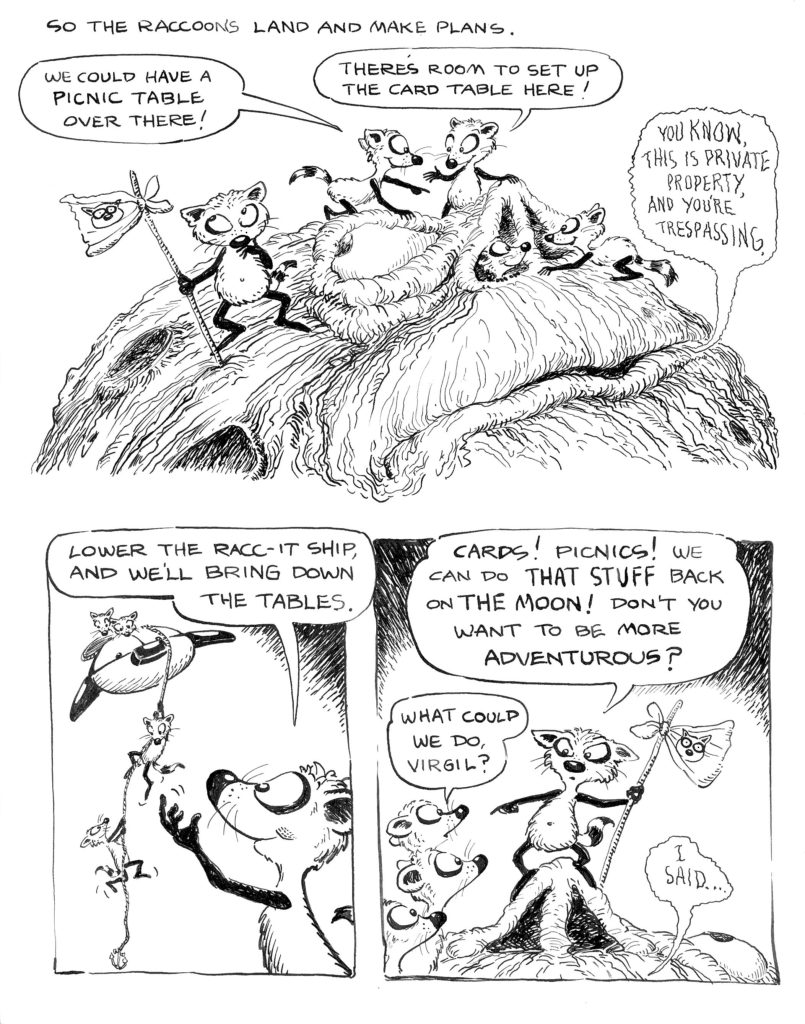
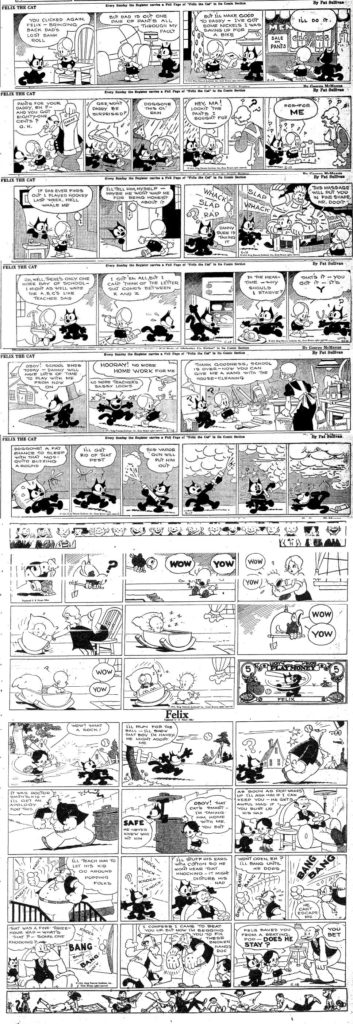
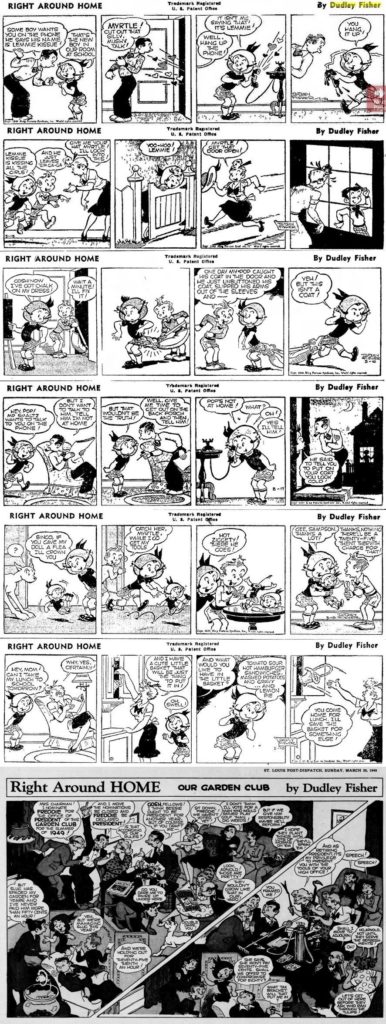
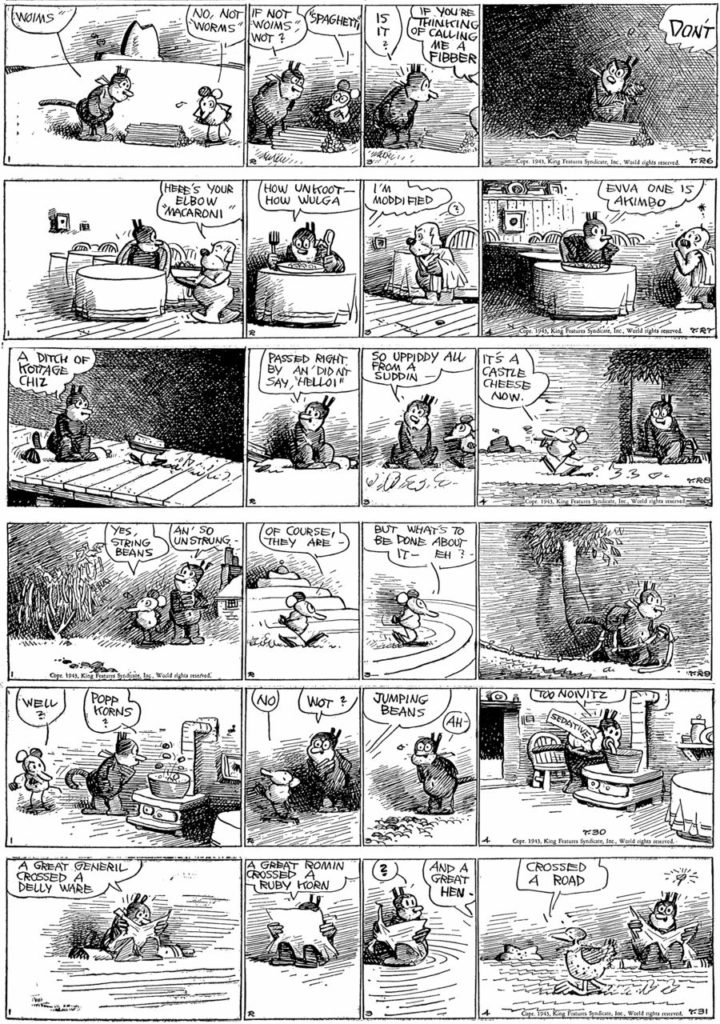

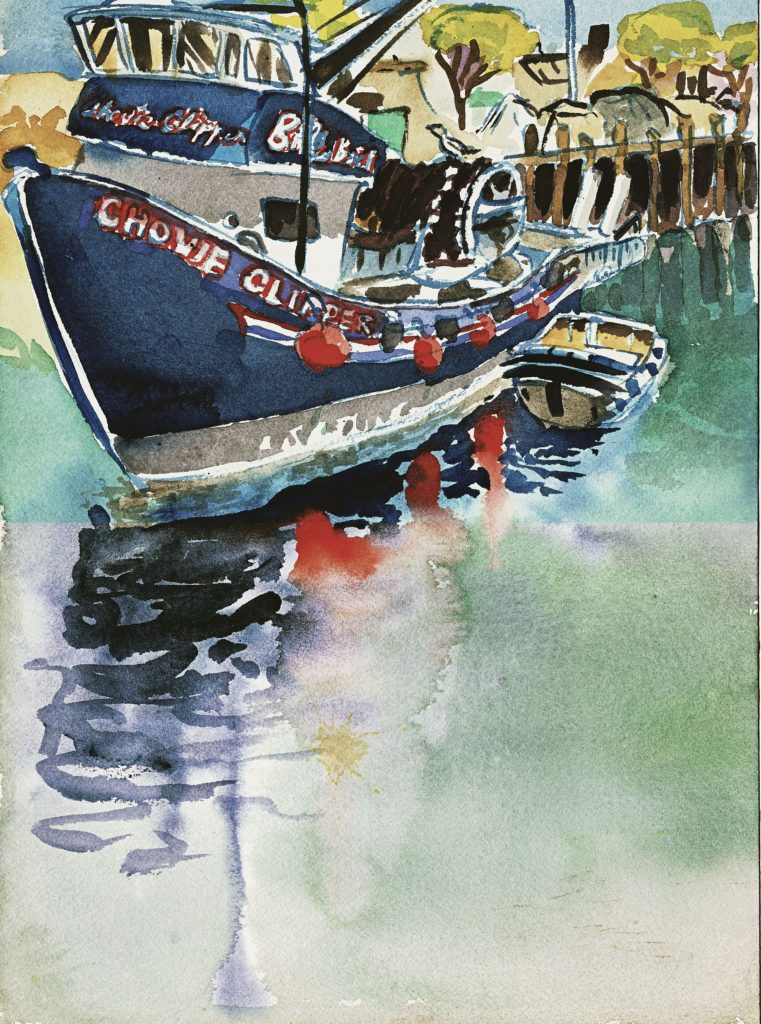

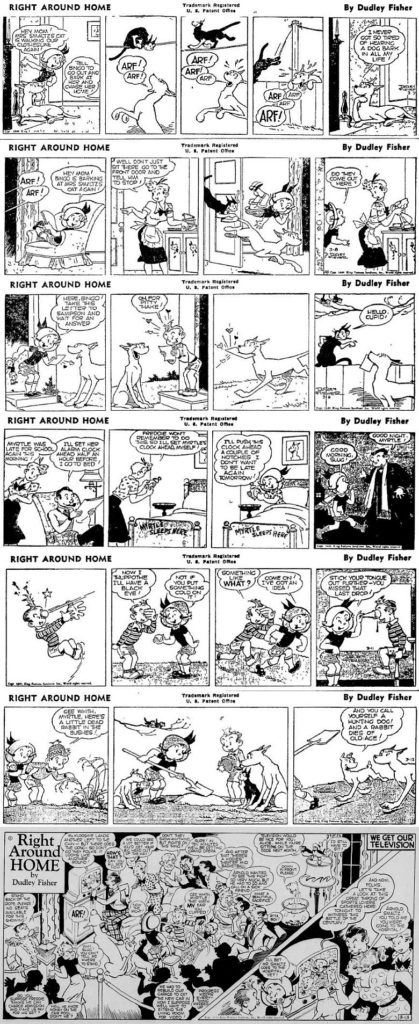
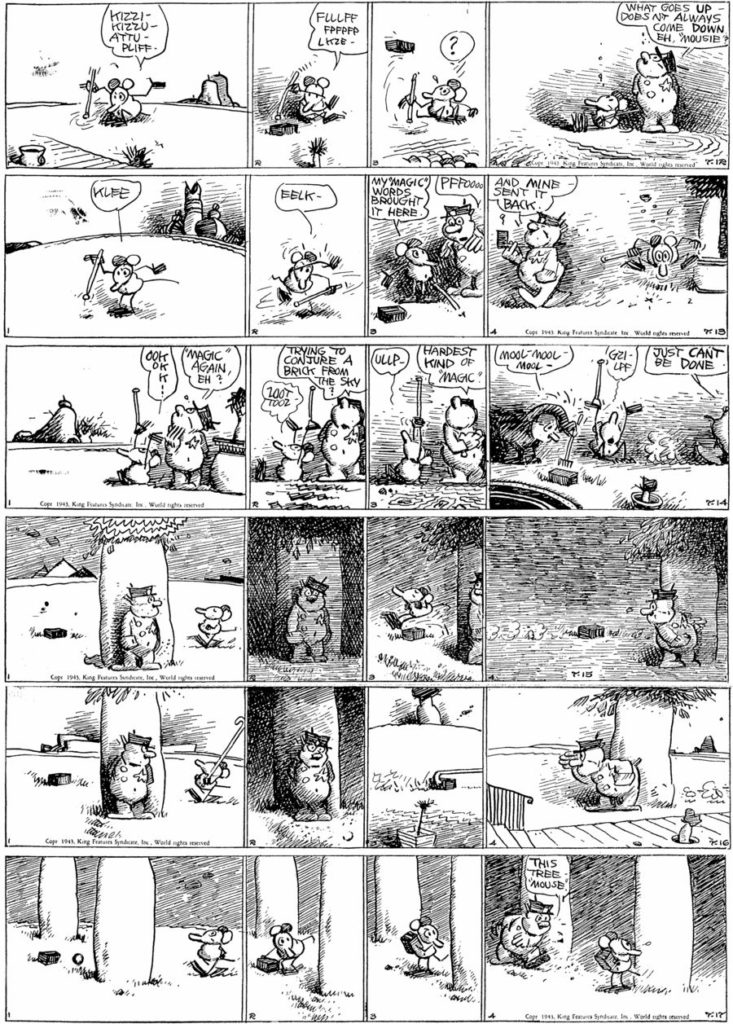
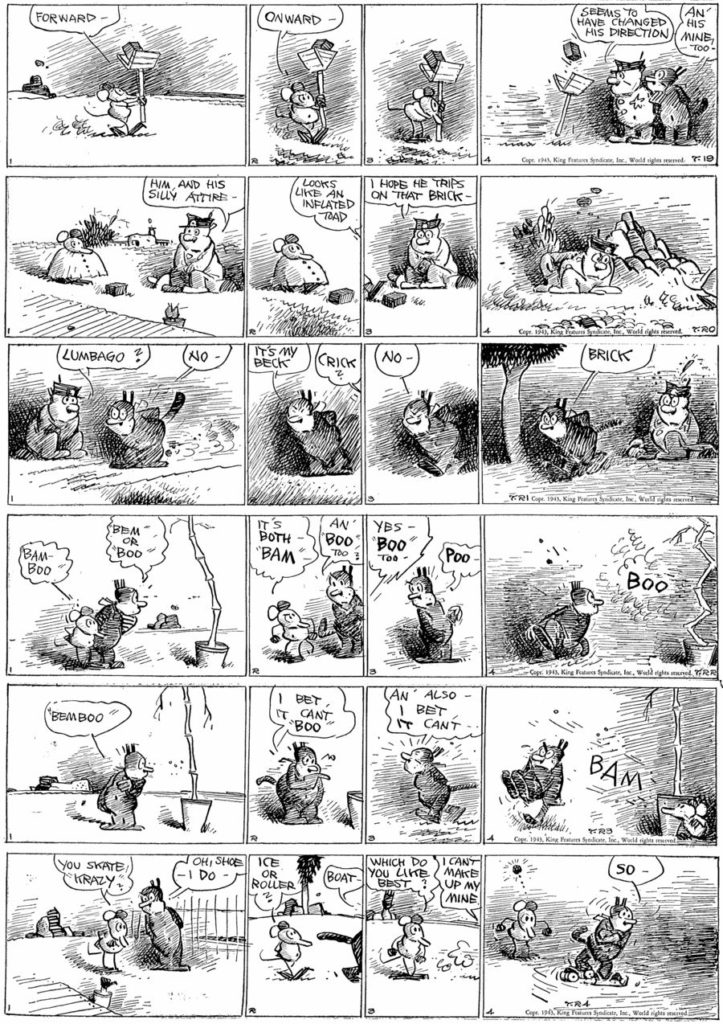

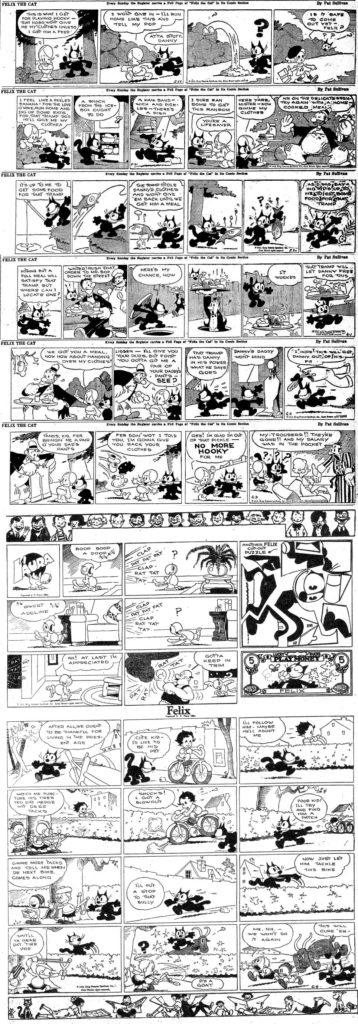
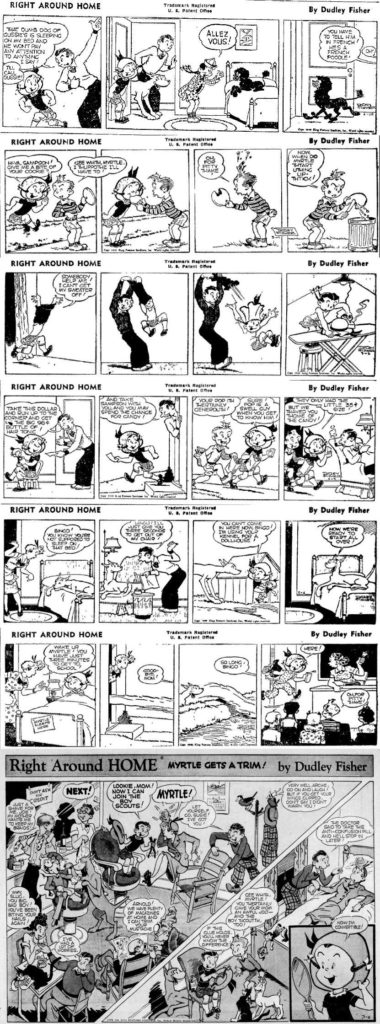

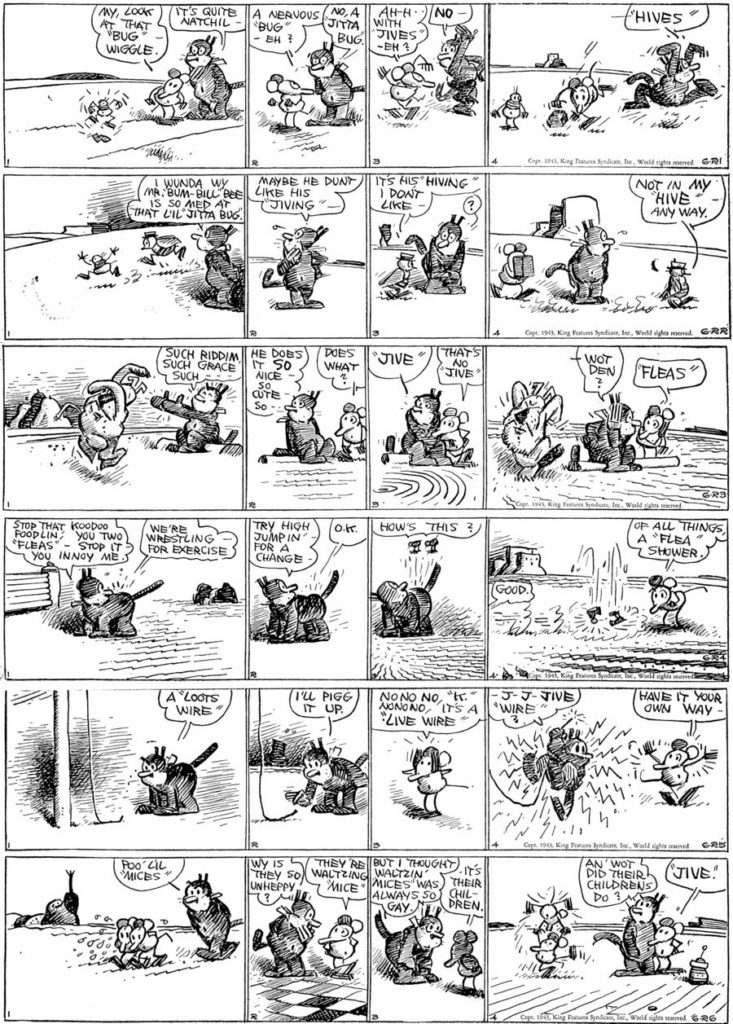
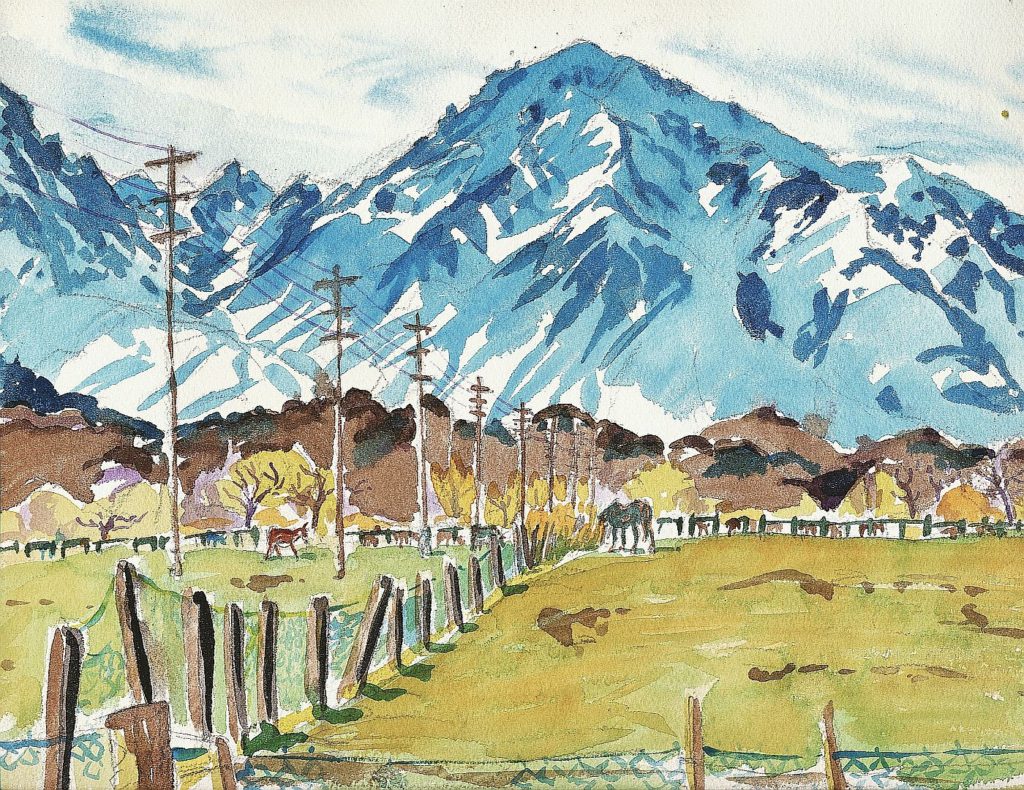
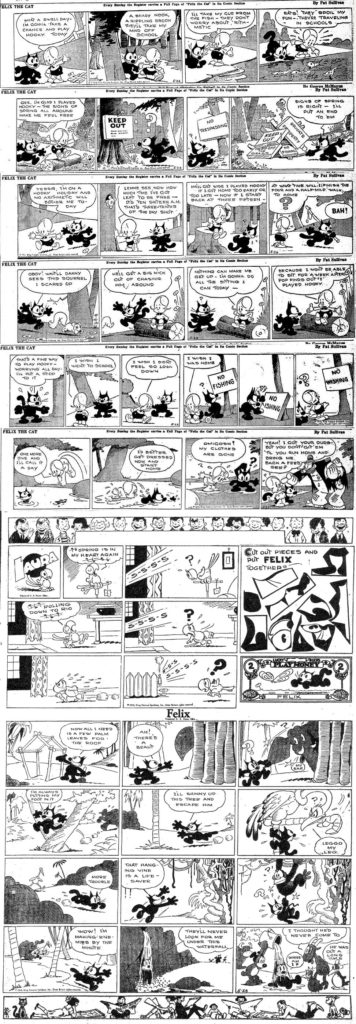
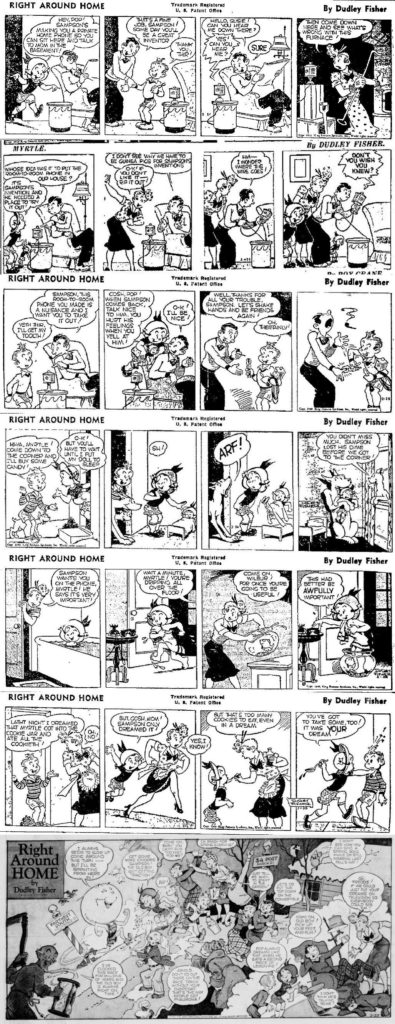
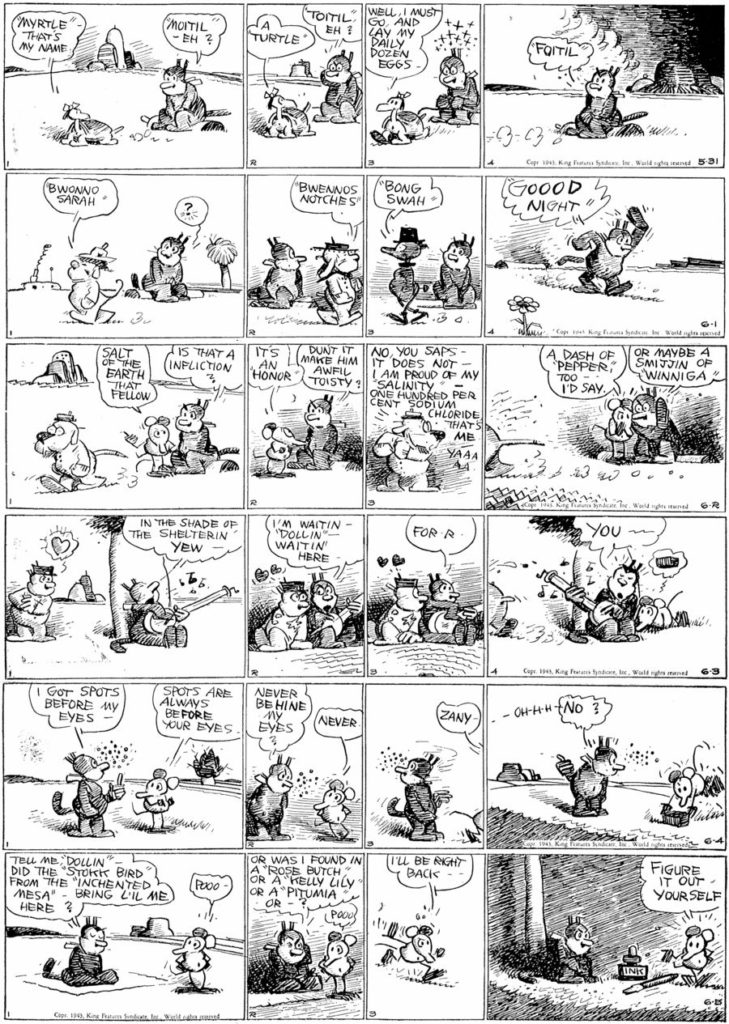
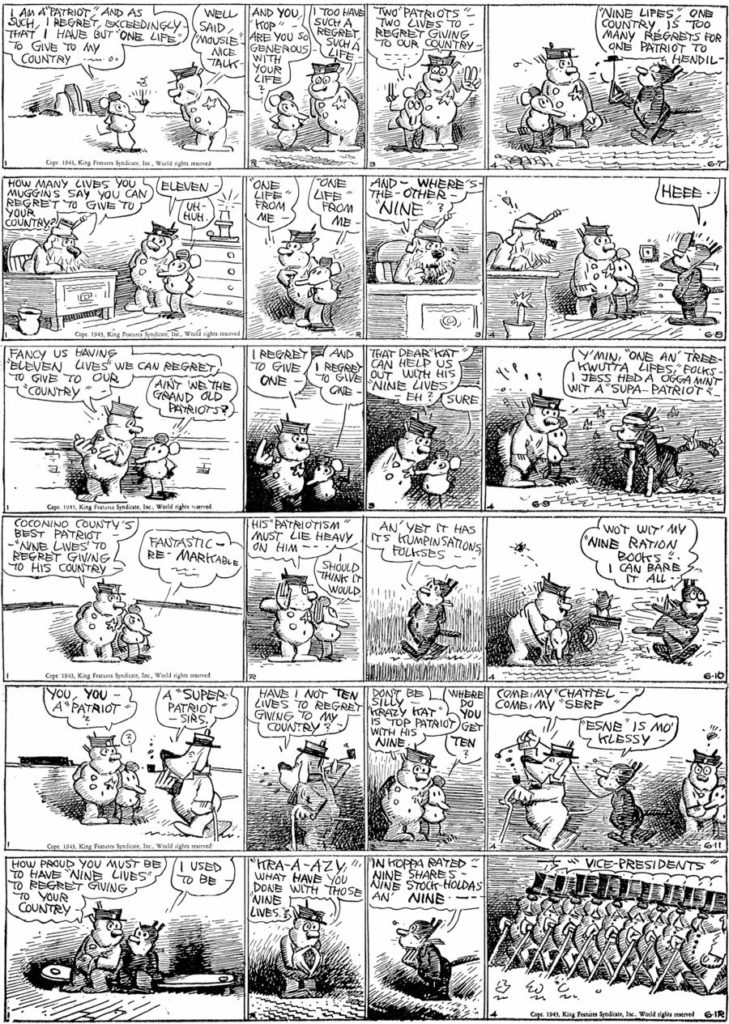
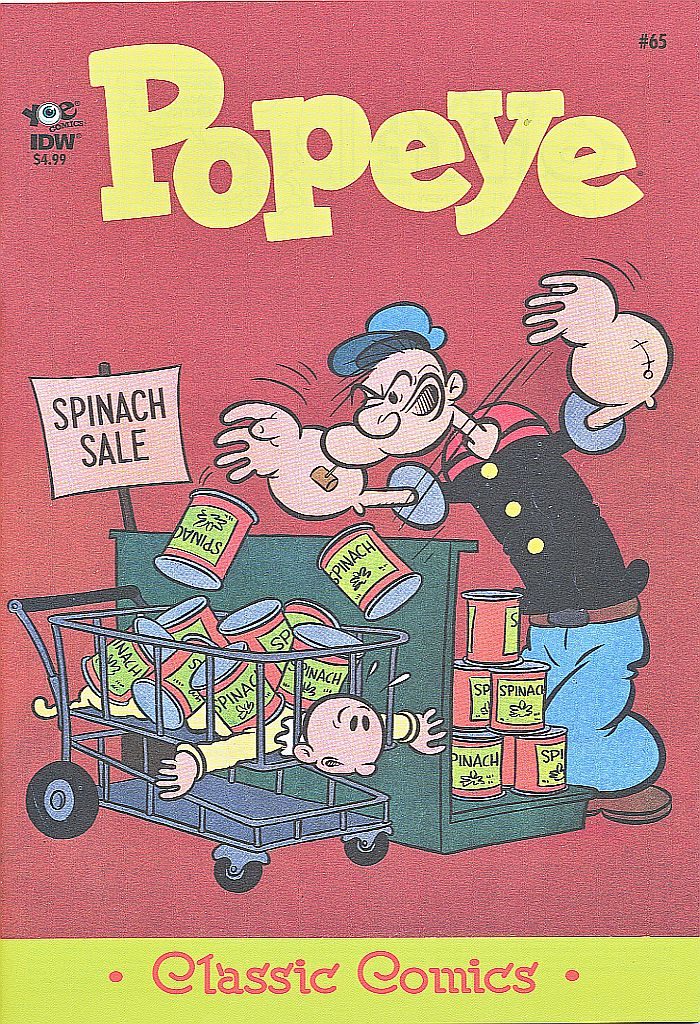
Dino Tears
September 18, 2019
Uncategorized
2 Comments
Mark
Howdy Readers, if you want a quick and easy way to enlarge the pictures on the Catblog, just hold down your “Ctrl” (Control) key and click the + (plus) sign to enlarge and the – (minus) sign to reduce them. Remember to HOLD DOWN the Control key while you are doing this. Enjoy!
Here’s part four of Cathy Hill’s unpublished comic story: “Racketty Ann and The Lost World”. Cathy was truly a prognosticator of our current dilemma, as she attributes the dinosaur’s mortality to the human encroachment of their island. She combines comedy, comment and empathy as she uses comic drawing on pages 14 and 15, and a more sympathetic treatment on page 16. The first panel shows a stegosaurus collapsed in the background while a brontosaur looks after her little one in the foreground. In the second panel, Cathy uses dinosaur tears as a mother tyrannosaur looks over her ailing progeny still in the shell. As you wipe away the tears, enjoy the multiple screens of the videographers on page 14, and the intrusion of the buses, helicopters and motorcycles on page 15. Coming soon, the final chapter of this epic tale.
Felix is from 8-14 to 8-20-1933 this time. Felix saves Danny from the forest fire, much to Papa Dooit’s relief. However, Pop’s money was burned in the fire and he faces financial ruin, but Danny gets a 200 dollar bonus from the logging company for saving their logs, so Papa is rescued. Poor Felix, however, is left out in the rain and seeks refuge in an empty boot. The Sunday page continues the adventures of Felix and Danny at the circus, trying to dry clean a bear!
Myrtle is from 5-16 to 5-22-1949 this time out. In the 5-16, Myrtle looks kind of like a boy in the first panel as she lifts weights, then reverts to looking like a girl as she puts on her hat with the braids attached. She does this to impress “Walton”, a very rich boy who likes “proper” behavior. Myrtle starts to loosen him up by 5-21, as they are both blowing bubbles in their sodas. The Sunday page features a beautiful Fisher layout, as Freddie spray paints Myrtle, Sampson, Hyacinth and even the little Myrtle doll, much to Susie’s horror.
Â
Krazy, from 11-29 to 12-11-1943, is mostly non-continuous gags this time, I like the reference to Kayenta, in the 12-7, and the feline subtext in the 12-10, as Krazy “puts the light out” by placing the lamp on her back porch, in a beautiful panel using intricately cross-hatched blacks to reveal Offissa Pupp’s bewilderment. You will note that the 12-4 to 12-11 strips are a bit taller, that’s because I got them from the San Francisco Examiner, which was one of the few papers to run the Krazy Kat strip in the 1940s, and probably the only one to run the full panels as Herriman drew them. Again, these panels show the little Coconino theater that Garge imagined, the little stage with the floorboards exposed, like in the 12-8 and 12-9. The KFS files don’t have the un-edited panels, but you will see them here in the Catblog!
Kurt’s Corner
Here are more stills from my late brother’s library and his extensive files on Clark Gable. I chose these because they feature Mr. Gable’s checkered career on network radio. This one features Clark and Virginia Bruce performing the Oscar-winning motion picture “Cimarron” on the Lux Radio Theater, 9-26-37. Cimarron won best picture in 1931, and was the only Western which achieved that honor until “Dances With Wolves” in 1990.
From that same year, 1937, here’s Clark on NBC, probably the Chase and Sanborn show, with Edgar Bergen and Charlie McCarthy. This would have been for the 10-17-37 broadcast, featuring the Stroud twins. This program still exists! Do a search for it.
I’m not sure of the exact date of this great photo of Mr. Gable, but it is probably pre-World War 2. Clark seems to be very happy in this shot, maybe he enjoyed performing on radio, no make up necessary!
And last but not least this time, a rehearsal shot from the Burns and Allen show of 11-21-46, even though the photo is dated 11-26. This was Clark’s first network radio appearance since his World War 2 service, and he seems happy to be performing again. Sadly, this show has not survived, but maybe a collector has it on a reel to reel tape somewhere. “The Hucksters” was Gable’s second MGM film after his return, and he didn’t like the novel the screenplay was based on, saying “It’s filthy and it isn’t entertainment.” Read more about the picture here.
Â